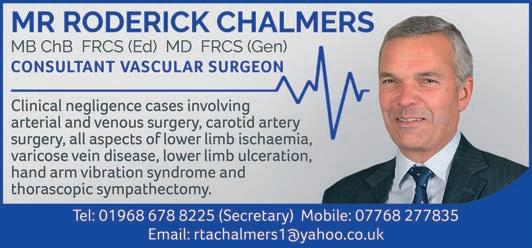













9 Experts call for SRA intervention in disputes with solicitors 9 Complaints body calls for more effective sanctioning of erring solicitors
11 Meeting of experts – solicitors get it wrong again!
13 Bank’s analysis shows extent of Oasis ticket fraud
14 National Trust finds signs of hope at Sycamore Gap
15 Money doesn’t grow on trees, so how do we value them? FIRE
16 Govt vapes measure draws plaudits from fire chiefs and councils
17 Guidance reflects complexities of fire risks
THE OIL & GAS INDUSTRY
19 Well infrastructure become clear at the TWIST of a database
PROPERTY, CONSTRUCTION & ENGINEERING
21 NAO reports on cladding remediation progress
23 Young engineers: infrastructure leaders too slow to adopt new tech
23 Planning reform must include people at its heart
CONTRACT DISPUTES
24 The value of expert advice in contractual disputes
TRANSLATING & INTERPRETING
25 Lords probe ITS in the courts
25 Linguists flag up use of AI translation in public sector
FORENSIC ACCOUNTANCY
29 So who values shares and businesses?
31 New figures reveal increase in detected insurance fraud
33 Accountants’ body publishes AML report
33 Corruption probe launched into defence giant
33 Three charged following PPE fraud investigation
PROBATE
34 CMA issues guidance for unregulated will-writing and probate services
A to Z guide to the websites of some of the country’s
witnesses.



40 CQC to implement changes following critical reports; Dilks to depart as chair
43 Doctors’ body attacks govt on associates review
43 APPG formed to champion patient safety
45 Training overhaul needed to avoid waste of doctors’ talents, GMC says
47 Report details lead exposure among children
47 Scottish lawyers call for changes to proposals for new legislation
49 Series of appeals prove fruitless for former soldier
49 Claimant ‘fundamentally dishonest’, judge rules
BREAST SURGERY
50 Research scientist finds time for charity work
50 Starving cancer cells is a novel way of killing them
MEDICAL DEVICES
51 Why commercial expertise matters in medical device litigation
ORTHOPAEDICS
53 Cervical spine injuries: a medico-legal perspective
55 What makes a longer-lasting hip?
55 Orthopaedics and MSK must take centre stage to achieve Plan for Change
57 Cracking the case: negligence in missed neck of femur fractures
59 Report details the three steps to recovery from hip fracture
LAPAROSCOPIC SURGERY
61 What are the dangers of laparoscopic surgery?
UROLOGY
63 Men don’t know where their prostate is – or what it does!
63 Home dialysis elicits better outcomes, charity avers
OBSTETRICS & GYNAECOLOGY
65 Pre and perinatal bereavement recognition to be extended
65 RCOG report shines light on crisis in gynaecology services
66 New animation helps explain caesarean birth consent
HEARING LOSS
67 Prompt treatment essential for sudden hearing loss, research finds
NEUROSURGERY & NEUROLOGY
69 Trial targets brain tumours with DNA-tailored treatments
71 Who manages rehabilitation following a brain injury?
NEUROPSYCHOLOGY
72 Study finds half of domestic abuse victims suffer brain injury
73 Assessment and treatment of PTSD after brain injury
PSYCHIATRIC & PSYCHOLOGICAL ISSUES
75 New Bill gets two cheers from mental health bodies
76 Assisted Dying Bill divides psychiatrists
77 Family Court: experts gather in Cardiff
79 Rethinking ADHD: essential insights from an expert
DENTISTRY & MAXILLOFACIAL SURGERY
81 Successful pilot leads to improved timelines for dental investigations
81 Scotland’s ‘dental desert’ reveals work yet to be done
OPHTHALMOLOGY & OPTOMETRY
85 National strategy for ophthalmology in Wales launched
85 Why I became an expert witness in ophthalmology
87 Laser eye specialists warn of dangers of diabetic eye conditions
87 Parliamentarians hear from optometrists on risks of phone use
PLASTIC, RECONSTRUCTIVE & HAND SURGERY
89 BBL-linked death leads to renewed calls for regulation
91 Most ‘cosmetic tourists’ regret going abroad for procedures
91 Plastic surgery museum goes online
EMERGENCY MEDICINE
93 Emergency doctors dread winter, as 12-hour waits soar
VASCULAR SURGERY
95 Pain in the arm from thoracic outlet syndrome
CARDIOLOGY




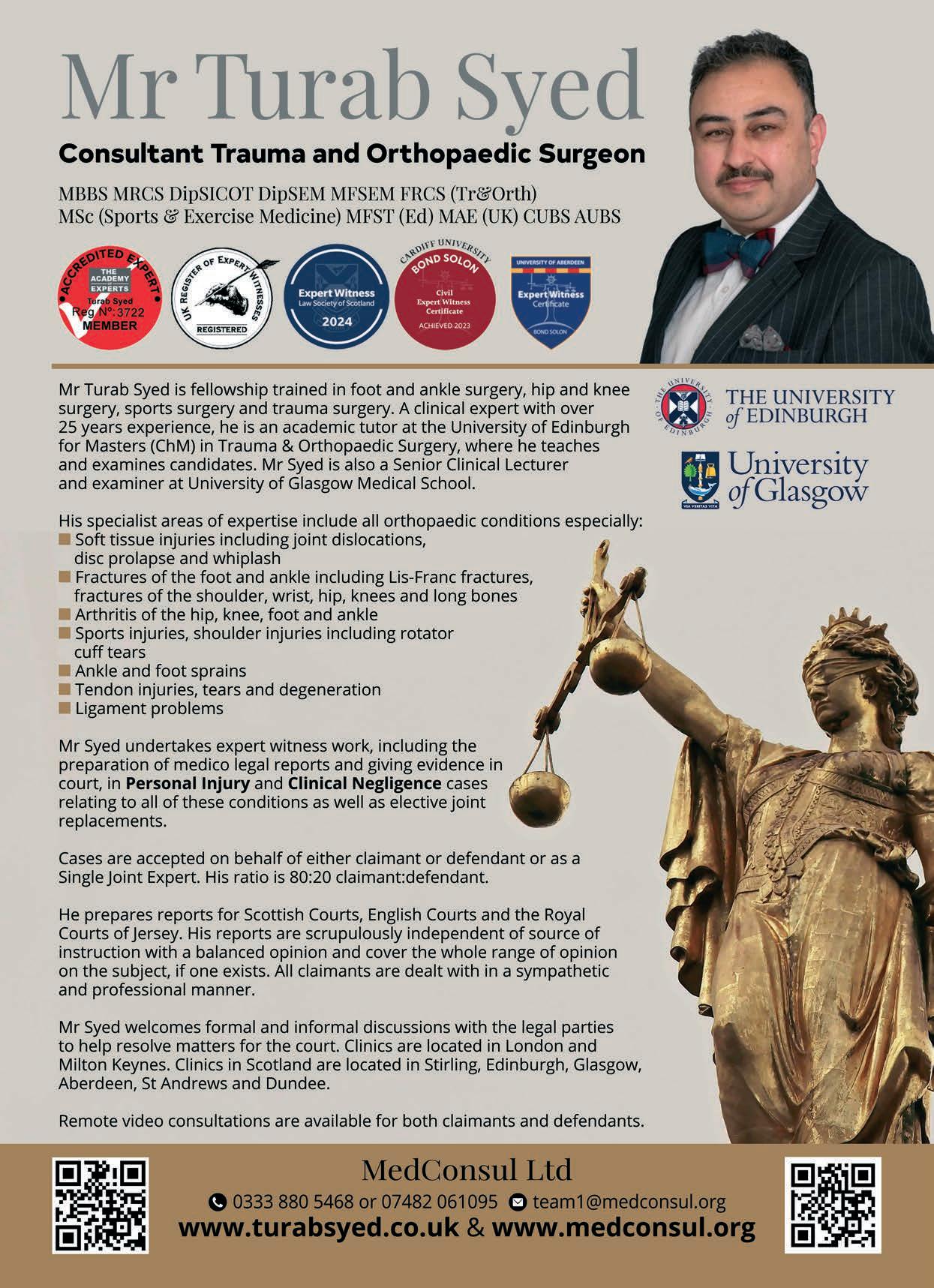
[ AS WE APPROACH the end of the year the 2024 Survey of Expert Witnesses has been carried out by Bond Solon – the leading trainer of experts. This year, among the subjects covered was a bubbling over of frustration among experts with the lack of redress when problems arise with solicitors.
Over the years this publication has been reporting on the relationship between experts and solicitors, and the two major issues have been interference and – more frequently – late payment. Not surprisingly, those were two issues that were brought up by respondents. Many felt that there should be a role for the Solicitors’ Regulation Authority in disputes with experts.
• The issue of solicitors interfering in the writing of an expert’s report is also addressed by regular contributor Chris Makin. He cites a brace of cases where many thousands of pounds have been wasted on experts’ reports because they have been the subject of interference. Both parties should have known better.
In Scotland, meanwhile, solicitors’ behaviour has also been the subject of debate. In that case the Scottish Legal Complaints Commission expressed frustration at the lack of redress it has when solicitors who are being investigated following complaints simply don’t co-operate.
• The disputes that experts become involved with should not be over their own relationships with solicitors. Their expertise is essential when dealing with a range of disputes between parties where sometimes large amounts of money are involved. In particular, contract disputes often require an expert’s eye to resolve. Even the best written contracts can sometimes give rise to unexpected differences of opinion; and that’s where the expert comes in.
When it comes to valuing a business, or shares, the expert’s experience is equally invaluable. While there is no formal qualification for valuing businesses in the UK – as opposed to the US, for example – there is a body of expertise in such matters who can demonstrate competence and experience in such matters. It pays to do your research.
• A more sinister field of financial investigation is that of fraud. Fraud takes many forms, and the Serious Fraud Office has reported a number of successes of late. Perhaps the most widespread fraud, however, is insurance fraud. From the inflating of the value of a claim to outright invention of events, the insurance industry is constantly evaluating its losses to fraud.
This year the Association of British Insurers reports a 4% increase in detected fraud in 2023 over 2022. It amounts to a staggering £1.1bn. Motor claims form the largest single category of fraud, at £501m.
The publication of the figures follows a campaign to raise awareness of fraud and its possible consequences. That raises the question of whether fraud has become more prevalent or the industry has become more adept at detecting it.
• Detecting another kind of financial crime – money laundering – is one of the tasks of chartered accountants. The Institute of Chartered Accountants in England and Wales carries out checks to ensure compliance and issues an annual report. Last year, of the 1,088 monitoring visits, only 39 resulted in firms being sanctioned. Those 39 were fined a total of £92,025.
A high-profile scam was that associated with the sale of fake tickets for the much-hyped reunioin tour of Oasis. An analysis by Lloyds showed the extent of the fraud and the average amount lost in each fraudulent transaction.
• On a more optimistic note, the National Trust has reported signs of growth around the stump of the Sycamore Gap tree, which was felled in an act of vandalism in September 2023. It seems particularly apt to report this news as we approach the festive season and many of us are decorating trees of our own. So I'll leave you with wishes for a Merry Christmas and a Happy New Year. q
Ian Wild, Director of Business Development Your Expert Witness





[EXPERT WITNESSES are calling for the Solicitors Regulation Authority (SRA) to get involved when they clash with solicitors over matters such as pressure to ‘improve’ an opinion. They also want instructing solicitors to be subject to a specific obligation to ensure their experts understand their duty to the court.
Those were among the headline findings of this year’s Expert Witness Survey, produced by expert trainer Bond Solon in association with The Gazette
Of some 537 experts canvassed, over 90% thought there should be a specific process for experts to notify the SRA of problems between experts and solicitors.
“There is provision within the court rules for the expert to go to the judge in a matter, but the SRA could play a bigger part,” the report says.
This year’s report comes amid renewed scrutiny of the reliability of evidence given by experts, in light of the Lucy Letby trial and the Post Office Inquiry.
Though the duty of the expert is to the court and not the paying party, so-called ‘hired guns’ who align with their paymasters remain ubiquitous. Over a third of survey respondents said they had come across an expert in the past year who fell into this category. One in five had encountered an expert who they felt was compromised by a conflict of interest.
Bond Solon’s Paul Rogerson described the situation in a subsequent
article as: “Still too many ‘hired guns’, but not quite the Wild West”.
“Clearly, when exercising due diligence in the selection of an expert, solicitors must make sure that there are no conflicts of interest arising,” the report counsels.
Experts overwhelmingly felt there should be stronger sanctions against solicitors who intentionally lead experts to breach their duty to the court. Regarding the call for a specific duty on solicitors to ensure instructed experts are aware of their obligations, the report stresses that that would need to be required by appropriate court and professional rules.
Experts quoted in the report also slammed solicitors for what one described as an ‘institutional refusal’ to follow agreed terms of engagement and pay up on time.
“Some agencies and solicitors are poor payers,” said another expert. “There should be a reporting system for this.”
On fees, nearly two-thirds of experts said they were charging the same rates as 12 months ago.
Commenting on the report, Bond Solon founder Mark Solon, who also chairs Wilmington Legal, said: “It may be time now for the SRA to introduce specific regulations to improve the professional relationship between experts and solicitors. It would also be helpful if the SRA provided specific regulations regarding solicitors exercising due diligence in the selection and instruction of experts.” q
[THE Scottish Legal Complaints Commission (SLCC) has renewed its call for a better solution to deal with solicitors unwilling or unable to comply with their regulatory duties.
It follows a court hearing in which a solicitor was questioned on why they had not provided timely access to a file needed to investigate a complaint, despite numerous requests and reminders – and ultimately a court order. It was the second time this year that the individual solicitor had appeared before the court in relation to such a matter.
Once more the Inner House stopped short of finding the solicitor in contempt of court, despite saying: “The troubling picture which emerges is of a practising solicitor who has consistently failed to respond properly to the regulator responsible for service complaints.”
The call for a different approach was echoed by Lord Pentland, in the chair, who said it was “absolutely extraordinary that the Inner House of the Court of Session should have to be involved in this matter” and “concerning that the tools we have at our disposal seem to be limited”.
Commenting on the case, the SLCC’s chief executive Neil Stevenson said: “We appreciate the strong words from the court about the importance of complying with the SLCC’s requests and Lord Pentland’s comments that our approach to seeking and pursuing files is entirely appropriate. We are also pleased that the court awarded us expenses to mark its disapproval of the solicitor’s conduct.
“However, none of this addresses the core issue which is the significant number of solicitors who fail to respond adequately to our requests for information, delaying the consideration of complaints, leaving their clients in limbo, and causing significant additional cost to the regulatory system paid for by their peers.
“Nor does it deal adequately with the concerns about whether such a failure – and the evidence led in defence of these failures – raises questions about practitioners’ abilities to meet their professional duties.
That has significant implications for public protection.
“It will seem staggering to many that multiple clients’ complaints have been ignored; there have been multiple failures to respond to the SLCC, multiple failures to respond to court orders, tens of thousands of cost to the profession – and yet no regulatory action has been taken to protect the public. The current system is letting the public and the profession down.
“If the tools available to the court – and the SLCC – are not felt to be adequate to deal with this situation, then we believe the time is right for a discussion about the tools we need. We would welcome the court’s support in finding a better, less costly and more productive solution for dealing with this concerning matter.” q


By CHRIS MAKIN chartered accountant, accredited civil mediator and accredited expert determiner
[ MY LOYAL READERS will know that I often bang on about incompetent experts. There is a treasure trove of articles on the shocking failure of some experts in my blog chrismakin.co.uk/blog/ But we should also be alert to the blame which should attach to solicitors who get it wrong.
Most expert witnesses are not full-time experts; indeed, many believe that a witness cannot have current expertise sufficient to give expert evidence if he is not active in his main profession. And I have spoken before about the need for those who wish to give expert evidence to learn how to do it properly. For an accountant, expert witness work is not merely a sexy infill between audits.
But for litigation solicitors there is no excuse. Their main profession is litigation so they must know the rules and, of course, make sure that those they instruct as experts follow them, too.
I wrote recently about the case of Patricia Andrews & Ors v Kronospan Ltd [2022] EWHC 479 where an expert delivered a joint statement of experts to the court more than two years late. It emerged that he had conferred with his instructing solicitor some 69 times for help on drafting his joint statement.
He should have known better. The judge decided that the expert had no regard for their independence. The report was withdrawn and the judge allowed another expert to be appointed. But the first expert had charged £225,000 which was wasted, and there would no doubt also be a costs order against that party.
But what about the solicitor in all this? The expert should have known better than to turn repeatedly to the solicitor for help, but the solicitor should have known – must have known – that he should not reply when the expert asked. Who paid the £225,000 plus any costs order I don’t know, but from what is reported it surely shouldn’t have been the client.
Now it’s happened again. Glover v Fluid Structural Engineers & Technical Designers Ltd [2024] EWHC 1257 (TCC) was a case about damage to adjoining property, and it required expert engineers to find out what had happened and assist the court to decide whose fault it was.
The defendant became suspicions when the claimant’s expert appeared to have changed his opinions as the joint statement was being compiled. A series of questions were posed of the claimant solicitor, who gave assurances that nothing untoward had happened.
Then, when the claimant solicitor was asked whether any instructions had been given regarding the substance and the wording of the draft statement and whether the expert had been asked to change his opinion, there was no reply. This was highly suspicious.
The TCC Guide is quite specific about what help a solicitor may give to their expert in joint reports. Here is the relevant wording from paragraph 13.6.3:
Whilst the parties’ legal advisors may assist in identifying issues which the statement should address, those legal advisors must not be involved in either negotiating or drafting the experts’ joint statement. Legal advisors should only invite the experts to consider amending any draft joint statement in exceptional circumstances where there are serious concerns that the court may misunderstand or be misled by the terms of that joint statement. Any such concerns should be raised with all experts involved in the joint statement

This could not be plainer. The lawyer must not be involved in drafting or negotiating the experts’ joint statement. Only in exceptional circumstances where the court may misunderstand or be misled by the statement should they intervene – and even then they must communicate with all the experts. Cosy chats between one lawyer and their expert is verboten!
So what happened? The claimant lawyer apologised to the defendant and to the court, accepted that permission to rely on their expert’s opinion be revoked, and asked permission for a new expert to be appointed. The judge allowed for a new expert, but only if the original trial date could be met.
But here’s the rub. The judge awarded costs thrown away on an indemnity basis and 30% of the costs of considering the new expert’s report and the joint report, again on an indemnity basis if not agreed. That would hurt.
There really cannot be any excuse if litigation lawyers don’t know the rules, or don’t follow them. The expert should never have asked for assistance in drafting the joint statement but, a fortiori , the lawyer should not have given that assistance. And, in line with my repeated entreaties, the lawyer should have chosen an expert who knew the rules and followed them.
Age old moral: choose your experts with care. q
[ CHRIS MAKIN was one of the first 30 or so chartered accountants to become an Accredited Forensic Accountant and Expert Witness –see www.icaew.com/about-icaew/find-a-chartered-accountant/find-anaccredited-forensic-expert
He is also an accredited civil and commercial mediator and an accredited expert determiner. Over the last 30 years he has given expert evidence at least 100 times and worked on a vast range of cases. For CV, war stories and much more go to the website at www.chrismakin.co.uk – now with videos! q



[ FIGURES COMPILED by Lloyds Bank revealed the extent to which fans of Oasis were targeted by a landslide of ticket scams on social media, as the Mancunian rock icons prepared to tour the UK for the first time since 2009.
Analysis by Lloyds of scam reports made by its own customers found there were hundreds of ticket fraud claims in the first month since the reunion was announced, with Oasis fans making up around 70% of all reported concert ticket scams since 27 August.
Victims lost an average of £346, with some cases reaching as high as £1,000. Those aged 35-44 years old were most likely to be targeted by the ticket fraudsters, making up almost a third (31%) of all cases.
Over 90% of reported cases started with fake adverts or posts on social media, with the vast majority originating on Facebook, which includes Facebook Marketplace. A simple search of Facebook reveals numerous unofficial groups have been set up, many boasting tens of thousands of members, dedicated to buying and selling tickets for the Oasis tour.

As a comparison, when Taylor Swift’s UK tour tickets were released last year, ‘Swifties’ spent quite a bit less on average: £342 on the major ticket site and £518 on the resale site. q
That is despite Meta’s own commerce policy stating that the sale of concert tickets is ‘not allowed’ on the platform.
Liz Ziegler, fraud prevention director at Lloyds, said: “Predictably, fraudsters wasted no time in targeting loyal Oasis fans as they scrambled to pick up tickets for next year’s must-see reunion tour. The fact that so many cases start with fake listings on social media, often in violation of the platforms’ own rules, underscores the importance of these companies taking stronger action to tackle scams.
“Buying directly from reputable, authorised platforms is the only way to guarantee you’re paying for a genuine ticket. If you’re asked to pay via bank transfer, particularly by a seller you’ve found on social media, that should immediately set alarm bells ringing.”
Purchase scams happen when someone is tricked into sending money via bank transfer (also known as a Faster Payment) to buy goods or services that don’t exist. Ticket scams usually involve fake adverts, posts or listings on social media, offering tickets at discounted prices or access to events which have already sold out at inflated prices. Victims are asked to pay up-front for the tickets, but once the payment is made, the scammers vanish.
When tickets for an event are scarce, fraudsters take advantage of eager fans willing to pay more by falsely claiming to have tickets available.
Scams often occur in two waves: first when tickets are released for sale, and again as the event date approaches.
Data analysed by Lloyds reveals that, on the day Oasis tickets went on sale, customers spent an average of £563 per debit card transaction on one of the UK’s biggest ticket selling sites.
If that doesn’t sound expensive enough, on the same day ticket hunters spent an average of £909 on a popular UK ticket reselling site.
Oasis drew the highest average spending on tickets among similar events over the past three years.

[THE NATIONAL TRUST has issued an update to the condition of the site of the Sycamore Gap Tree, which was felled ‘in an act of vandalism’ in September 2023.
The trust said: “We were shocked and saddened when the famous Sycamore Gap Tree, at the UNESCO World Heritage Site Hadrian’s Wall and Housesteads Fort, was felled. We know we share these feelings with thousands, if not millions, of people around the world who felt a special connection with the tree and its landscape.
“The response to the felling of the tree over the past year has been overwhelming, and we are grateful for the thousands of ideas, offers of help and tributes we've received. It is clear this tree was special to many, many people. Thank you to everyone who got in touch.”
Building on public feedback, the National Trust, together with Northumberland National Park, Historic England and Hadrian’s Wall Partnership, have created a series of initiatives designed to mark the legacy of the
tree and engage communities at a local and national level. People can request one of the Sycamore Gap saplings in their Trees of Hope initiative, in which 49 saplings – one to represent each foot of the height that the tree was at the time of felling – will be gifted to communities around the country.
People from around the UK are invited to apply for a tree to plant in a publicly accessible spaces, which have emotional connections with people and communities.
The National Trust has expressed itself ‘delighted’ that Sycamore Gap is showing signs of regrowth. Growing from the base of the stump, 25 new shoots have emerged giving hope that the tree lives on.
While it’s early days, the NT and Northumberland National Park Authority are hopeful that, if left to grow, the new shoots could develop significant new growth to form as ‘new’ trees around the original stump.
The trust said: “Our aim is to leave all of the shoots to grow for a few years – to see how

they develop. In time we’ll be able to decide how to manage the tree – as a coppiced stool or considering whether to reduce to a single tree at some point in the future. We’ll also do what we can to protect the root zone, and to avoid any compaction.
“The next few months are vitally important for the success of these shoots forming into the reinvigorated tree. We respectfully ask that any visitors to the site keep away from the stump and to not touch the shoots.”
The National Trust and Northumberland National Park Authority will continue to monitor the growth of the shoots and have fenced the site to ensure the tree roots are protected. q

By Mark Chester, of Cedarwood Tree Consultants
[THERE IS A TELEVISION COMMERCIAL in which the viewer is shown a selection of scenes from life we would generally value: the birth of a child, a family wedding, a graduation etc. We are then told that: “Some things in life are priceless. For everything else, there’s Mastercard!”
Similarly, some trees are special; but how do we allocate a value to them? A mature beech tree in a village green; a substantial London plane in the middle of the City; a fine cedar of Lebanon in the grounds of a large house: some are important to those who own or cherish them.
It is possible, when required, to allocate a value to even the most treasured of trees. It is a skill I apply to a range of circumstances, from a homeowner seeking to restore lost screening to someone trying to comprehend the irreparable damage to a tree of personal significance.
The starting point with any claim is to establish what the claimant is seeking, and how realistic that is. When the damaged or lost tree can be replaced we have a straightforward formula we can apply, which I have used on numerous occasions. It provides simplicity in the calculation and a sound basis for a defendable claim.
When a tree was very large we can use a calculation based on the size of the trunk of the tree that was lost. That includes making an allowance for how prominent the tree was and its condition. A healthy tree is regarded as being more valuable than one in decline or with damage.
Some elements of a claim can be difficult to quantify, such as emotional connections. That can include a tree planted by a now deceased family member or being the place where the ashes of family pets were placed. The tree as a biological feature can be valued, but the emotional element is often priceless.
excellent condition before the damage. That was the case for one site where the claimant had a mature conifer hedge to screen the fields beyond their garden. The side of the hedge fronting the field was damaged when accidently cut by an agricultural hedge trimmer. The claimant sought for a replacement conifer hedge. The hedge had gaps in the garden side where some plants had less vigour and the new hedge would provide an improved screen. The settlement allowed for that.

In making and evaluating claims, one needs to ensure the merits and practicality of the claimant’s case. In one case where I advised the defendant, a dozen Leyland cypress conifers which had formed a boundary hedge between two properties had been removed by the defendant, who thought he had the agreement of his neighbour.
The neighbour’s widow began to pursue a claim, based on a quotation from a tree nursery, that included the hire of a crane to lift the substantial replacement trees into place. It soon became obvious that the quotation was based on a desktop appraisal, and the use of the crane would be impractical on the site.
Interestingly, several cases I have investigated have related to sites involving power companies. In one, trees under a power line had been cut back slightly more than was agreed, and some of the trees had subsequently died. A landscape contractor recommended digging up the stumps of the damaged trees and regrading the ground ahead of planting replacements. The contractor seemed unaware that tree stumps are removed using a stump grinder, which leaves a pile of chippings and a small hole and does not require landscape-scale works.
The settlement may not relate to the perceived value of the tree, but to the value of the solution. A local authority was working with a developer on proposals for a site. A horse chestnut within the site was to be retained, but its position was affecting the design layout. A sum of £40,000 was suggested for the developer to pay to the local authority as compensation for the removal of the tree. The funds were used by the local authority to plant 100 replacement trees.
An allowance may be needed when the tree damaged was not in

Trees can be damaged or felled to increase the value of a property. If the tree is subject to a Tree Protection Order (TPO) and the work is undertaken without the consent of the local authority, a valuation of the tree and any increase to the value of the land can be included in the assessment of the claim for damages.
In one case, in Manchester, a yew tree subject to a TPO was badly damaged in order to create a parking space. The fine included an allowance for the value of the parking space, which was deemed to have added about £20,000 to the value of the property.
In another case, in Poole in Dorset, a pine tree in the grounds of a house enjoying coastal views was felled. The compensation included the increased value to the property and the cost of replacing the lost tree with a substantial replacement specimen. The total cost exceeded £170,000!
There is a recognition that properties in tree-lined roads may have a greater value than those in roads lacking trees, and the uplift could be 10-15%. In one case I was involved in, when a tree on third-party land had damaged their garden, the claimant sought compensation of several thousand pounds for each subsequent year until the matter was resolved for ‘loss of enjoyment’.
Trees may be priceless, but in most situations a value can be allocated to enable parties to move on. It is often nuanced rather than scientific. It may not always be a perfect outcome, but we can usually enable clients to move to closure. q

[ THE ANNOUNCEMENT in October that the government is to introduce a ban on single-use vapes has been welcomed by the National Fire Chiefs Council (NFCC).
The organisation’s lead on waste fires, Rob Barber, expressed its response: “Today’s announcement is very welcome,” he said. “Millions of single-use vapes are binned in household rubbish each year, and not only are they bad for the environment, they pose a fire risk in the waste disposal industry.
“We know that battery fires in bin lorries and at waste sites are at an all-time high, with research by Material Focus showing there were over 1,200 in 2023.
“Vapes contain lithium-ion batteries and these can cause fires when crushed or damaged that can be explosive, spread rapidly, reignite and produce toxic gasses, posing a risk to firefighters and people working in the waste industry. The ban on single-use vapes will help to reduce the number of potential ignition sources that enter the waste industry, leading to fewer waste fires.
“A crucial next step would be the introduction of robust product safety standards for the rechargeable vape industry

so that we don’t see people trying to fill the void left by single-use vapes by turning to cheap unregulated products from the global marketplace.”
The NFCC’s response was echoed by a number of local authorities, typical of which was North Lanarkshire in Scotland, which added concerns about disposal of all vapes. Its convener of the Environment and Climate Change Committee, Cllr Helen Loughran, commented: “Sales of single-use
vapes have increased by 400% in the last two years to around 7.7 million every week in the UK, causing significant health concerns and an environmental problem. They are increasingly being dropped as litter on our streets and are causing a fire risk in bin lorries and at recycling centres when they’re disposed of in household bins.
“It is important that people dispose of vapes responsibly by recycling them to prevent damage to the environment.” q

[ THE BRITISH STANDARDS INSTITUTION (BSI) has released its updated fire safety guidance for UK residential buildings: BS 9991:2024. Published on 27 November, the revised code of practice supersedes BS 9991:2015 and features an expanded scope to include residential care homes, the expansion of guidance relating to evacuation lifts and revised height limits for sprinkler installation and single-stair buildings.
The new document BS 9991:2024 Fire safety in the design, management and use of residential buildings – Code of practice can be used across the whole of the UK.
As previously reported by the Fire Protection Association (FPA), the BSI shared its initial insights into BS 9991:2024 earlier in the month, noting that the revised edition would include ‘significant updates’ to reflect the ‘increasing complexity of modern building designs’, as well as the industry’s evolving knowledge and understanding of fire behaviour, materials and fire safety systems.
The ‘fully revised’ standard followed a lengthy consultation process with key stakeholders, with BSI stating that the revisions were “underway ahead of the Grenfell Tower final report publication in September 2024 as part of the normal process of updating and revising standards”.
“While the Grenfell report did not make any specific recommendations for changes to BS 9991, it has of course reemphasised the importance of comprehensive and up-to-date building safety and standards,” the BSI said.
The technical committee responsible for BS 9991:2024 oversees the development of national standards for fire safety precautions in residential and commercial buildings, fire risk assessment and fire risk management systems. The committee reviewed more than 1,800 comments from a public consultation, the FPA reported. q




[ A GROUNDBREAKING ONLINE DATABASE has been launched which will provide vital well insights to make subsea well decommissioning more cost-efficient and provide supply chain opportunities.
The Tree and Wellhead Information for Subsea Tooling (TWIST) database provides access to sought-after data on the make-up of well infrastructure, helping companies plan their decommissioning projects better and quickly locate potentially hard-to-find tools.
The North Sea Transition Authority (NSTA) has developed the pilot version using data on 423 wells provided by operators bp, CNR International, Harbour Energy and TAQA, with input from the Well Decommissioning Steering Group, part of the Wells Task Force.
Wellhead and ‘Christmas tree’ systems come in different shapes, sizes and ratings depending on when and why they were made – and by whom. Specific tools are needed to decommission the equipment: there is no one-size-fits-all solution.
Operators are legally required to fully decommission and seal their wells after ceasing production from them. In some cases progress has been slowed as companies struggle with a lack of technical information about well architecture and the availability and accessibility of tools. Delaying well decommissioning activity weakens the industry’s reputation for responsible and environmentally-sound practice. It also deprives suppliers of the revenues needed to invest in skills and resources with confidence.
TWIST, launched on 19 November at the Offshore Decommissioning Conference in St Andrews, looks to address that by displaying verified subsea data, including the location, ownership, age and status of wells, and the type of wellhead and/or ‘Christmas tree’ installed. To make tooling easier to find, it also lists the equipment maker and manufacturer lineage, which can otherwise be extremely challenging to obtain or determine due to past mergers and acquisitions.
Operators can use the information to find the tools they need and identify other operators with wells built using the same type of kit. They can then consider teaming up to plug and abandon several wells as part of a single campaign: an efficient approach which saves time and money.
TWIST also helps operators and suppliers work out whether tools they already own can be used for future decommissioning projects, which could prevent valuable pieces of kit being scrapped. They can potentially save time and money by retaining and maintaining these tools, instead of making new ones. Equally, suppliers can develop new technologies – with more confidence – if the data shows there is a gap in the market. In addition, TWIST preserves invaluable, legacy data for the next generation of decommissioning specialists. That information could otherwise be lost as those who undertook the installation work leave the industry.
Pauline Innes, NSTA director of supply chain and decommissioning, explained: “Operators have told us a lack of visibility of subsea infrastructure and tooling data is holding up their efforts to decommission wells in a timely and cost-efficient manner – an unacceptable situation.
“Industry asked us to help them tackle this issue and we’ve responded quickly with TWIST, which uses the power of data to shed light on the infrastructure installed on the seabed, and the tools needed to bring it back to land for potential reuse or recycling.
“TWIST, which we believe is a world first, has got the potential to transform well decommissioning and we are excited to see industry put it to good use and support its expansion.” q





[ PUBLISHING A TARGET DATE for the completion of dangerous cladding remediation works and providing greater transparency on remediation performance are two key recommendations arising from a new National Audit Office (NAO) report, published on 4 November.
The NAO’s recommendations feature in its first report on the government’s remediation portfolio since five different programmes were brought together into a single portfolio in 2023. The report follows the publication of the Grenfell Inquiry in September, which examined the root causes of the fire in June 2017 that resulted in the deaths of 72 people.
The NAO examined how well the Ministry of Housing, Communities & Local Government (MHCLG) is maximising the identification of unsafe buildings, driving progress with remediation works and managing taxpayers’ exposure to related costs.

The government has significantly changed the types of buildings within scope for its programmes, and its approach to remediation, as the scale and impact of the cladding problem has become clearer. It now has programmes to address dangerous cladding for all the estimated 9,000 to 12,000 buildings over 11 metres it considers need remediating.
In its Background to the report, the NAO says: “However, the scale of the cladding crisis has proved much bigger than the government initially understood, and its interventions have expanded as a result. For the many thousands of residents who have been living in fear of fire, facing costly remediation bills, struggling to access mortgage finance or affordable insurance, or unable to move, leaseholder protections and the promise of a way forward for all buildings over 11 metres are welcome.”
With a potential 7,200 buildings or more (up to 60%) still to be identified, many people still do not know when their buildings will be made safe, contributing to residents suffering significant financial and emotional distress, the NAO says.
While building owners are responsible for fixing their buildings, engagement with government’s grant programmes is voluntary. As the NAO previously reported, incomplete building records, construction materials that differ from those on plans and difficulties tracing owners can make identifying affected buildings difficult.
The report found that, in total, it will cost an estimated £16.6bn to fix unsafe cladding on all buildings over 11 metres in England. MHCLG expects to provide £9.1bn of that, with the remainder funded by developers who have agreed to remediate buildings they developed,

private owners and social housing providers.
To keep taxpayer contributions within a £5.1bn cap over the long-term, MHCLG plans to recoup £700m through refunds from developers for remediation works the taxpayer has already funded, and around £3.4bn from a new Building Safety Levy.
The levy will be paid by developers on new developments, though MHCLG is yet to confirm payment mechanisms. It does not expect to introduce the levy until autumn 2025 at the earliest.
As MHCLG and other bodies investigate buildings at risk, they are gathering data about buildings on a national scale, which may support future government priorities, such as net zero ambitions.
Gareth Davies, head of the NAO, commented: “Seven years on from the Grenfell Tower fire, there has been progress, but considerable uncertainty remains regarding the number of buildings needing remediation, costs, timelines and recouping public spending. There is a long way to go before all affected buildings are made safe, and risks MHCLG must address if its approach is to succeed.
“Putting the onus on developers to pay and introducing a more proportionate approach to remediation should help to protect taxpayers’ money. Yet it has also created grounds for dispute, causing delays.
“To stick to its £5.1bn cap in the long run, MHCLG needs to ensure that it can recoup funds through successful implementation of the proposed Building Safety Levy.” q

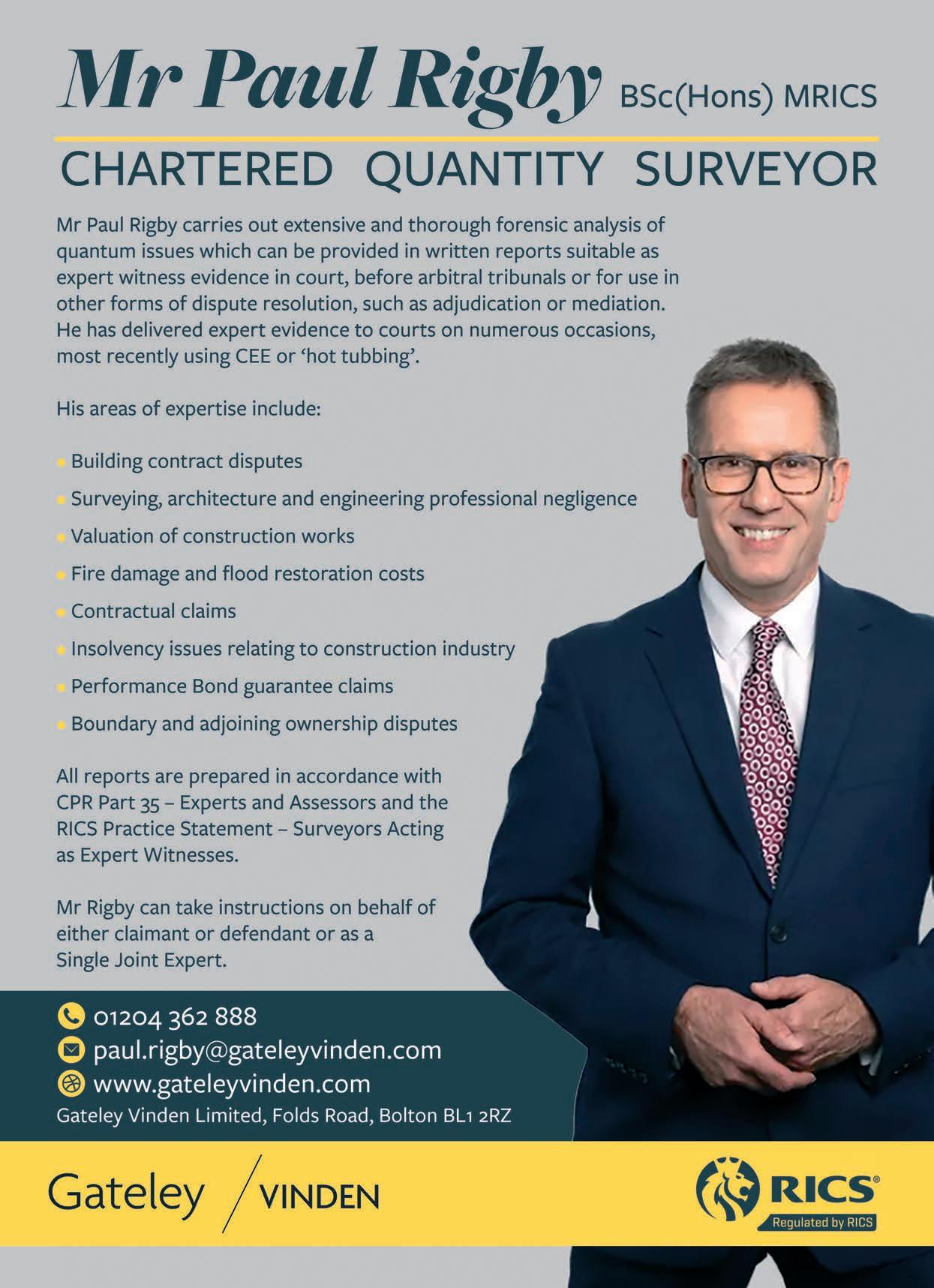
[
ENGINEERING AND CONSTRUCTION LEADERS are hesitant to adopt advanced digital technology and it is getting in the way of efforts to boost productivity and may even alienate young talent. That was the view of several speakers at a recent Institution of Civil Engineers (ICE) roundtable discussion with members and industry stakeholders.
[JULIA PRESCOT, deputy chair of the National Infrastructure Commission, spoke at the annual dinner of the National Infrastructure Planning Association on 21 November. She explained why putting people at the heart of reforms to the planning system for infrastructure is crucial to successfully delivering the new infrastructure projects the UK needs to decarbonise energy and achieve net zero, boost growth and improve resilience.
In her remarks, Julia reflected that, while there was a consensus on the need for planning reform, there was less agreement on the way to go about it. She said there was a need for a more imaginative approach to the way that major infrastructure projects are communicated to the public: one that put people more at the heart of the process and focused on the tangible benefits that new infrastructure would bring to people’s lives, communities and the nation as a whole.
Drawing on recommendations the commission made in its second National Infrastructure Assessment in October 2023, she explored what steps were necessary to build a more effective, people-focused approach to infrastructure planning, including through providing more tangible community benefits, using more representative ways to engage communities, improving the way environmental data is collected and shared, and ensuring greater continuity in long-term infrastructure planning.
She referenced a 1960s advert from the Central Electricity Generating Board, pointing out that you can’t have modern appliances without the pylons to carry the power.
“Everyone wants a modernised healthcare system that uses data to keep their loved ones healthy for longer,” she said, “but no one wants the view of a data centre from their window. Until a majority of people accept that we ‘can’t have one without the other’, then planning reform will get us nowhere.” q

Darren James, Keltbray’s CEO and chair of the ICE’s Inspiring Engineering Excellence Board, led the roundtable. ICE’s engineering communities manager Adam Kirkup reported on proceedings.
“The discussion focused on barriers to using technologies that could streamline infrastructure delivery. Some participants argued that it is culture that's getting in the way of digitalisation. It means fewer people are using data-driven processes. They criticised what they saw as ‘overcautiousness’ among project leaders. They suggested that this could drive younger professionals to join other industries.
“The event also proposed ideas for improving productivity in the infrastructure sector. Participants stressed the value of leaders who encouraged their teams to try out new processes and tools. They suggested trying the automotive industry’s ‘fail-fast model’ to foster innovation in the infrastructure sector. That model encourages businesses to test their ideas early and often, so they can find out what does and doesn’t work so they can spend their time and resources wisely.
“Speakers also recommended using a common language for sharing data throughout the industry. They suggested prioritising systems and processes that people designing and delivering projects find the most useful.”
The roundtable was sponsored by US software firm Bluebeam. The ICE, supported by Bluebeam, is also hosting a webinar showcasing infrastructure projects that successfully used digital technology. It will be held on 29 January. Email knowledge@ice.org.uk to register your interest. q

By Roger Emmott, managing director of Roger Emmott Associates Ltd
[ EVEN THE BEST-WRITTEN CONTRACTS are not immune to disputes. Misunderstandings, breaches, or even external factors can cause unexpected complex issues requiring specialised knowledge. When disputes do arise, lawyers alone may not always be equipped to resolve them, especially when technical or industryspecific factors are involved. From my experience, engaging experts early on can significantly improve the resolution process, preventing costly delays and misunderstandings.
Contractual disputes can emerge for a wide variety of reasons, and the nature of these disputes often dictates the kind of expertise required. Financial expertise is often required, for the valuation of a business or the calculation of damages. ‘But For’ analysis is often required – examining what would have occurred if the breach hadn’t taken place. This is crucial in estimating the financial losses arising from a breach and expert advice is often invaluable.
Technical breaches can be many and varied. In a dispute I was involved with, steel billets did not meet the contractual specifications and determining whether or not the supplier was in breach required expert knowledge.


Accurate contract interpretation often hinges on a clear understanding of industry standards. Many industries – such as construction, manufacturing, and even commodities trading – have complex, evolving standards that may not be immediately clear to those outside the industry. Disputes often require expert insight.
Many disputes require a collaborative approach involving multiple disciplines. One complex case involved a manufacturing plant dispute where both technical and financial experts were needed. The technical team assessed the plant’s operations under different scenarios, and their findings were incorporated by financial experts to model potential damages with precision. The collaboration of experts from both fields permitted a robust and credible outcome.
In another case, expert advice in insurance-related contractual matters proved essential. Multiple insurers were involved, and the dispute revolved around complex clauses in the insurance contracts. The expert helped navigate the intricacies of the various policies and allowed the legal team to present a coherent argument for their client, streamlining what could have otherwise been a drawn-out process.
One often overlooked aspect of contract disputes is the requirement for the injured party to mitigate their losses. Courts generally expect that once a breach has occurred, the wronged party should take reasonable steps to limit the financial damage.
I have dealt with cases where businesses successfully mitigated their losses by selling products to alternative buyers soon after the breach occurred. Here, industry experts provided the context necessary to understand whether the mitigation efforts were both timely and reasonable.
Such real-world examples highlight how important it is to have the right experts guiding the process. They not only inform the legal teams but also help demonstrate to the court or arbitrators that all efforts were made to minimise the impact of the breach, strengthening the case.
While no contract can guarantee the complete avoidance of disputes, engaging experts early and strategically can greatly enhance the outcome. Industry specialists bring clarity to complex issues, whether calculating damages, interpreting standards or understanding mitigation efforts. Moreover, collaboration between technical, financial and legal experts creates a more comprehensive view of the dispute at hand.
From my own experiences, I have seen how expert insight can bridge the gaps between legal interpretation and the technical realities of an industry, ultimately leading to more efficient and credible resolutions.
Involving experts from the outset not only helps navigate complex issues but can also prevent smaller misunderstandings from escalating into major legal battles. Timely expert advice can be the key to resolving disputes fairly and efficiently, benefiting all parties involved. q
[
DURING THE SUMMER the cross-party House of Lords Public Services Committee embarked upon a short inquiry into interpreting and translation services (ITS) in the courts.
The inquiry sought to understand the experience of procuring ITS in the courts, policy recommendations for supporting service providers and the potential role of technology in enabling ITS.
Topics addressed by the inquiry included:
• The extent to which the current ITS provided in court meets the
• needs of defendants, prosecutors, witnesses and legal professionals
• The key issues in the provision of ITS and how they impact
• on the running of the courts, public trust and interpreters and
• translators themselves – including whether there is any data on
• miscarriages of justice in relation to ITS
• The qualifications and experience of interpreters and translators
• and the recruitment process, including any barriers to recruitment
• Quality assurance and the complaints procedure in relation to ITS
• The potential role of new technology such as artificial intelligence,
• machine translation and the digitalisation of court proceedings in
• the future of interpreting or translation services in the courts
• The current capability and accuracy of market-leading artificial
intelligence and machine translation tools in relation to ITS.
Baroness Morris of Yardley, chair of the Public Services Committee, said: “It is vital that people in court - including victims of crimes, witnesses and those charged with offences - have equal access to justice, can be understood and understand what is happening in the court, regardless of what language they speak. However, there are concerning reports of people struggling to access interpreting and translation services in the courts.
“Existing issues surrounding the procurement and provision of language services for the public sector have already been highlighted in an October 2023 report by the Association of Translation Companies. That report included a conclusion that the provision of interpretation and language services was fragmented across the UK, which in turn caused complications with procurement and implementing and monitoring best practice. Other studies have also highlighted problems with recruitment and retention of translators due to poor remuneration.
“Organisations across the public sector use interpretation and translation services to help people who use public services to overcome language barriers and communicate effectively.” q
[ THE CHARTERED INSTITUTE OF LINGUISTS (CIOL) has partnered with the University of Bristol on a research project, Uses of AI Translation in UK Public Service Contexts . The groundbreaking research, authored by Dr Lucas Nunes Vieira of the University of Bristol, examines a previously unstudied aspect of our public services: the use of machine translation tools by frontline workers.
The findings are both informative and concerning. They reveal significant use of AI-powered translation tools, including Google Translate and ChatGPT, in healthcare, legal, emergency and police services: a practice that has largely gone unnoticed and unregulated.
The data, from over 2,500 UK professionals, shows that a third of respondents have used machine translation in their work, often in public-facing situations where miscommunication could have serious consequences. Of particular concern is the lack of institutional awareness and acknowledgement of the practice and the absence of appropriate policy frameworks to protect the public and public service workers themselves.
The majority of respondents reported that machine translation had never been mentioned in their workplace training, despite its frequent use. That institutional silence means frontline workers are navigating complex linguistic situations with public service users and the public in ad hoc ways without guidance or support.
The CIOL said: “We wholly endorse the recommendations put forth in this report. The call for organisations to acknowledge the existence and potential use of AI/machine translation, to address that use in policies and to place much more emphasis on staff education and training on AI and machine translation are all crucial steps.
“However, we believe these recommendations should be seen as a starting point rather than the end state. They should be implemented alongside robust safeguards and a commitment to maintaining human oversight by professional translators and experienced linguists in critical translation tasks.
“The risks of getting translation wrong in public service contexts, through mistranslation, cultural insensitivity or loss of nuance are simply too high to not use appropriately qualified language professionals. Another concern is the potential for AI to perpetuate or even amplify biases present in its ‘training data’, leading to systemic discrimination in translated content.
“In light of these concerns, we strongly advocate for maintaining
and, where possible, increasing public service budgets for professional translation services. While we recognise that it may not be realistic for human translation to be used in every circumstance, it is crucial that funding for skilled linguists is protected, especially in high-stakes situations where accuracy and cultural sensitivity are paramount.” q

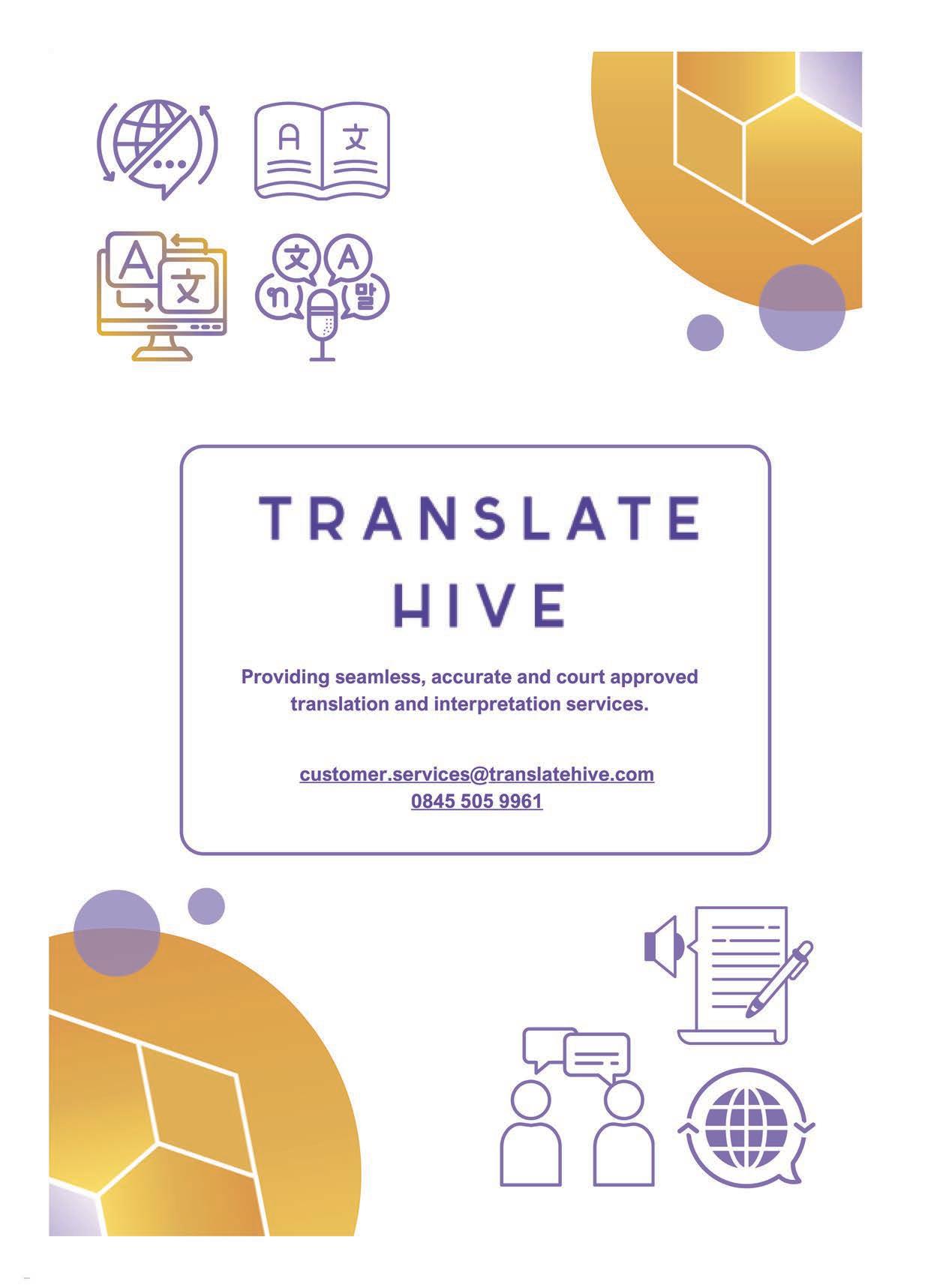

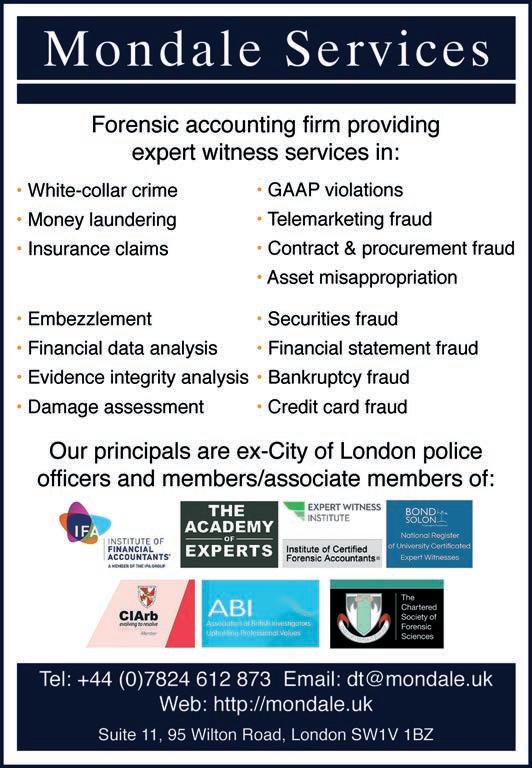

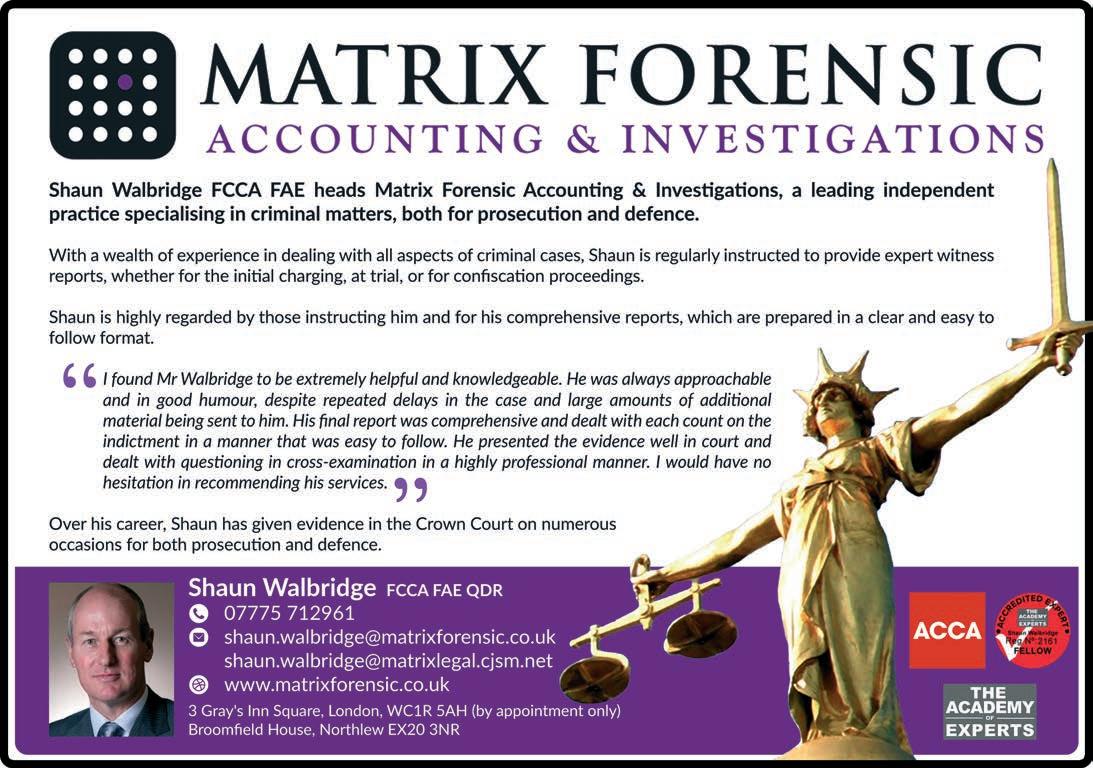
by David Stears of Buzzacott LLP
[YOU MAY FEEL that you already know the answer to that question, but you may be surprised at how varied the answer might actually be.
In the UK, the question is made harder by the absence of any longestablished, specialist professional qualification for business valuations, such as exists in the USA and Canada, for example. While there are admirable moves being made to correct that, such bodies remain embryonic and most professionals in the field do not carry such an accreditation.
But they would at least hold a chartered accountancy qualification, wouldn’t they?, I hear you ask. Well, no – much as it would benefit me personally to answer otherwise, as I am a chartered accountant. There are other routes into the profession, such as the Chartered Financial Analyst (CFA) route: or even without any professional qualifications at all.
But wouldn’t a chartered accountant, by definition, be able to do the work? Again, no. Over recent years, recognition of how technical a specialism business valuation has become has increased considerably, and there are now at least 20 specialist valuation advisory teams in the UK.
What makes it so specialist? In many cases a valuation may not actually be that complex, assuming it is a relatively straightforward business with a simple capital structure. However, there may be factors that easily get missed, that may be hidden in the detail of a set of Articles of Association for example, or in the understanding of how certain calculations operate – which can lead to manifest error.
A reliable valuation will also, in the majority of cases, need to benchmark against market data only accessible via subscribed-to databases, which are only economical for advisors if they perform enough valuation work to make it worthwhile.

So, who would be a suitable expert? Generally speaking, corporate finance specialists dealing with mergers and acquisitions should be comfortable in pricing shares and businesses through the work that they do, while forensic accountants have historically undertaken a lot of valuation work in quantifying their claims.
However, where there is a degree of complexity in share valuations, for example in an equity ‘waterfall’ with numerous share classes, genuine specialist knowledge would be crucial. Furthermore, specialist techniques will be required for the valuation of share options or intellectual property. As is often the case, a little knowledge can be a dangerous thing; so making sure that your expert has the right technical skillset will be key to getting the appointment right. q



[ CRACKING DOWN ON INSURANCE FRAUD remains a top priority for the industry, the Association of British Insurers (ABI) said, as it revealed that £1.1bn worth of fraudulent claims were detected last year: up 4% on 2022. Insurers identified 84,400 fraudulent claims in 2023 – 11,800 more than the previous year – and the average value was £13,000.
For the first time the ABI’s latest figures also included details on the type of fraud scammers attempted to commit. Exaggerated loss, the deliberate attempt to increase the cost of a claim beyond its true value, was the most common, with 25,700 claims amounting to £407m.
Motor insurance continues to be the area where insurers see most fraudulent claims occurring: they detected 45,800 motor scams worth £501m. That is 8% more than in 2022 and represents 54% of all claims made throughout the year. Insurers also identified 16% more fraudsters making fake property insurance claims, worth £143m.
Alongside that, ABI members prevented an estimated 583,000 fraudulent insurance applications, a 17% increase from 2022. Application fraud is when important information is purposefully misrepresented or hidden for financial gain.
Mark Allen, the ABI’s assistant director and head of fraud and financial crime, commented: “Insurance is there to protect people and businesses should the worst happen. It’s encouraging to see that the industry’s efforts to detect and prevent people from abusing this are working, but there can be no let-up in pursuing insurance fraudsters.
“Fraud doesn’t just impact victims that fall foul of the scammers; it affects everyone that pays for an insurance policy – with bogus claims pushing up the cost of premiums for all. That’s why cracking down on fraud continues to be a top priority for our industry.”
Some of the cheats exposed
Ghost broker exposed: A man convicted of pocketing £200,000 by selling over 900 fraudulent motor insurance policies was sentenced to 24 months imprisonment, suspended for two years, and ordered to complete 220 hours of community service.
The lie detector says: A woman who exaggerated the injuries she sustained in a road traffic collision and tried to make a fraudulent civil injury claim worth £492,141 was sentenced to 12 months imprisonment suspended for 18 months, after she was caught out by evidence that included footage from The Jeremy Kyle Show. In a similar case, a man who exaggerated the cost of damage to his car by over £40,000, following a road collision, was sentenced to 12 months imprisonment.
If it ain’t broke, don’t claim for it: A serial fraudster who submitted a series of claims for broken TVs, laptops and phones, pocketing £11,750, was sentenced to 20 months imprisonment and ordered to pay £140 victim surcharge.
Fake it till you don’t make it: A man who changed his name several times by deed poll and used the identities of his family and friends to make bogus travel insurance claims worth an estimated total of £75,000 was sentenced to 20 months imprisonment, suspended for two years, and ordered to complete 200 hours of community service.
Commercial con crackdown: Ten people were arrested across the country and 18 vehicles seized during a two-week police operation to tackle commercial insurance fraud. Police targeted people making bogus claims on motor and business premises insurance, ghost brokers who sold fake motor insurance policies for vehicles used for business purposes and fraudulent claims made by employees on their corporate benefit plans.
Ursula Jallow, director of the Insurance Fraud Bureau, said: “With a rise in detected fraudulent insurance applications and claims, it’s never been more important to raise awareness about the impacts of insurance fraud: whether it’s raising awareness with those who
are thinking of making an exaggerated fraudulent claim or raising awareness with members of the public who could be the victim of an insurance scam.
“We’re collaborating closely with insurers, law enforcement agencies and industry bodies to ensure that we protect the UK public from insurance fraud and scams as these can be devastating – financially, socially and psychologically. We urge anyone with evidence of an insurance scam to report it to our confidential CheatLine”
Detective Chief Inspector Tom Hill, from the City of London Police’s Insurance Fraud Enforcement Department (IFED), added: “Insurance fraud is not a victimless crime. It increases the cost of premiums for honest customers, while fraudsters who sell fake car insurance or deliberately cause road traffic collisions to claim compensation put innocent motorists at risk.
“The figures released today show that around 230 fraudulent insurance claims are detected on average each day, showing that IFED and the insurance industry will root out fraudsters and bring them to justice.”
The latest figures from ABI were published following its online fraud campaign, which aimed to raise awareness of types of fraud carried out online and through social media by using case studies, digital adverts and partnering with influencers. More information on the different types of online insurance fraud and how to avoid being targeted is available via the ABI website at www.abi.org.uk q



[ ON 15 OCTOBER the Institute of Chartered Accountants in England and Wales (ICAEW) published its anti-money laundering (AML) supervision report for 2023/24. The institute carried out 1,088 monitoring visits across its supervised firms during the year, with 80.7% assessed as compliant or generally compliant.
It recently made changes to its supervision methodology, to focus on the effectiveness of AML policies and procedures rather than their technical compliance or existence, with compliance remaining high.
A total of 215 firms were required to undertake follow-up action to improve their processes. In total, 39 firms were sanctioned and fined a combined total of £92,025, and one member was excluded.
ICAEW supervises 11,000 member firms in relation to money laundering. It regularly produces resources to support its supervised population, including risk bulletins, webinars and articles, as well as its award-winning anti-money laundering training film, All Too Familiar, produced in collaboration with HMRC.
The institute uses a range of tools and methods in its approach to AML supervision and targets its resources where the risk is highest.
Duncan Wiggetts, ICAEW chief officer for professional standards, said: “As this report shows, we spend a lot of time and effort helping the firms we supervise to understand how they can avoid becoming unwitting professional enablers of money laundering. To ensure continuing improvement, we decided this year to raise the bar for a firm to be ‘compliant’; so it is pleasing, in that context, to see continued
[ THE SERIOUS FRAUD OFFICE (SFO) has launched an investigation into suspected bribery and corruption at multi-national aviation and defence electronics group Thales. The Thales Group has its headquarters in Paris and its subsidiary, Thales UK, employs over 7,000 staff in the UK across 16 sites.
Investigators from the SFO and French authority Parquet National Financier (PNF) have informed the company of the investigation. The SFO and PNF are conducting a joint investigation in their respective jurisdictions.
Director of the Serious Fraud Office, Nick Ephgrave QPM, said: “Working collaboratively with our international partners is a crucial factor in the fight against international corruption and with this case I hope to reinforce the SFO and PNF’s long-standing relationship, built on mutual co-operation and shared success.
“We will together rigorously pursue every avenue in our investigation into these serious allegations.” q

high levels of compliance. The report also shows that, where firms and individuals fall below the standards we expect of them, we will not hesitate to take enforcement action against them.
“In order for bodies such as ours to continue investing in resources and capabilities to improve our supervisory work, we call on the government to issue the long-delayed feedback statement into the future of AML supervision and reconfirm the important role which professional bodies should play in this area.” q
[ THREE PEOPLE, including a husband and wife, have been charged in an investigation by the National Crime Agency linked to international PPE fraud.
Jogesh Kumar Bhandari and Craig Vincent Morris were both charged with two counts of conspiracy to commit fraud and one of money laundering in relation to a scheme to benefit from PPE shortages during the height of the coronavirus pandemic. Jogesh Bhandari’s wife, Meenakshi Bhandari, was charged with one count of money laundering.
Investigators believe they brokered sale agreements to supply nitrile gloves to companies in the USA and Germany worth over $35m. Together the group may have defrauded the companies by almost £1.9m ($2.35m).
All three pleaded not guilty and have been bailed to appear at Leicester Crown Court on the 16 December for a plea and trial preparation hearing. q

[ THE Competition and Markets Authority (CMA) is taking action to protect the growing number of UK consumers who are opting for alternatives to high street solicitors when making a will or getting divorced. Businesses which provide these unregulated legal services are a growing part of the legal sector and it is crucial they understand and comply with their consumer protection obligations. People buying these services need to be sure they are getting a fair deal.
Consumers are also cautioned to think carefully before buying prepaid probate plans as they come with significant consumer protection risks, including that the company could cease trading before the consumer’s death. A consumer warning on pre-paid probate services is already available via the Financial Conduct Authority and sets out the key issues for consumers to be aware of in relation to these services.
The FCA guidance for consumers says: “We have seen increased marketing of pre-paid probate plans in recent months, including from firms and individuals associated with funeral plan firms that we did not authorise, and whose customers lost money when they collapsed.
“When designed and marketed appropriately, pre-paid probate plans could help people organise administration arrangements ahead of their death. But as we do not regulate pre-paid probate firms, or the prepayment of probate costs, there are no regulatory protections in place for you.”
The CMA has written to seven providers of unregulated legal services cautioning them against using particularly concerning practices such as aggressive upselling, the refusal of refunds and failing to respond to complaints.
Those who receive a letter should acknowledge it and act on any

recommendations to review and revise their contract terms and practices. With the CMA set to receive stronger enforcement powers from next spring, if concerns are not addressed the businesses could face a formal investigation.
To help boost compliance levels across unregulated legal services, the CMA is also issuing new tailored guidance for businesses in the sector. This follows a consultation which received widespread support from consumer bodies, trade associations and the firms offering those services.
Hayley Fletcher, CMA’s interim senior director for consumer protection, said: “Alternatives to conventional high street law firms can offer convenient services for people – and when day-to-day budgets are already under pressure, they can be a more cost-effective option.
“Those offering these types of legal services often meet their customers at some of the most challenging times in life, so it’s particularly important that a difficult time is not made harder by misleading or unfair practices. Our new guides will help empower consumers to ask businesses the right questions before they buy and give businesses an opportunity to get their house in order.
“To ensure they comply with the law, we expect businesses in the sector to read the new guidance and make the necessary changes to their terms and practices. Those who don’t could face enforcement action.”
To raise business awareness of the CMA’s new guidance, an open letter has been sent to providers and published online. The CMA will continue to monitor the sector and expects to conduct a formal compliance review in due course. q

Welcome to our A to Z guide of the websites of some of the Expert Witness field’s leading players.
If you are one of our many online readers simply click on any of the web addresses listed below and you will be automatically directed to that particular website.
To get your website listed on this page just give us a call on 0161 710 3880 or email ian@dmmonline.co.uk
Clarke Gammon
Chartered Surveyors with experience in All

Translations and Interpreting for the Legal Profession since 1997. Specialists in Personal Injury and Clinical Negligence. www.abc-translations.co.uk
Andrew F Acquier BA FRICS
Chartered Art & Antiques Surveyor Expert witness reports and representation at court for matters involving: • Divorce settlements • Insurance valuation disputes
• Arts litigation • Contentious Probate
www.andrewacquier.co.uk
David Berry PhD FRC Path MFSSoc MRSC
Independent Toxicology Consultant Specialist in Clinical and Forensic Toxicology with particular emphasis on drugs (both illicit and therapeutic) and alcohol. www.toxicologyservices.co.uk
Mr Timothy Burge MBChB FRCS FRCS(Plast) DMCC MSc
Consultant Burns & Plastic Surgeon
• Cosmetic and aesthetic surgery of the breast and trunk
• Burns • Trauma • Scars www.clifton-plastic-surgery.co.uk
Professor Frank Chinegwundoh MBE
Consultant Urological Surgeon specialising in Personal Injury and Medical Negligence cases on behalf of either claimant or defendant or as a Single Joint Expert. www.urologyconsultant.co.uk




Professor Paul J Ciclitira MB PhD FRCP MRCS FRCP AGAF
Professor of Gastroenterology with particular interest in food allergy, including Coeliac disease, peptic ulcer, inflammatory bowel disorder and hepatology. www.profpaulciclitira.co.uk
Dr Sarah Cockbill Expert Pharmaceutical Witness PhD BPharm MPharm LLM DAgVetPharm FRPharmS FVPA
• Pharmacology • Drug Interactions • Formulation
• Appropriate Dosage • Veterinary Pharmacy • Drug Licensing Instructions for claimant, defendant or as Single Joint Expert
E: cockbills1@gmail.com
Mr Philip Coleridge Smith DM MA BCh FRCS Consultant Vascular Surgeon
20 years of:
• Defendant instructions • Claimant instructions
• Single joint expert • Court experience



www.adsummedicolegal.com & www.britishveininstitute.com
Mr Jeremy P Crew MA MD BChir FRCS
Consultant Urological Surgeon Medical reports on all legal aspects of urology. Reports in some cases based on hospital notes only. www.oxfordurology.co.uk

Aspects of Property • Residential property values
• Asset valuations • Land values and more www.clarkegammon.co.uk
Chris Dawson MS FRCS LLDip

Consultant Urologist with 20 years experience of medico legal report writing and expert witness work and has completed over 1,850 reports. He also regularly completes Fitness to Practice reports for the General Medical Council.
www.chrisdawson.org.uk
DRC Forensics Limited


DRC Forensics Limited offers the complete range of forensic accounting & litigation support: • Fraud • Money laundering
• Partnership disputes
• Loss of profit • Professional negligence www.drcforensics.co.uk
Mr Mark Duxbury MA (Oxon) DM FRCSEd (Gen Surg)
Consultant Hepatobiliary, Pancreatic & General Surgeon
• General & emergency surgery • Hernia surgery
• Liver & pancreatic surgery • Gallbladder & biliary surgery
• Laparoscopic surgery • Hepatobiliary surgery www.markduxbury.info/medicolegal

Mr Roger Emmott CEng BSc(Hons) MSc/MBA MA FCMI FIC Steel and iron ore expert with international arbitration and cross-examination experience in complex disputes
• Industry • Pricing • Contractual • Valuations T: 07974 351704 E: roger@rogeremmottassociates.com www.rogeremmottassociates.com
Equip2Speak
Specialists in Brain and Spinal Injury. SLT & AT Consultants
• CUBS Certified Experts since 2012/2013 • Accident, Negligence and Criminal Cases • Experienced in High Value Claims
• Claimant/Defendant/Joint Instruction
www.equip2speak.co.uk
Face Restoration
• Complications of cosmetic eyelid surgery
• Brow lift surgery • Ptosis • Non-surgical aesthetics
• Orbital diseases • Watery eyes • Thyroid eye disease www.facerestoration.com
FHDI - Kathryn Thorndycraft-Pope





Examining documents & handwriting • to determine authenticity • to expose forgery • to reveal aspects of origin. Electro Static Detection Apparatus and Mi-Scope used. www.forensichandwriting.co.uk
Forensic Collision Investigation & Reconstruction Ltd
Specialists in the analysis of road traffic collisions
• Collision Reconstruction • Expert Witness
• Vehicle Examinations
www.FCIR.co.uk

Formedecon Ltd
Forensic & Investigative Services to the Legal Profession
• All Aspects of Forensic Work Undertaken
• LAA and Privately Funded • Free Estimates www.Formedecon.com

Griffin Forensics eForensics and Data Recovery Experts
• CCTV Recovery and Analysis
• Computer Media
Investigations • Mobile Phone Extraction and Analysis • Forensic Data Recoveries
www.griffinforensics.com
Mr Kim Hakin FRCS FRCOphth
Consultant Ophthalmic Surgeon and Expert Witness on ophthalmological matters
www.kimhakin.com
Haydn Jones MEng DipLaw FIET
Data Technologist & Digital Regulation Expert
• Injunctive relief
• Money laundering
• Digital currency theft • Counter funding of terrorism E: h.jones@xchain.com
Atul Khanna FRCS (Plast)
Consultant Plastic, Reconstructive and Hand Surgeon
• Hand surgery • Soft tissue injury
• Burns management
• Medical negligence in cosmetic surgery www.atulkhanna.co.uk/expert-witness/
Dr Raj Kumar – Dental Expert
Causation and Liability and Condition and Prognosis Reports
• General dentistry • Cosmetic dentistry • Patient consent
• Dental implantology • Orthodontics • Facial aesthetics 07802 456 804 | info@dentalexpert.me | www.dentalexpert.me
Laird Assessors






The UK’s leading independent automotive expert witness firm supporting claimant, defendant and criminal solicitors. From instruction to court. www.laird-assessors.com
Kulvinder Lall Consultant Cardiothoracic Surgeon
Instructions taken in cases relating to cardiac and thoracic surgery, including aspects relating to surgical care and those following trauma to the structures of the chest. www.kulvinderlall.com
Maggie Sargent & Associates
Internationally renowned provider of detailed and independent medical expert witness reports. We consistently provide our solicitors with meticulously prepared and highly trusted reports that put the client at the centre.
www.maggiesargent.co.uk
Mr Chris Makin
• Chartered Accountant
• Accredited Civil Mediator
• Accredited Expert Determiner
www.chrismakin.co.uk


Mr Fredrik P Nath FRCS MBChB
Consultant Neurosurgeon • Head injury • Spinal injury
• Acoustic neuroma • Lumbar and cervical degenerative disease • Musculo-skeletal injury including whiplash www.neurosurg.co.uk
Mr Abraham Odumala
MBBS M.MedSci FWACS FRCS FRCS(Tr & Orth)
Consultant Orthopaedic Surgeon – Upper Limb Specialist. Expertise in all upper limb conditions and treatment. Shoulder, elbow, wristand hand injuries. www.yorkshire-upperlimb.co.uk
Dr Shanthi Paramothayan
BSc PhD MBBS LLM MScMedEd FHEA FCCP FRCP
Consultant Respiratory Physician specialising in negligence cases relating to all aspects of respiratory medicine. www.paramothayan.com
Dr Stuart Porter Chartered Physiotherapist
PhD MCSP HCPC BSc Hons Grad Dip Phys MLACP PgCAP Cert.MHS SFHEA
Specialist areas of expertise include: • Clinical negligence
• Breach of duty • Allegations of inappropriate contact
• Assessment of adults and children • HCPC investigations. stuartbporter@aol.com
Simon Quinton Smith BSc FRICS MI Hort
Expert Witness to the Garden Centre & Horticultural Industry
• Rent Reviews • Lease Renewals
• Valuation • Planning
• Compensation • Tax Issues
www.quintonedwards.co.uk
Professor Christopher Raine MBE
Specialist in paediatric and adult otology
• Medical negligence • Personal injury cases involving noise induced hearing loss. www.profchrisraine.co.uk
Mr Sameer Singh MBBS BSc FRCS Orth Consultant Orthopaedic Surgeon • All aspects of trauma – soft tissue and bone injuries • Upper and lower limb disorders and injuries
• Whiplash injuries • Expert Witness for defence and claimant Clinic locations – London, Milton Keynes and Bedford
www.orthopaedicexpertwitness.net
Andrew Smith FPC III CeMAP
Financial Conduct Authority Compliance & Risk Consultant Cases relating to FCA compliance in consumer credit and mortgage lending.
• Mediation • Arbitration • Adjudication • Expert Determination
www.paxen.co.uk

Mr Richard Matthews MB BS FRCS FRCSE MAE
PLASTIC & HAND SURGEON
Mr Matthews is well versed in the provision of Medical Reports relating to Personal Injury ranging from scarring through trauma, including burns and scalds, to non-bony hand injuries.
www.richardmatthewsmedicolegal.uk









Prof. Elizabeth J. Soilleux MA MB BChir PhD FRCPath PGDipMedEd Expert Witness Pathologist with a particular interest in haematopathology. Short reports on specimens, full court compliant reports and expert biopsy reporting. www.expertwitnesspathologist.co.uk

Mr Bernard Speculand MDS FDS FFD FRACDS (OMS) Consultant Oral and Maxillofacial Surgeon. Personal injury and clinical negligence cases for claimant, defendant and as Single Joint Expert. Special interest is TMJ Surgery.
Yvette Young (Secretary) T: 0121 605 1884
E: info@medsecadmin.co.uk www.birminghamtmj.co.uk
Dr Ian Starke MSc MD FRCP
Stroke Medicine and Medicine for the Elderly Reports and examinations for clinical negligence and fitness to practise cases in stroke medicine and geriatric medicine www.expertwitnessinstrokes.co.uk


Mr David Anthony Sykes (Tony Sykes)
BSc CEng CITP MBCS MIET FAE MEWI Specialist in IT and Telecommunications. Expert witness and consultancy services to lawyers, insurers and loss adjusters. Experience in international arbitrations and the High Court TCC.
www.rocksideconsultants.co.uk
Mr. William E G Thomas Bsc, MBBS, FRCS, MS
Consultant Surgeon specialising in general surgery, hernia surgery, gastrointestinal surgery, hepatobiliary-pancreatic surgery, laparoscopic surgery and endocrine surgery
T: 0114 262 0852 E: wegthomas@btinternet.com W: www.wegthomas.com



UK Ophthalmology Experts
UK Ophthalmology Experts are a team of leading, independent ophthalmology experts covering all aspects of ophthalmology. ukophthalmologyexperts.co.uk

Dr Ravinder Varaich Dental Expert
BDS (University of Birmingham) MFGDP (RCS Eng) MAE
> Criminal cases > Personal injury > Clinical negligence
• Restorative dentistry • Periodontal disease • Endodontics • Dentures
• Oral surgery • Orthodontics • Cosmetic dentistry • Facial aesthetics
www.dentalexpertreports.co.uk
DR S V MEDICALS (Mr Sen Venkat)
MSc Ortho (London) FRCS Consultant Orthopaedic Surgeon
• Whiplash injuries • General trauma • Sports injuries

WOODEXPERTS
Specialist Timber Consultancy and Training since 1991
• Site visits & investigations • Structural surveys
• Desktop analysis & review of documents
• Specialist reports • Species identification
• Clinical negligence work • Joint replacement surgery of hip and knee • Hand, shoulder, elbow and wrist injury www.drsvmedicals.co.uk www.woodexperts.com
Ms Leyla Ziyal MPhil AFBPsS CPsychol
HCPC Registered clinical Neuropsychologist
• Neuropsychological assessment and rehabilitation
• Depression • Occupational stress • PTSD • Anxiety www.accentpsychology.co.uk




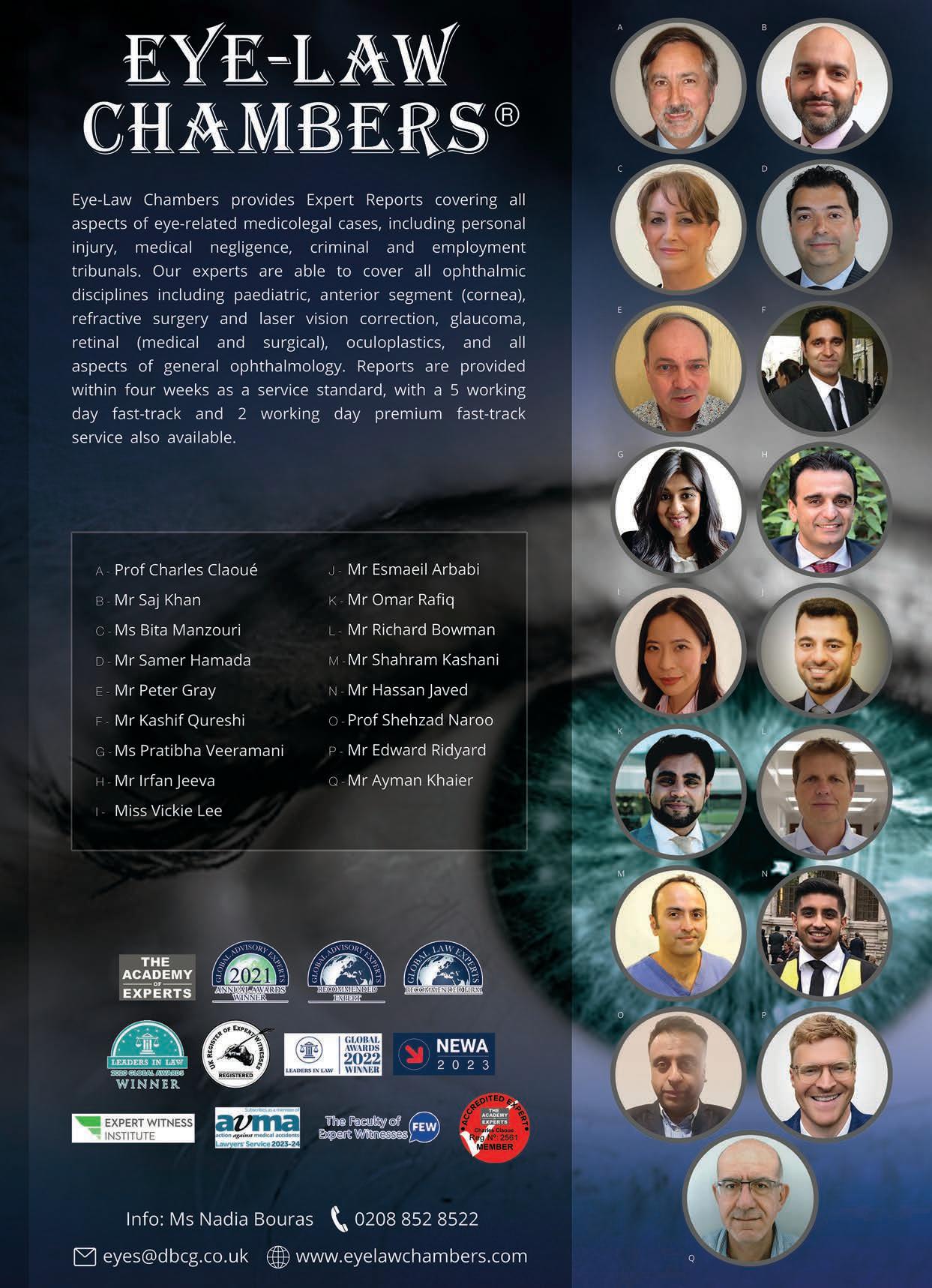

[THE MEDICAL ELEMENTS of this issue have three principal themes – new legislation regarding mental health and the right to die, head injury and its consequences, and developments in hip surgery.
• Two pieces of legislation that have implications for medicolegal litigation have been making their way through the two Houses of Parliament. In the Commons the Terminally Ill Adults (End of Life) Bill was given its Second Reading.
A key part of the Bill was for a psychiatrist to be consulted in cases where capacity is in doubt. As with much of the Bill, that element has split psychiatrists, with over half of RCPsych members polled saying they would not be willing to participate in such cases.
In the Lords the passing of the Mental Health Bill through its Second Reading received a similar, mixed reception. Both the RCPsych and the British Psychological Society welcomed the Bill’s principal aims of improving the treatment options for mentally ill people. Both bodies, however, flagged up possible unintended consequences that could result in ‘criminalising the very individuals the Act aims to protect’.
• The Family Court was the focus of a symposium held by the MoJ in Cardiff. Three of the issues under debate were the Suspected Inflicted Head Injury Service (SIHIS) pilot, the role of trauma assessments and transparency of judgements
In the case of SIHIS a number of speakers provided an update on progress of the pilot, stressing the importance of a multi-disciplinary approach. On the subject of trauma, the view was that trauma should have a ‘permanent seat at the table’.
Justice Lieven discussed the issue of transparency in the Family Court. There is a target to publish 5% of judgements, and an aim to establish a unit in the HMCTS to achieve that.
• Head injury and its consequences figured large in a number of articles in this issue. A stark figure is that head injury is suffered by around half of domestic abuse victims. In a large number of cases that can result in PTSD, a condition that is underappreciated in some courts.
How a case is managed following brain injury can be a complex undertaking. Victims may need extensive rehabilitation resources requiring specific expertise. Enlightened law firms employ such experts and we hear from one of them.
When I was young, a major cause of controversy was the damage to young brains in towns and cities as a result of lead from petrol in motor vehicles. The result, of course, was the banning of lead in petrol in 2000, although the stuff had been phased out over a 20-year period.
That doesn't mean that lead has disappeared from our air: 226 cases of lead in children were reported in 2023, according to a report from the UK Health Security Agency
• A procedure that can result in negligence claims is where a hip replacement ‘fails’ for whatever reason.
A question arises as to whether the failure is attributable to negligence or a faulty appliance. Expertise in consumer law may, counter intuitively, come in handy in assessing such cases.
The question of which kind of hip replacement will be least likely to need revision was the subject of a study by researchers at Bristol University. Hopefully, the results will guide surgeons in material choice and lead to fewer negligence claims.
• There is less certainty among the male population when it comes to their prostate gland.
A survey by the Urology Society found that only half of men know where the organ is located –a figure that dwindles to one in three of 18-24 year olds. Significantly, male knowledge of female anatomy is more comprehensive. q

[ON 27 NOVEMBER Ian Dilks confirmed that he will not be seeking reappointment as chair of the Care Quality Commission (CQC) when his three-year term ends on 31 March.
Mr Dilks said: “It has been a privilege to serve as CQC’s chair. Although the last three years have at times been intensely challenging, I am confident that the organisation is on the path to recovery and can make the changes needed to become the strong, effective regulator that people who use and work in health and social care services need and deserve. I know CQC’s staff, board and executive team are all fully committed to achieving this.”

His announcement came following the publication of two reports critical of the CQC’s organisation and the stepping down of its interim chief executive Kate Terroni to make way for the new permanent chief executive Julian Hartley.
In October the CQC announced that it accepted the recommendations of both the final report of Dr Penny Dash’s review and the first report of the independent review by Professor Sir Mike Richards.
CQC has committed to align its organisation around sector expertise by appointing at least three chief inspectors to lead on regulation and improvement of hospitals, primary care and adult social care services. Consideration will also be given to whether a

fourth chief inspector is needed to lead on regulation and improvement of mental health services.
The regulator will also modify its assessment framework to make it simpler and ensure it is relevant to each sector. That will enable CQC to carry out and report on inspections more quickly. It will retain its five key questions – safe, effective, caring, responsive and well-led – across all sectors, but will amend the 34 quality statements to ensure clarity and remove duplication. CQC will stop scoring individual evidence categories.
The report from Dr Penny Dash also talks about the need to change assessments of local authorities and integrated care systems. CQC has agreed that local authority assessments will continue with ongoing improvements and continued engagement with the health and care sector. In line with changes to the assessment framework, CQC will make scoring of evidence more transparent and will strengthen its focus on nationally agreed priorities.
In the next phase of its recovery CQC will work with providers, colleagues, people who use services, local government and wider stakeholders to develop a plan on how it will implement the changes and make sure it is realistic about what can be delivered by when. Once that is signed off, CQC will share what people can expect, and when.
Professor Sir Mike Richards and the Care Provider Alliance, chaired by Professor Vic Rayner, are currently working together to support CQC in determining what good regulatory assessment looks like, what to expect from an inspection and what the new reports for inspection will look like.
CQC also expects the Department of Health and Social Care to publish the terms of reference for Part 2 of the Dash review. CQC understands this will focus on the broader landscape of health and care arm’s length bodies. The regulator welcomed the opportunity to explore how it can better work with partners.
Ian Dilks said: “We welcome the final part of Dr Penny Dash’s review. We accept the findings and we will address the recommendations with urgency. Today also sees the publication of the review we commissioned from Professor Sir Mike Richards. We are extremely grateful to Sir Mike for his helpful work and will be using his recommendations to help us respond to the serious failings identified by Dr Penny Dash. His review also offers additional suggestions for improvement that we will be exploring as part of our wider recovery work.
“Both reviews have reaffirmed the support for a robust health and care regulator and recognised the dedication and experience of CQC staff. We are committed to rebuilding trust in CQC’s regulation and are taking action to make sure we have the right structure, processes and technology in place to help us fulfil our vital role of helping people get good care and supporting providers to improve.”
Professor Sir Mike Richards said: “I have been working closely with providers of health and social care and with CQC staff to find solutions to the very real problems identified by Dr Penny Dash. CQC’s transformation programme has not delivered what was intended.
“CQC urgently needs to return to a structure where inspections teams are led once again by chief inspectors relating to the different sectors that CQC regulates. In addition, the current assessment framework needs to be radically simplified and the major problems with the new IT system need to be rectified. I know that work is already underway to address these areas.” q


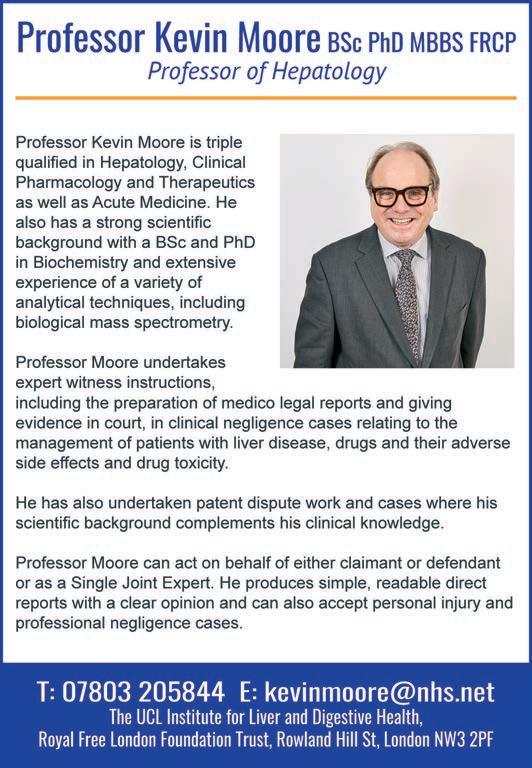

[THE BRITISH MEDICAL ASSOCIATION has made its views known regarding the upcoming review of physician associates and anaesthesia associates by Professor Gillian Leng CBE.
Responding to Baroness Bennett’s House of Lords debate on the subject on 4 December, BMA council chair Professor Philip Banfield said: “The government has acknowledged patient safety is potentially under threat from the way physician associates and anaesthesia associates are employed in the NHS. It’s therefore its responsibility to ensure NHS England puts in place safety measures while the situation undergoes urgent review. We would not keep prescribing a drug while there were outstanding questions about its safe use.
“It was good to see Baroness Bennett ask the government what much-needed interim measures it will take to protect patients. It was disappointing the government could not use the opportunity of this debate to assure the public they would be actioned.
“While the Leng review is undertaken we must see the immediate adoption of the BMA’s safe scope of practice, a pause on recruitment and expansion of these roles and a guaranteed stop to the substitution of doctors with PAs, plus clearly agreed supervision of those already in place. These are commonsense measures that we will be pursuing with NHS England and employers.
“The review itself must have the confidence of the medical profession. Too much has been hidden from public debate about the costs and safety of this role. We must not forget that it was designed to assist doctors, not replace their unique skills and expertise acquired through years of training and national assessments. Doctors’ voices have been inexplicably ignored, which is to the detriment of all, save those driving forward this unproven experiment.”
The BMA had previously compared the continued employment of associates while the review is taking place to flying a plane while its safety was under review: “You do not fly a plane under safety review, you ground it,”
Professor Banfield said on 20 November. He continued: “The NHS has failed to make the employment of associates safe for patients. By allowing a free-for-all on what PAs can and can’t do, hospitals have become a postcode lottery in which patients don’t know if they are being seen by a professional with the right skills. Only a clear, nationally agreed scope of practice, telling employers what PAs can and can’t do, will clear up this mess. This review must lead to one.
“It is also vital that the review finally gets to the bottom of the use by some hospitals of PAs and AAs in roles that should be filled by fully trained doctors. The government must not dodge this opportunity to provide a clear picture of what is happening right now to ensure unsafe substitution is immediately reversed.
“Finally, the voice of the doctor must be front and centre. Our members on the frontline are best placed to provide the Secretary of State and his review with the real evidence of what is happening on the ground, right now. Only by listening to them can this review have any hope of leading to lasting change.” q
[ A NEW All-Party Parliamentary Group (APPG) on Patient Safety has been announced. Launched on 21 November, the APPG for Patient Safety will focus on improving patient safety across health and social care. It will work to identify and promote best practice, address barriers to progress and advocate for policy changes to support a safer health and social care system.
Chaired by Conservative MP Jeremy Hunt, other APPG officers are Rosena Allin-Khan MP (Lab, vice chair), Anna Dixon MP (Lab, vice chair) and Sir Bernard Jenkins MP (Con). Three charities – Patient Safety Watch, Action against Medical Accidents and the Clinical Human Factors Group – have joined forces to serve as the APPG’s secretariat. Together, their organisations bring a wealth of knowledge, experience and insight, which will be invaluable in supporting the APPG’s mission.
That collaborative approach will allow the group to engage a broad range of stakeholders, including patients, healthcare professionals and experts, to work towards a safer future for patients across the UK.
Jeremy Hunt MP said: “I am honoured to chair the APPG on Patient Safety, bringing together cross-party parliamentarians and experts to champion transparency, accountability and best practice in health and social care and look forward to working with MPs from all parties who share the goal of reducing the devastating impacts of unsafe care.” q




[THE UK RISKS wasting the talents of tens of thousands of overlooked and undervalued doctors, to the detriment of patient care, General Medical Council (GMC) chief executive Charlie Massey has warned.
The warning came as new data in the medical regulator’s The state of medical education and practice in the UK: workforce report 2024 highlighted the changing nature of the country’s medical workforce.
UK-wide, the overall headcount of doctors rose in the past year at the fastest rate since the report began over a decade ago. But one group has been growing much faster than others: locally employed (LE) doctors. In England and Wales – the only places where specific data is currently available – the number of LE doctors grew by 75% between 2019 and 2023. By comparison, doctors on the specialist register grew by 13% and those on the GP register grew by 9% over the same period.
LE doctors are employed on local terms by trusts and health boards, rather than employed in formal postgraduate training programmes. For some it’s a career choice, while for others it’s a necessity. In England and Wales alone there are at least 36,000 LE doctors, and more than two-thirds qualified outside the UK.
But, the regulator says, the roles are too often poorly defined with limited opportunities for career progression and training. And many are employed in short-term or non-permanent posts.
Charlie Massey said of the challenges faced by LE doctors: “Locally employed doctors have a lot to offer our health services. But too often they find themselves in roles without proper access to the education and training they need to develop their skills. Without changing the way we think about training, the UK risks sleepwalking into a situation where these doctors are overlooked and undervalued, to the detriment of good patient care.”
The report shows the growth in headcount reflects an increase in doctors joining from abroad, principally India and Pakistan. Last year, more than twothirds of new joiners came to the UK from abroad, compared to under half in 2017. For those joining from abroad, the GMC says ‘concerted, sustained efforts’ are needed to provide the inductions, integration and inclusion vital for doctors to thrive in the UK.
Between 2016 and 2023 the number of doctors on the medical register from an ethnic minority background increased by 78%. Around one third of all doctors are now Asian or Asian British and, for the first time, the UK now has more doctors from ethnic minority backgrounds than white doctors.
The GMC warns the infrastructure to train and support doctors across the UK is already struggling to keep pace with growing numbers. Urgent action is needed to provide proper access to training for an increasingly diverse workforce.
Doctors in GMC-approved training roles are also under pressure, and in need of greater support. Many report unsustainably high workloads, and up to one in four are at high risk of burnout.
Based on existing government commitments to expand medical school places, the GMC projects that by 2034 there will be more than 6,000 additional UK graduates entering the profession each year. The regulator says the number of trainers available must keep pace, and their time should be protected in upcoming job planning.
Mr Massey continued: “We now have the highest number of doctors registered since our report began. Equally, government commitments to increase medical school places are a much-needed boost to a workforce that has been under sustained and significant pressure.
“But for doctors to thrive and provide high-quality patient care, training and development must be tailored to each group’s needs, whether that’s supporting a doctor to adjust to working life in the UK or helping a newly qualified doctor navigate a challenge faced on a shift. Opportunities for doctors to develop their skills, and prioritising support for the trainers and educators who help them do so, are key to job satisfaction and to the UK retaining its healthcare workforce.
“As we look to the next decade, it’s critical that all doctors have the infrastructure, support and resources they need to achieve their ambitions.

That’s in their interests, but also the interests of a growing and ageing population, who have never needed their skills more.”
Responding to the report, the BMA’s deputy chair of council Dr Emma Runswick said: "Today's report rightly points out that there are not enough training jobs available for the current cohorts of resident doctors. The result is unprecedented competition for posts and stymied careers, with both UK and internationally-trained medics left to wonder if their vocation is still worth it. Doctors are joining locally employed roles without plans for progression out of necessity, lest they join the ranks of under and un-employed doctors. "This report reminds us that while increasing the numbers of medical students is a laudable aim, it is worth little if training and career support is not increased along with it. Urgent attention is needed to increase funding and allocated time for trainers and medical academics, so that we can develop the expertise we need in the next few decades.” q


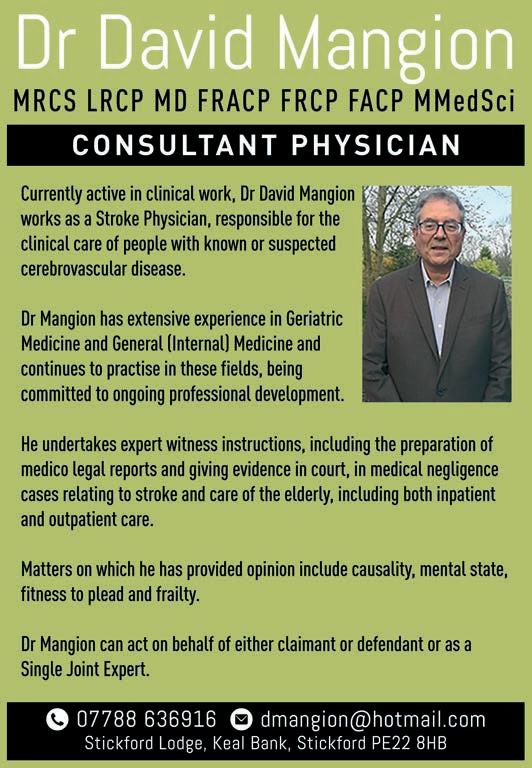

[ IN ITS Health Protection Report of 3 December the UK Health Security Agency (UKHSA) published an update on lead exposure in children in England in 2023.
Lead is a persistent, heavy metal environmental contaminant that has an adverse effect on the body even at low blood lead concentration. There is no known safe threshold for lead exposure; children and the foetus – and therefore pregnant women – are particularly vulnerable to harmful effects.
Since 2010 a surveillance system has been in place for formal notification to UKHSA from collaborating laboratories of children under 16 years and pregnant women with elevated blood lead.
The latest annual report is the seventh from the Lead Exposure Public Health Intervention and Surveillance (LEPHIS) group within UKHSA. For the first time it includes data collected from the enhanced surveillance
[THE LAW SOCIETY OF SCOTLAND has urged MSPs to make further changes to proposed criminal justice legislation because of the risk of miscarriages of justice.
Stuart Munro, the convener of the Law Society’s Criminal Law Committee, appeared before the Scottish Parliament’s Criminal Justice Committee to provide Stage 2 evidence on the Victims, Witnesses, and Justice Reform (Scotland) Bill. Mr Munro appeared alongside representatives from the Scottish Solicitors Bar Association and the Faculty of Advocates, following evidence provided by Rape Crisis Scotland and Victim Support Scotland.
In its first hearing since the Scottish Government announced its proposal for a pilot of single-judge trials was being dropped from the Bill, the committee focused on on-going plans to abolish the not proven verdict, change jury majority rules and establish a dedicated sexual offences court.
Mr Munro told the committee that Scotland’s criminal justice system is complex and unique – standing apart from other common law jurisdictions with a number of interlinked features to maintain its integrity.
“If you take away one of these key cornerstones – in this case the not proven verdict – there can be implications that then need to be considered,” Mr Munro said.
He told the committee that the changes proposed, alongside a recent High Court decision in relation to corroboration, meant that convictions based on a simple majority or 10 out of 15 did not provide adequate safeguards.
Mr Munro added: “No other common law jurisdiction does it that way. Virtually every other common law jurisdiction is 12-people juries and requires either unanimity or something very close to it.
“Our view, ultimately, is that if we are planning on a fundamental shift of our system, a fundamental removal of cornerstones or parts of the foundations, a safer way of approaching it would be to go and try a system that works, to take the jury system that, for instance, is operated south of the border.”
He indicated that the Law Society remains unsupportive of a new sexual offences court, pointing to the difficulties it would create in assessing the effectiveness of already implemented changes to improve the experience of victims and witnesses in the justice system.
Mr Munro said: “The Law Society represents solicitors from across the profession, so it’s not just those acting in criminal defence: it’s procurators fiscal; it’s those representing the interests of complainers; and we ultimately support any measures which make the system work better.”
The Law Society will be providing MSPs with suggested amendments to resolve the shortcomings identified in the bill in the coming weeks. q
questionnaires (ESQs) that are used by health protection teams to gather information on potential risk factors and lead exposure sources.
A total of 226 cases met the case definition and were notified to UKHSA in 2023. The key findings are that:
• The majority of cases (78%) were directly notified through the
• surveillance system by participating laboratories; 22% were notified
• through other routes, which is similar to previous years
• The average detection rate for England in 2023 was 21 cases per
• million children aged 0 to 15 years, although there was significant
• regional variation
• The number of cases reported to the Lead Exposure in Children
• Surveillance System are significantly lower than the estimated
• incidence of lead exposure in children in England based on
• international population survey data
• Cases are typically one to 4 years of age (67%), male (65%), with a
• significant proportion from the most deprived areas (48%)
• The most common associated reported exposures (236 completed
• ESQs out of 507) were soil (157 cases) and paint (103 cases)
• and the majority of cases exhibited pica behaviour (194) and
• learning difficulties (162)
The main messages and recommendations include that children exhibiting pica or other hand-to-mouth behaviour in environments with lead hazards are at the highest risk of exposure.
Clinicians should be aware of the risk of lead exposure for children, together with the main sources of lead exposure, the children most at risk and the presenting symptoms and signs of exposure. Those cases which meet the case definition should be notified to UKHSA health protection teams for active public health case management.
The LEPHIS group aims to increase prevention activities and raise awareness of the hazard among laboratories, clinicians and parents across England. q
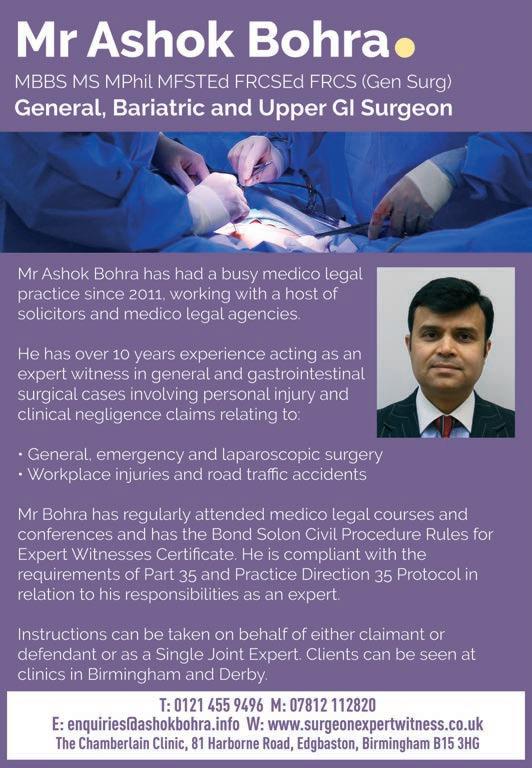


[A FORMER SOLDIER’S BID to have an Upper Tribunal decision overturned has failed in the Court of Appeal.
Christopher McCalla, who served in the army from July 2003 to November 2004, contended that the Upper Tribunal should have set aside its decision refusing permission to appeal a First Tier Tribunal disallowing a claim for extra compensation from the army for vascular problems he claimed were caused by extreme cold during his service.

He had originally been awarded compensation at a 50% level of disability because of non-freezing cold injuries that resulted in his medical discharge. But upon diagnosis of bilateral popliteal artery
entrapment syndrome in his calves he claimed an increase in the level of compensation. The claim for that and another condition was made under the War Pensions Scheme.
On 2 March 2023, the respondent rejected the claim because there was no evidence that either condition had been caused or made worse by service in the army and decided to maintain the existing 50% level of payments for the nonfreezing cold injuries which had been accepted.
He attempted to appeal that decision, a bid that was dismissed in September 2023. In December a High Court Judge refused to set aside the decision. It was that refusal that McCalla attempted to have overturned in December. q
[A JUDGE HAS RULED that a lorry driver from Liverpool was fundamentally dishonest about his injuries in his attempt to claim more than £2.3m in compensation from the NHS.
Nigel Brown’s claim for clinical negligence against Liverpool University Hospitals NHS Foundation Trust and Mersey and West Lancashire Teaching Hospitals NHS Trust was dismissed at a trial in June. His Honour Judge Richard Carter found that Brown had been fundamentally dishonest about his claim. He handed down his judgment on 26 September.
Brown, a former HGV driver, had alleged he developed fibromyalgia (FM) because of a nine-year delay in diagnosing ankylosing spondylitis (AS). He claimed £2.3m in compensation, covering injuries, lost earnings, pension loss, care and assistance, accommodation and other losses.
Evidence presented at trial at Liverpool County Court on 19 June revealed that Brown had provided false information about his employment history and earnings as a lorry driver. He had claimed he was unable to continue working as an HGV driver from 2008 onwards due to his physical symptoms.
However, it became apparent that he was working for periods when he had claimed he was not. Brown was also convicted for drink-driving and suspended from driving in 2008. Despite being unable to work due to this conviction, he falsely claimed compensation for lost earnings during that period.
HHJ Richard Carter found in favour of the NHS trusts on all aspects of liability, stating: “I do not find the claimant has proved breach of duty against either [hospital trust]. Further, I do not find that he has established that the alleged breaches of duty caused his FM, which forms the basis of his claim for damages.”
HHJ Carter concluded that by falsely inflating his earnings claim by more than £100,000, Nigel Brown was fundamentally dishonest in his

claim. The court also awarded the trusts their legal costs of the action.
Helen Vernon, chief executive of NHS Resolution, commented: “This case demonstrates our commitment to thoroughly investigate and challenge claims where dishonesty is suspected. While we always aim to compensate genuine claimants fairly, we will not hesitate to defend the NHS against fraudulent claims that divert resources from patient care.”
A spokesperson for Mersey and West Lancashire Teaching Hospitals NHS Trust added: “We welcome the court’s decision in this case. It sends a clear message about the serious consequences of attempting to defraud the NHS. We will continue to vigorously defend against all unmerited and dishonest claims while ensuring that those with genuine grievances receive appropriate compensation.” q

Dr Lina Hacker has had a highly successful first year at Oriel College, Oxford. Dr Hacker (pictured) is researching new ways to detect and investigate low oxygen levels (hypoxia) in breast cancer – a major source of treatment resistance and aggressiveness.
Tumours often have low oxygen levels because they grow rapidly, outpacing the blood supply needed to deliver oxygen and nutrients to all parts of the tissue.
One of the techniques Dr Hacker is researching is called photoacoustic imaging, which uses light to create tiny vibrations in tissue that are picked up as sound waves. That method helps doctors and researchers
‘see’ changes in the tissue, including areas with low oxygen: providing valuable insights for early cancer diagnosis and treatment.
In January, Dr Hacker was invited by the US Food and Drug Administration in San Francisco to discuss ways to bring novel early detection like photoacoustic imaging into clinical practice.
She has also presented her research at nine conferences and had 11 peer-reviewed papers published in scientific journals.
Dr Hacker has become a great advocate of the charity Against Breast Cancer (ABC), too: finding the time in July to present her work to supporters at first ABC Research Conference. In September she once again

volunteered her time as a marshal, looking after ABC’s supporters as they took part in the Breast Walk Ever. q
[NEW RESEARCH funded by Cancer Research UK shows that cancer cells are in great need of the mineral selenium, which is found mostly in Brazil nuts, seafood and cereals – and a popular ingredient in multivitamins – to keep them functioning as they try and spread through the body (metastasise). That means selenium deprivation could be the basis for a new type of triple negative breast cancer treatment. According to Cancer Research UK, around 56,800 people in the

UK are diagnosed with breast cancer each year, with around 15% of those being diagnosed with triple negative breast cancer. But there are fewer treatments for triple negative breast cancer compared to other forms of breast cancer because of the lack of receptors.
Triple negative breast cancers don’t have receptors for the hormones oestrogen and progesterone, or a protein called Human Epidermal Growth Factor Receptor 2 (HER2). That means it can be harder to treat than other types of breast cancer, as doctors can’t use hormone therapies or targeted cancer drugs.
Without selenium, however, cells are more likely to die through a process called ferroptosis. That is a type of programmed cell death: a self-destruct mechanism designed to go off when cells are in danger of causing damage or becoming cancerous.
But none of our body’s defences are perfect. The new research, published in EMBO Molecular Medicine, shows that when triple negative breast cancer cells cluster together they are able to protect themselves from ferroptosis. They produce a type of fat molecule containing oleic acid – commonly found in olive oil – which is triggered by a lack of selenium, so they can continue to grow and spread.
But if the cancer cells are away from these clusters, such as when they are moving to other parts of the body, they are more vulnerable to ferroptosis from a lack of selenium.
“We need selenium to survive, so removing it from our diet is not an option,” said Dr Saverio Tardito, who led the research. “However, if we can find a treatment that interferes with the uptake of this mineral by triple negative breast cancer cells, we could potentially prevent this cancer spreading to other parts of the body.”
He also explained why this could be so important. “It is not usually breast cancer itself that proves fatal as it can often be tackled successfully with treatment or surgery,” he said. “It is when the cancer spreads that it proves harder to control.”
Dr Tardito’s team found that interfering with the metabolism of selenium in sparse cancer cells was an effective way of killing them – particularly when they were travelling through the blood to metastasise. The team’s research could be a way to turn triple negative breast cancer from a potentially fatal disease into a manageable one.
“Outcomes for patients with triple negative breast cancer can be worse than for other types of cancer,” explained Dr Sam Godfrey, Cancer Research UK’s director of research. “Research like this could be the key to preventing this type of cancer spreading, and that would have a transformative effect on how this disease is treated.” q
By Jason Wilson of Medical Explants Ltd
[IN CASES INVOLVING medical device failure, relying solely on clinical expertise or engineering analysis may not provide the full picture.
Medical devices are highly complex, influenced by factors beyond clinical performance and design, including manufacturing processes, regulatory standards, user training and the specific requirements of each patient.
Engaging a commercial industry expert early in the process provides a valuable layer of insight, offering a holistic perspective. That approach proves particularly useful in cases assessed under the Consumer Protection Act, where courts sometimes apply a flexible interpretation of ‘defect’ to define what patients are reasonably entitled to expect in terms of safety and performance.
Well-known cases involving devices such as metal-on-metal hip replacements, breast implants and surgical mesh highlight the importance of comprehensive understanding in device litigation. In the case of metal-on-metal hip litigation, for example, the British Orthopaedic Association (BOA) underscored several inherent complexities. In addition to clinical and engineering assessments, criticisms initially raised about specific design features were ultimately withdrawn after the BOA noted that “many of these criticisms were made on the basis of incorrect factual evidence and were withdrawn. Those that were persisted with did not help or advance the claimants’ case.”
This illustrates the importance of involving commercially knowledgeable experts who can accurately assess product design, regulatory compliance and practical usage, helping to avoid misconceptions that might misdirect the legal process.
The BOA also observed that, while the hip case in question was brought under the Consumer Protection Act, it required a rigorous analysis through expert testimony and statistical assessment of data from the National Joint Registry (NJR). In that case the court relied heavily on well-supported data and adopted ‘a flexible approach to the assessment of the appropriate level of safety,’ recognising that patient expectations can vary depending on specific circumstances.
Including a commercially experienced expert thus supports a balanced and nuanced interpretation of product safety that clinical or engineering assessments by themselves might not provide.
To comprehensively assess device litigation, a review of clinical literature, registry data such as from the NJR, guidance from the National Institute for Health and Care Excellence (NICE) and product documentation is essential. A commercial expert can provide crucial clarity on each of those aspects, ensuring that the device’s lifecycle is fully understood from design and regulatory compliance to post-market surveillance and product use by clinicians.
Adverse event reporting systems, such as the MHRA’s Yellow Card scheme and the American FDA’s MAUDE database, add another dimension to medical device review. New European Medical Device Regulations now impose stricter post-market surveillance requirements on manufacturers, reducing reporting timelines and broadening monitoring duties. Field Safety Notices, published on the UK Government website, serve as public notifications on device risks and guidance for corrective measures.
Finally, enabling the manufacturer to conduct non-destructive testing on a failed device often provides vital insights into a case. Without access to the device or a clear understanding of the problem, the manufacturer’s capacity to investigate is significantly limited, which may assist their defence of any purported issues.
Including a commercial expert early in the litigation process allows legal teams to consider each dimension of a device’s safety and performance. The flexibility in interpreting the Consumer Protection Act underscores the value of commercially informed assessments that complement clinical and technical findings.

In summary, a commercially experienced expert brings insights into the multi-faceted nature of medical devices. Their expertise not only enhances the rigour of evidence presented, but also provides clarity –cutting through complex technical and regulatory details. That informed perspective is invaluable in accurately assessing safety standards and supporting objective outcomes in device litigation. q




By Mr ALEXANDER MONTGOMERY MBchB MRCS (Eng)
Depl Orth Eng FRCS (Eng)
[THE CERVICAL SPINE comprises the bones that make up the neck. Injuries to that area can be caused by road traffic accidents, falls, workplace or sports-related accidents and physical assaults. Cervical spine injury (CSI), which can consist of fractures, spinal cord injury or a combination of both, is seen most frequently in young men, but there is a second peak of incidence in the elderly population.
CSI is relatively rare, being found in only 5-10% of trauma patients. However, that part of the spine is the area most likely to be damaged and accounts for up to 50% of all spinal injuries. Furthermore, the consequences of a missed cervical spine injury can be devastating, so prompt diagnosis is vital.
CSI commonly presents with symptoms such as neck pain, torticollis, altered mental state, sensory and motor loss and respiratory arrest. Imaging can aid diagnosis and one or more of several techniques may be used. Plain radiography is usually used in children, as it is readily available, portable and the patient receives a relatively low radiation dose. Plain radiographs are generally adequate for screening alert patients who do not appear to have neurological abnormalities.
Computed tomography (CT) is the best modality for detecting bony CSI and is better than radiography for detecting fractures. It delivers a much higher radiation dose and, although recommendations are that it should not be carried out routinely in the neck area, it remains the gold standard investigative method in cases of major trauma. CT angiography can also be used as an initial screening tool to rule out significant arterial damage, the symptoms of which may not otherwise become apparent for up to 72 hours after injury.
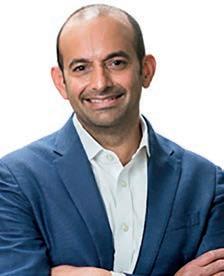
normal radiographs, may also require further imaging.
In elderly patients, age-related degeneration of the spine means that low-energy trauma can result in severe lesions, so a lower threshold for requesting imaging should be used for that patient group.
While low-risk patients only require clinical follow-up, it is vital that any immobilising precautions, such as a neck brace, are maintained until a CSI can be definitively ruled out.
Once a CSI has been diagnosed, treatment options include external fixation of the cervical spine with a rigid or soft collar, brace or halo frame. Alternatively, internal surgical fixation can be used. The method chosen will be dictated by the type and location of the injury, which will also influence outcome and prognosis.
The cervical spine is a complex structure, the components of which have different susceptibility to trauma and capacity to heal. Therefore, the outcome will depend on the degree of neurological injury, the type and severity of any bone fractures, the amount of dislocation and the stability of all the structures involved in the injury. It is also influenced by post-injury physiotherapy, which is crucial in getting the joints moving and muscles activated, so that the strength of the injured area can be gradually built up.
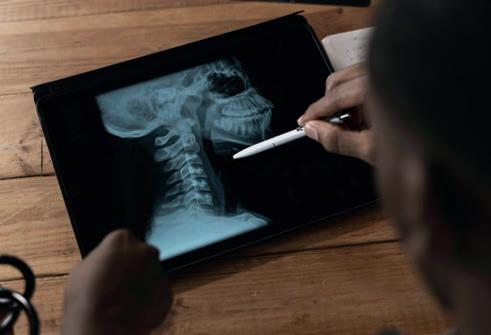
Magnetic resonance imaging (MRI) does not use radiation. Another advantage is that it is better than both radiography and CT at detecting soft-tissue abnormalities and is particularly useful at detecting cases of spinal cord injury without radiographic abnormalities. In that condition, microscopic haemorrhages affect the spinal cord in the absence of other major abnormalities. Although those lesions may only be identifiable by advanced imaging techniques, they can still be lethal, so diagnosis is vital. MRI is also useful for monitoring the progress of treatment. The disadvantages of MRI include high cost, length of screening time and limited availability.
A major issue with both radiography and CT is that patients are exposed to radiation, which can increase the lifetime risk of developing cancer, particularly of the thyroid. There is also an associated financial cost. It is therefore important to identify when imaging is really necessary, while minimising the risk of missing an injury.
In order to identify patients who require imaging, numerous tools have been developed. These seek to divide the patient population into those at low risk and at high risk of CSI. Further evaluation by imaging is only required for the high-risk group, which includes patients with neurological symptoms, those who are intubated or have a low Glasgow Coma Scale score. Patients with obvious bony injury, or high suspicion of injury despite
While the pattern of CSI in older children and teenagers is similar to that seen in adults, children aged less than eight years generally display different types of injury. That is due to the unique anatomical features found in that age group, including a relatively large head, immature neck musculature, laxity of the ligaments and horizontal articulation of the facet joints. Compared to the preponderance of sub-axial injuries seen in older patients, younger children are more likely to experience injury at the cranio-cervical junction and upper cervical spine.
That is important, because the outcome and risk of adverse sequelae is directly influenced by the location of the injury. Injuries higher up in the cervical spine are associated with higher levels of both mortality and morbidity than those lower down. Patients who damage the top two vertebrae are nearly five times more likely to die than those who sustain injuries in the C3 to C7 region. Life-changing neurological damage is also common, affecting up to 60% of patients.
CSI also has a significant effect on life expectancy, which is reduced by 6-45 years, depending on the nature of the injury. Many patients go on to develop one of two types of progressive spinal deformity: paralytic scoliosis or cervical kyphosis secondary to laminectomy. In addition, there are psychological and societal costs. q
• Mr Alexander Montgomery is a consultant spinal surgeon and regional Chair of Spinal Surgery for North East London and Essex region. Twelve years ago he established the spinal trauma unit at The Royal London Hospital (Barts Health NHS Trust), which is now the largest in the country. To find out more visit www.medicolegal-partners.com/our-experts/ mr-alexander-montgomery or contact info@medicolegal-partners.com to discuss a case.

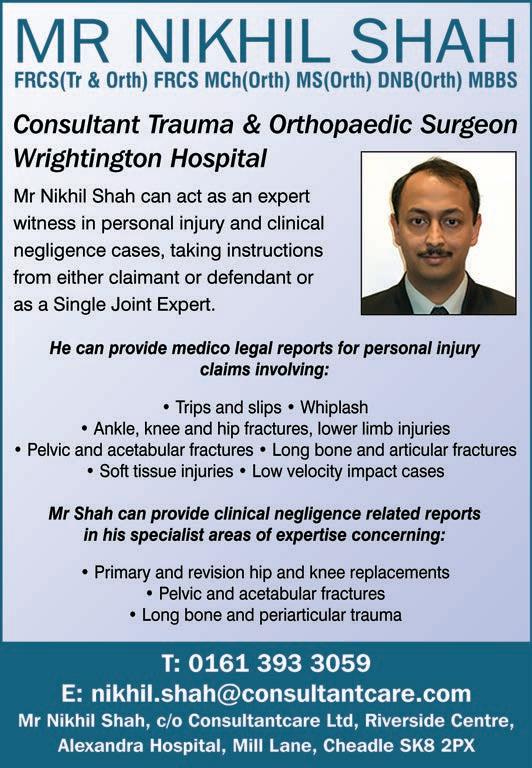


[ A NEW STUDY, led by the University of Bristol and published in PLOS Medicine, has highlighted the importance of considering the whole structure that is created when implants are put together to make up a hip replacement, rather than focusing on individual components.
The research involved analysing outcome data in the National Joint Registry (NJR) from over one million hip replacements performed in England and Wales between 2003 and 2019, to examine the relationship between implant materials and revision rates.
Researchers found that hip implants combining delta ceramic or oxidised zirconium heads with highly crosslinked polyethylene (HCLPE) liners or cups had the lowest risk of needing revision surgery over a 15-year period.
The findings offer valuable guidance for surgeons and patients in selecting the most reliable implant materials for long-term outcomes. Out of the 1,026,481 patients reviewed, 2% required revision surgery, and the type of bearing surface materials used was a key factor in that outcome.
Implants made from the ceramic and HCLPE materials consistently showed better performance in terms of durability and reduced the likelihood of future surgeries, underscoring the need for a holistic approach to choosing implant systems.
Although the research was not a

randomised controlled trial, it is one of the largest studies of its kind.
Tim Wilton, medical director of the NJR, commented: “We are always delighted
when the data from the NJR can be used by researchers to produce important research of this kind, which gives meaningful analysis to guide surgeons and patients in their decisions. An important value of the NJR data is that it allows researchers a unique insight to assess the long-term performance of different hip implant materials.
“By tracking the combinations of materials used and subsequent revision rates, this research highlights the role of implant material choice in surgical outcomes. This ensures that the materials used can be optimised for longevity and patient health.
“Surgeons would be well advised to study these findings carefully in relation to the implant choices they make, and to use the information in pre-operative discussions with their patients. As the demand for joint replacements continues to rise, this insight can be invaluable in reducing revision surgery.”
By focusing on the whole structure of the hip replacement construct, the study provides critical insights for improving surgical planning and reducing the need for revision surgeries, ultimately enhancing patient outcomes.
The findings also suggest that further research is needed to assess the costeffectiveness, rehospitalisation rates and the broader health impacts of implant materials. q
[THE GOVERNMENT’S PLAN FOR CHANGE must focus on the musculoskeletal (MSK) needs of the population to achieve its 18-weeks waiting list target this Parliament, the British Orthopaedic Association (BOA) said in a statement on 5 December. Based on the most recently available three months of data, on current trends the NHS is unlikely to achieve the government’s 18-weeks-to-treatment waiting list target for trauma and orthopaedics until November 2037.
BOA president Mark Bowditch said: “The British Orthopaedic Association welcomes the government’s attempts to reduce the waiting times patients endure for their much needed treatment. However, to achieve any meaningful reduction, the NHS must prioritise musculoskeletal health. Planned essential care for orthopaedic patients should not be cancelled each winter because there are not enough planned care beds.
“In addition, integrated care boards must fulfil their statutory duty to reduce inequalities of access and outcomes of health services for MSK patients.
“The government must also demonstrate leadership and take action to ensure that we have an adult social care service that is fit for purpose. Our growing older population is increasingly unsupported and so often find themselves in hospital when it could have been avoided, and then remain in hospital when they have no medical need to be there.
“Alongside this, the Spending Review next year must make monies
available to support prevention initiatives such as universal access to fragility fracture prevention services, support for community MSK services and also to ensure that there is sufficient capacity within our hospitals for the hundreds of thousands of trauma and orthopaedic patients who require timely treatment.” q



By Professor Paul Lee, consultant in orthopaedics and expert witness
[NECK OF FEMUR (NOF) FRACTURES are critical injuries that predominantly affect elderly patients, often resulting from falls or weakened bone structures due to osteoporosis. The consequences of a missed or delayed diagnosis can be severe, leading to greater morbidity and a more complex treatment pathway.
From a medical perspective, understanding the common pitfalls and best practices in diagnosing such fractures is essential, particularly given the medico-legal implications when cases are scrutinised.
NOF fractures require a high level of clinical suspicion, especially when dealing with vulnerable patient populations. While initial X-rays are a key diagnostic tool, their limitations must be acknowledged. Fractures, particularly undisplaced ones, can be subtle and may not always appear evident on standard radiographs. Clinicians should:
Assess clinical signs: Key elements include noting pain, inability to bear weight, external rotation and limb shortening. While the straight leg raise is often utilised, it is not definitive and should not be the sole diagnostic measure.
Employ advanced imaging: If an X-ray fails to reveal a fracture but clinical suspicion remains high, a CT scan or MRI should be ordered. That step is important, as an undisplaced fracture is much easier to manage compared to a displaced one, which can occur if the diagnosis is delayed or missed.
Radiological limitations: Initial radiographs may miss subtle fractures, particularly in patients with complex presentations. Radiologists and clinicians must be vigilant and consider further imaging when necessary. When there is any doubt, advanced imaging modalities should be the go-to approach to avoid the risk of underdiagnosing a potentially serious fracture.
Inadequate follow-up and clinical assessment: Relying solely on the initial clinical evaluation without considering the broader context can lead to oversights. For instance, if a patient re-presents with persistent pain and an inability to mobilise after a fall, reassessment and further imaging are warranted. A CT scan or MRI at that stage is needed for confirming or ruling out a fracture that was not visible initially.
Workload, bed pressure and staffing: Urgent Treatment Centres and A&E departments are often busy and staffed by junior clinicians or other healthcare professionals. That can lead to cases not being escalated for senior review or advanced imaging: increasing the risk of missed diagnoses.
The outcomes of missed NOF fractures extend beyond increased pain and delayed treatment. They can lead to:
Avascular necrosis: A delayed diagnosis can compromise blood supply to the femoral head, causing avascular necrosis and necessitating more invasive procedures, such as a total hip replacement.
Nonunion and chronic disability: Failure to diagnose and treat a NOF fracture promptly can result in nonunion, where the bone does not heal correctly: leading to long-term impairment.
Increased surgical complexity: When a fracture becomes displaced due to delayed intervention the surgical repair becomes more challenging, often requiring more complex and riskier procedures.
Comprehensive assessment protocols: Clinicians should maintain a low threshold for ordering advanced imaging when a fracture is suspected but not visible on X-ray. Training that emphasises the importance of combining clinical judgment with imaging results helps reduce the chance of a missed diagnosis.
Enhanced training and senior oversight: In busy departments where junior staff manage a significant number of patients it is vital to ensure access to senior clinical review. Regular training and clear escalation protocols can reinforce the importance of thorough assessments and appropriate imaging use.
Patient re-presentations: Any patient who returns to a clinic or emergency department with persistent pain and reduced mobility should be flagged for reassessment. In those cases advanced imaging should be a standard part of the follow-up process, to rule out or confirm an underlying fracture.
From a medical standpoint, understanding the common causes of missed diagnoses helps improve clinical practice and patient outcomes. However, it also intersects with the medico-legal world.
When cases come under legal scrutiny, expert witnesses are often required to evaluate whether standard diagnostic and management practices were adhered to. Demonstrating that appropriate imaging or escalation protocols were not followed can be a significant factor in legal cases involving allegations of negligence.
Clinicians should be aware that thorough documentation, including the rationale for ordering – or not ordering – further imaging, is very important. That not only aids in medical management, but also provides a clear record if the case is later reviewed.
Missed neck of femur fractures pose serious challenges in clinical practice. By focusing on thorough assessments, appropriate imaging and clear escalation protocols, healthcare providers can minimise the risk of missed diagnosis. Improved training, senior supervision and a high index of suspicion can bridge the gap between optimal patient care and medico-legal accountability. q
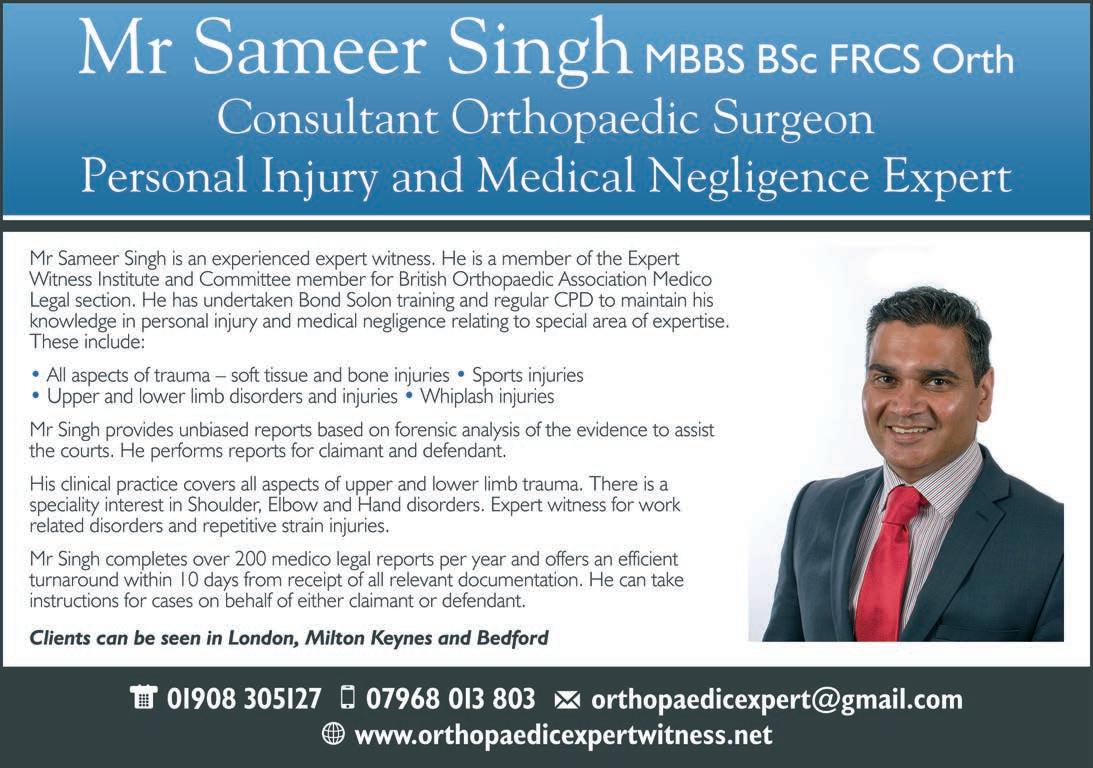
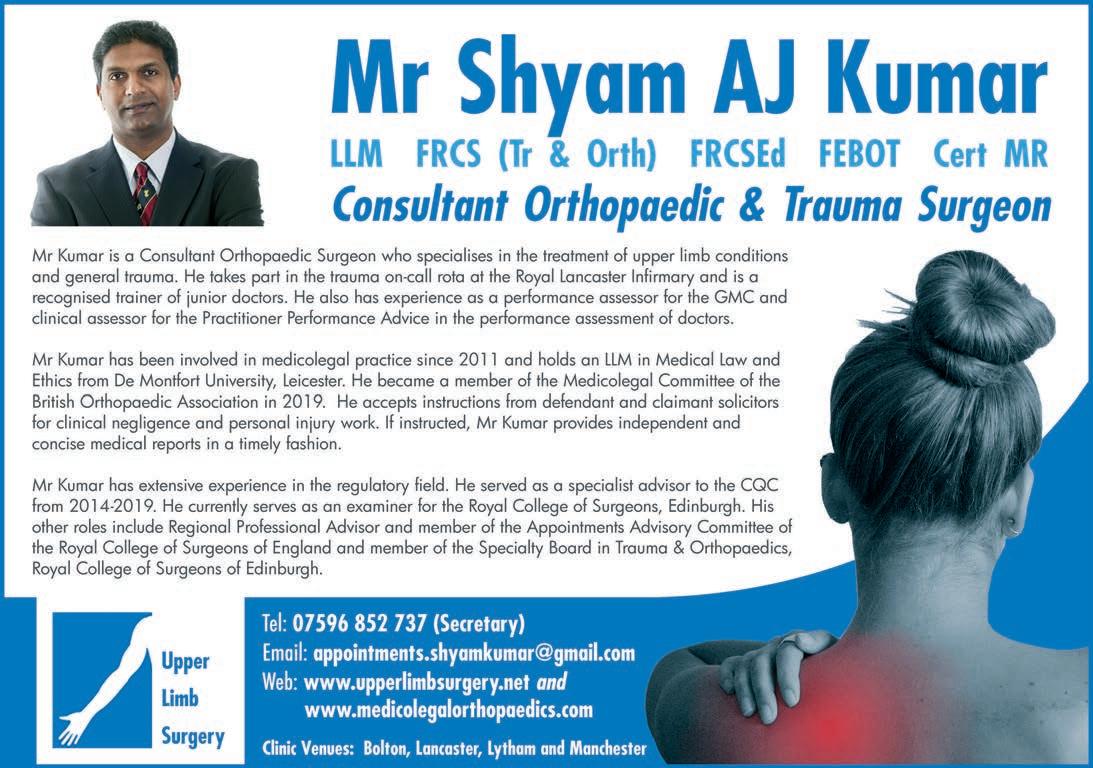
[THE National Hip Fracture Database (NHFD) has published its 2024 annual report, A broken hip – three steps to recovery. The report offers a perspective on how well older injured patients are cared for and also how that care can be improved in the future.
From initiatives to reduce waiting time for ward admission to discussions around weightbearing after surgery, the report explores all elements of contemporary care of this growing patient group.
Every year, over 70,000 people in England, Wales and Northern Ireland will fall and sustain a hip fracture. Most people now survive, so it is not enough to measure quality of care by examining mortality figures alone. This report shows how the National Hip Fracture Database captures patients’ experience and helps to answer questions about three key steps in recovery from such an injury.
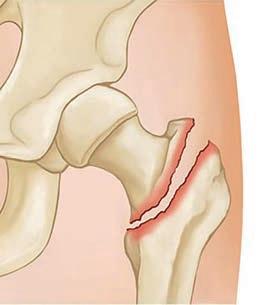
The report aims to provide readers with a simple guide to all these data and resources by describing the care that hip fracture patients should receive on their journey to recovery:
• As they first present with a new hip fracture
• As surgery allows them to get out of bed again
• Through rehabilitation until they are back in their home
Key recommendations
NHS England and the Welsh Government should use NHFD data to monitor hospitals’ delivery of three key stages of care:
• To ensure that hospitals are ready for the people they know will
• present each day, so patients receive each step of their care at the
• right place at the right time
• To ensure that all hospitals provide both prompt surgery and optimal
• peri-operative care so patients can start getting back on their feet as
• soon as possible
• To ensure rehabilitation and recovery is planned and started early,
• and continues beyond the hospital with measures to prevent
• another fracture
NHS England and the Welsh Government need to address wider inequalities and inequities in patient care:
• By agreeing a standardised approach to the collection of ethnicity
• data across all patients’ pathways and provider organisations
• By ensuring that people with other injuries benefit from the
• improvements that have been pioneered among those with hip
• fracture
Antony Johansen, NHFD orthogeriatrician clinical lead, said: This year’s report celebrates the maturity of the brilliant NHFD website as it looks at three key stages in people’s recovery from a hip fracture. The report provides simple advice and short videos so clinicians, health service managers and members of the public can easily use the live information on the NHFD website to understand and improve the care provided to people with this injury.
Will Eardley, NHFD orthopaedic surgery clinical lead, commented: “As we celebrate the release of the 2024 National Hip Fracture Database report, it is timely to reflect upon this period as the database has seen its one millionth patient entered. This landmark represents a considerable amount of knowledge gained in how best to look after older patients with a broken hip or femur.
“From such a mature and validated database it could be easy to maintain a status quo in reporting and assessing metrics of care, however this would be a waste and would not help us in moving forward to help improve how our patients experience care after breaking a hip.
“In this report we focus on key phases of care and, despite being a surgeon, I feel that the nonsurgical areas remain the most impactful domains of care where improvements can still be made. This report lays out clearly where care is still failing across countries and within individual units. Time the patient spends ‘in the wrong place’ is a particular and growing focus of attention that is highlighted this year.
“This is only one of many significant opportunities for reflection and improvement of care as we move into 2025 and we look forward to continuing the positive impact into the coming year.”
The NHFD quoted the British Orthopaedic Association (BOA) as saying: “Hip fracture surgery is carried out by members across the breadth of the BOA and is central to the care of older patients. We at the National Hip Fracture Database are delighted to release the 2024 annual report that gives perspective both on how well we currently look after our older injured patients but also in how best we can improve future care.
“From initiatives to reduce waiting time for ward admission, to discussions around weightbearing after surgery, the report explores all elements of contemporary care of this crucial patient group. We hope and ask that the report will be shared widely within the BOA infrastructure and its membership as we continue to strive to improve care for our patients with broken hips.” q




Surgical removal of the gallbladder by cholecystectomy is now the most commonly performed abdominal operation in the West, and almost all are at least begun laparoscopically.
In this article, Professor Peter Lodge considers the dangers associated with laparoscopic surgery in general and specifically damage to internal structures. That may be an injury to the small or large bowel, the bladder or a major vascular structure such as the aorta. Sadly, if not immediately recognised and repaired, such an injury can result in major complications and death.
[LAPAROSCOPIC SURGERY, also called minimal access surgery, has revolutionised the field of abdominal surgery. Minimal scarring, less pain and a shorter hospital stay are the main reasons behind the global appeal of the technique. There has been a tremendous improvement in laparoscopic surgery instruments and more complicated procedures are being successfully attempted; and now we have robotic surgery, too.
As an expert witness for general and hepatobiliary surgery primarily, I am sometimes asked to consider laparoscopic entry injuries to the bowel occurring during port placement (the initial entry into the abdomen). It is, therefore, important to understand how an injury to the bowel can occur during port placement for laparoscopic surgery. It is recognised that the most common cause of serious laparoscopic complications is related to primary trocar insertion.
Vascular injuries can also occur. Thankfully, injuries to the most major vascular structures are rare at about 0.05% of laparoscopic procedures. The sites of injury – from most common to least common – are iliac vein, omental vessels, inferior vena cava, aorta, pelvic and superior mesenteric veins and lumbar veins. Injury to a major vessel is usually signified by visible bleeding and haemodynamic instability. If an injury is suspected, immediate conversion to an open procedure and exploration of the area in question can be life-saving.
Laparoscopic surgical procedures require establishment of a pneumoperitoneum, using carbon dioxide, and placement of transperitoneal ports. There are many techniques and devices available to enable safe laparoscopic entry, but there is currently no uniform consensus as to the optimal approach.
Surgeons’ preferences for laparoscopic entry techniques vary depending on training and clinical experience. A recent Cochrane review of laparoscopic entry techniques failed to demonstrate any evidence of benefit in terms of safety of one technique over another.
The case of Palmer v Cardiff & Vale NHS Trust has defined law on laparoscopic port entry. In that case the court ruled that the likelihood of a laparoscopically-related bowel injury occurring in an uncomplicated case, if there has been good surgical technique, is highly unlikely. If there is no alternative plausible or non-negligent explanation for the complication, then the defendant is liable, in compliance with the legal maxim res ipsa loquitur (the thing speaks for itself ). That overruled the defendant’s viewpoint that injury is a recognised complication of laparoscopy and that its occurrence is therefore not proof of negligence per se
The judicial guidance accepted that, given a patient without risk factors and a surgeon following a safe technique, the risk of injury is highly improbable; thus, the occurrence of any injury under those circumstances would imply a negligent technique.
Thus, the case of Palmer v Cardiff & Vale NHS Trust established that for a patient with no previous disposing conditions or factors of any

kind, even though the claimant’s injury was a recognised complication and could occur irrespective of operative technique, the judgement was that an injury should not occur if the operator adopts an acceptable surgical technique.
All of this sounds very ‘black and white’, but it should still be possible to mount a defence if the situation is not surgically straightforward. We are often faced with patients with significant risk factors, including previous abdominal surgery, obesity, being very thin or with some unusual anatomy. It is essential, however, to make clear operative notes about risks and measures taken to mitigate them. q
• The case of Palmer v Cardiff & Vale NHS Trust was discussed by V Driscoll in the AvMA Medical & Legal Journal 2004; 10: 109-111.

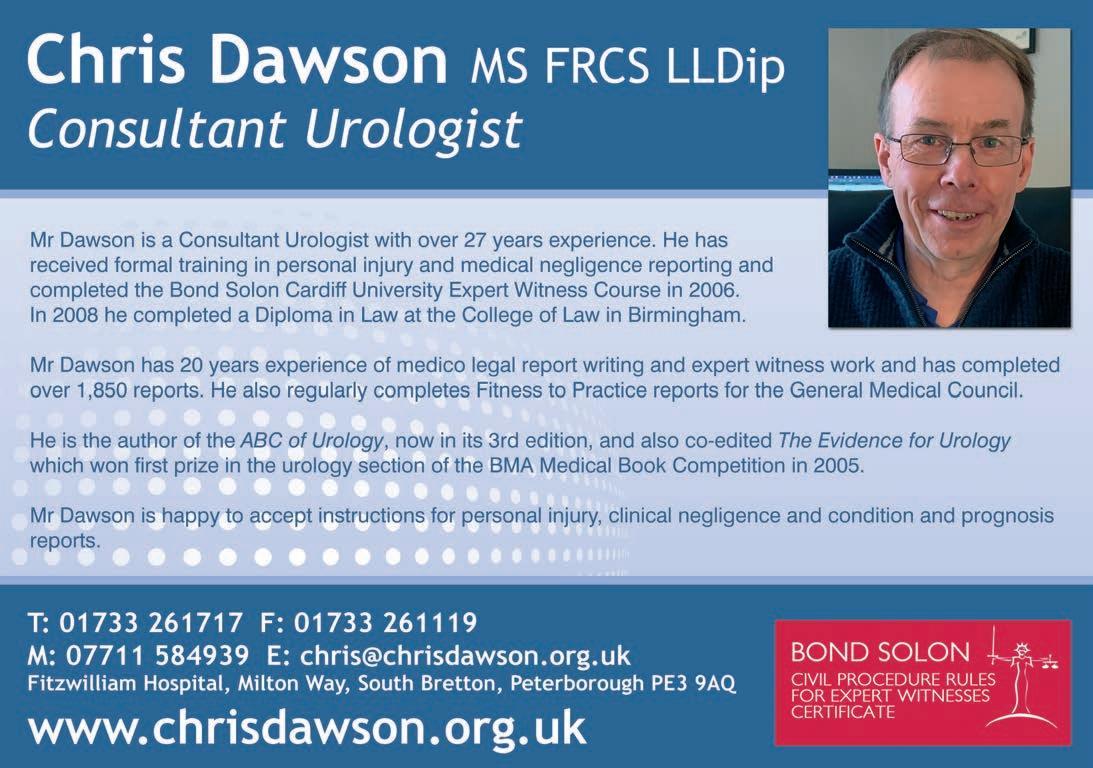
[ A SURVEY COMMISSIONED by The Urology Foundation has revealed that seven in 10 men didn’t know the role of their prostate in sex, and only one in two men knew where the prostate is located. Shockingly, only one in three men aged 18-24 knew the location of their prostate.
Interestingly the survey of 2,000 men in the UK showed that men were much more knowledgeable about female sexual anatomy, with around two thirds of men knowing where the clitoris is located.
The survey uncovered significant gaps in men’s understanding of their own bodies and urology health, showing that, while we have come a long way in terms of male understanding of the female anatomy, we still have a long way to go for men to be aware of their own sexual wellbeing.
Rebecca Porta, chief executive of The Urology Foundation, said: “It’s worrying that many men don’t know where their prostate is or what it does. It’s vital that males from a young age understand the role of their
[ FOUR YEARS AGO, the National Kidney Federation (NKF) charity initiated an annual report to increase the uptake of kidney patients receiving home dialysis treatment. The findings revealed that patients who dialysed from home had more benefits and a better quality of life than those who dialysed in hospital.
The charity’s fourth report Three Years On – published earlier this year – shows a reduction in the national percentage of kidney patients undergoing dialysis treatment at home.
Dialysis is a lifesaving treatment that removes waste products and excess fluid from the blood when the kidneys stop working properly. If the kidneys are not working to a healthy capacity waste products and fluid can build up to dangerous levels in the body and if left untreated can be fatal.
People on home haemodialysis have been shown to have a better quality of life compared to those dialysing in hospital, possibly due to the more comfortable and flexible treatment schedule that home therapies can offer. Home dialysis also allows for longer and more frequent sessions that can lead to better outcomes, including survival, and quicker recovery.
The National Kidney Federation is urging hospital trusts to develop robust plans to improve home dialysis uptake by patients. The charity’s latest report reveals systemic challenges in expanding home dialysis options, despite the proven benefits.
As part of the campaign to increase home dialysis by the NKF charity, all 89 clinical directors across the country were asked to describe their plans for the future of home dialysis and to share any examples of good practices that are in place.
A total of 29 responses were received: 23 from England, four from Scotland and two from Wales. Although there are challenges, the responses included within the report show there is significant enthusiasm from hospitals to advance home therapies nationwide.
NKF chief executive Andrea Brown commented: “Our home dialysis campaign and annual findings will continue to be shared with hospital trusts until significant improvements are achieved. Not all kidney patients are familiar with why they should consider dialysing at home and how it can help them have a better quality of life. The National Health Service is facing immense pressures, offering the opportunity for patients to undergo treatment at home is advantageous both for the patients and the NHS.” q
prostate and its location in their bodies, as well as how it might change over time. Prostate cancer rates are set to double globally by 2040, so it is crucial that men understand their prostate health, recognise their individual risk factors, know the possible signs and are empowered to take control of their prostate health.”
Key findings from the survey, which was commissioned ahead of Urology Awareness Month in September and conducted by One Poll, include:
• 61% of men could correctly identify the location of the clitoris.
• 53% of men could correctly identify the location of the prostate.
• 18-24 year olds were least likely to know the location of the prostate
• or the clitoris (38% and 41% respectively) compared to 55-64 year
• olds (58% and 70% respectively).
Men in Northern Ireland and Yorkshire and the Humber were the most likely to know their way round the female anatomy, with 71% of male respondents in both areas correctly locating the clitoris. Interestingly, men from Northern Ireland were least likely to know where their prostate is to be found: only 45%, making them nearly 58% more likely to know the location of the clitoris than the prostate.
Men were more likely to think that their prostate was involved in the flow of urine (48%) than its primary function of producing fluid that becomes semen (30%).
The prostate gland lies beneath the base of the bladder. It surrounds the urethra – a tube that transports urine out of the body from the bladder. The prostate gland’s main function is during sexual intercourse. At ejaculation, sperm is mixed with fluid from the prostate gland. A substance called prostate-specific antigen (PSA) liquidises the ejaculate to improve the chances of fertilization. The fluid produced by the prostate also prevents infection in the urethra.
In the UK, prostate cancer is the most common cancer in males with over 55,000 cases diagnosed every year. q


[THE ROYAL COLLEGE OF MIDWIVES (RCM) has welcomed the Department of Health and Social Care’s decision to remove the 2018 cut-off date to allow all those who have experienced pregnancy loss in England to request a Baby Loss Certificate.
The certificate service is a voluntary scheme to enable parents who have experienced a baby or pregnancy loss prior to 24 weeks gestation to receive a certificate providing recognition of their loss if they wish to do so.
Emma Rose, quality and standards advisor at the RCM, said: “Extending the baby loss certificate scheme is an important step in acknowledging and respecting the experiences of all bereaved parents and families. How women and families are supported
following a pregnancy loss can have a huge impact on their lives.
“The RCM continues to advocate for dedicated, well-resourced bereavement services that are delivered by staff who have specialist training and the psychological support needed to provide this care compassionately and effectively. Many women who experience early pregnancy loss receive care outside maternity services, so it’s important that this is also borne in mind in the development of support.”
While there are some excellent examples of bereavement support across the country, the RCM says perinatal mental health is not often given the priority it needs. This, it says, can impact on the level of support that women and their families receive when they lose a baby. q
[THE NUMBER OF WOMEN waiting for hospital gynaecology services would fill Wembley stadium eight times over, according to a report published on 18 November by the Royal College of Obstetricians and Gynaecologists (RCOG). More women are also now requiring emergency care to manage severe symptoms, with gynaecology emergency admissions in England increasing by a third between 2021 and 2024.
Developing the new report, Waiting for a way forward: Voices of women and healthcare professionals at the centre of the gynaecology care crisis, the RCOG surveyed over 2,000 affected women and over 300 healthcare professionals to fully understand the impact of the care crisis.
Over three quarters (76%) of women waiting for care reported worsening mental health and over two thirds (69%) reported being unable to take part in daily activities including work.
Healthcare professionals reported being deeply concerned for their patients and the majority of primary (65%) and secondary care clinicians (69%) surveyed reported their own health and wellbeing has been affected by
managing pressure in their clinics.
Additionally, over 90% of primary care professionals reported a severe impact on general practice due to longer waits for hospital gynaecology services.
A way forward is urgently needed, and the RCOG is calling on the UK Government to deliver urgent help for women currently waiting for hospital gynaecology care, and for long-term, sustained funding to address the complex systemic issues driving waiting list growth.
Waiting for a way forward was funded by Theramex and follows on from the RCOG’s 2022 Left for Too Long report. It makes recommendations on how governments can support the health system to deliver high quality gynaecology care across the UK.
RCOG president Dr Ranee Thakar (pictured) said: “A way forward is urgently needed to tackle the UK gynaecology crisis. Our new report shows too many women are waiting too long with serious conditions that can devastate their lives. NHS staff are also deeply concerned and distressed that they do not have the necessary resources to deliver good care, affecting their own wellbeing.
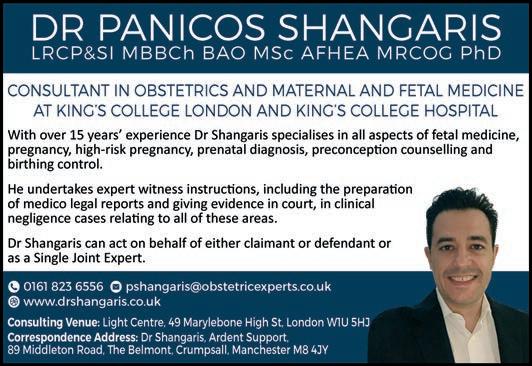

“UK governments must act now. The RCOG is calling on them to commit to long-term, sustained funding to address the systemic issues driving waiting lists, alongside delivering an urgent support package for those currently on waiting lists.
“This investment will not only benefit thousands of individual women but the wider economy too, because the evidence shows that healthy women are the cornerstone of healthy societies. Get it right for women and everyone benefits.” q

[ THE Royal College of Obstetricians and Gynaecologists (RCOG) has launched a new animation to support the informed consent process for pregnant women and birthing people planning a caesarean birth.
The crucial conversation takes place between an individual and their clinician ahead of having a caesarean, discussing the key associated risks they should be informed of before the birth.
The new animated resource should be used in tandem with the RCOG Consent Advice on Planned Caesarean Birth and should supplement, not replace, individual conversations between women or birthing people and clinicians, as part of an informed consent process. Importantly, the resource is also not intended to be used as an aid to decide whether or not to have a caesarean birth.
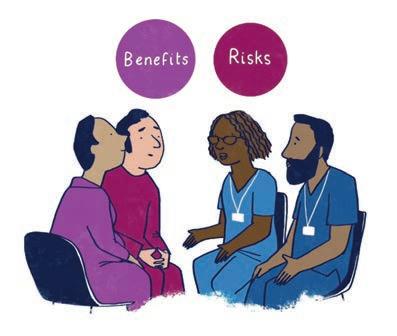
RCOG vice president Dr Geeta Kumar explained: “Once a pregnant woman or birthing person has decided to have a planned caesarean birth, the consenting process involving an informed discussion with their health care professional is a really important step. We produced this resource to support such consent conversations, setting out in simple terms and imagery the key issues that should be covered.
“We’re hugely grateful to all of the individuals and organisations who helped to develop this animation and sincerely appreciate the feedback from our women’s network members. This was really important in making sure the information presented is informative and accessible, and the needs and preferences of women and birthing people were at the forefront throughout the development process. I’d also like to thank
the members of our clinical quality team who worked on this project, and our Patient Information Committee chaired by Dr Rosemary Howell.”
The animation covers some of the benefits women can expect from a caesarean before some key associated risks, including pain, infection and bleeding – comparing them against the level of risk for vaginal birth where possible. It draws on clinical and public information from the National Institute for Health and Care Excellence.
Involving women, birthing people and birth partners and organisations with an interest in pregnancy and childbirth, as well as obstetricians, was a very important part of the animation production process. Members of the RCOG Women’s Network, as well as organisations including the Birth Trauma Association, attended a workshop in the early stages to feed in views and suggestions, and there was also a user testing workshop as the animation started to take shape.
Jane Plumb, chair of RCOG’s Women’s Network, commented: “This new video is an excellent resource for pregnant women and individuals about elective caesarean births. It provides clear, accessible information about the risks and benefits, including comparisons with vaginal births.
“This video can help people prepare better for discussions with their healthcare professionals, helping them to make informed decisions about their care. Patient-centred resources such as this can help improve communication and informed decision-making in maternity care.” q

[ NEW RESEARCH from University College London Hospitals NHS Foundation Trust (UCLH) has highlighted the importance of people with sudden hearing loss receiving medical treatment as quickly as possible.
The researchers collaborated with 240 junior doctors on the largest study to date of adults who were seen with sudden hearing loss across 76 hospitals in England and Wales.
Sudden hearing loss, also known as sudden sensorineural hearing loss, takes place in the inner ear and sometimes happens overnight. For people who are not treated quickly it can cause permanent hearing loss.
Unfortunately, sudden hearing loss can be confused with temporary causes of hearing loss, such as ear wax or infection, meaning some people might not access diagnosis and treatment until it is too late to recover their hearing.
importance of rapid treatment
The team of clinician scientists at UCLH have identified the factors which predict full hearing recovery, with the strongest being treatment with steroids within seven days of a sudden drop in hearing.
Analysing the data, the team found that patients who received steroids within seven days were five times more likely to fully
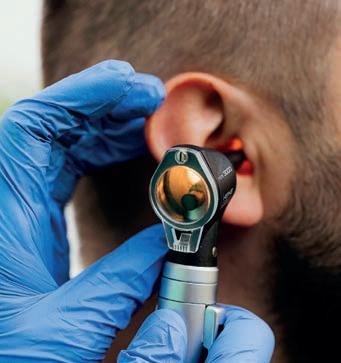
recover their hearing compared to those who were not given steroids, even after all other factors were considered.
The findings were outlined in the journal
JAMA Otolaryngology – Head & Neck Surgery
The research also found that only about 60% of those patients were treated within that critical window. It led the researchers to develop an online tool that can predict the chance of full hearing recovery in adults presenting with sudden hearing loss.
UCLH ENT surgeon Mr Nish Mehta led the research. He said: “Time is of the essence when it comes to restoring hearing after

sudden hearing loss. It is important that patients who experience a sudden drop in their hearing seek urgent medical attention.
“It is also important that the medical teams who first see these patients either arrange appropriate urgent specialist review or consider steroid treatment if the specialist review is unlikely to occur within the appropriate timeframe.
“Consultations between specialists and patients can now benefit from precise predictions on the chance of full hearing recovery if our free online calculator is used. This information can be used to guide shared decision making between specialists and their patients regarding treatment and follow up plans.”
The importance of prompt treatment was echoed by Franki Oliver, audiology manager at the RNID, who said: “This research confirms that if you suddenly lose your hearing – either in one or both of your ears – getting treatment quickly is key. A sudden change in hearing is not always serious, but it could be a medical emergency.
”Research like this is incredibly important. As the UK’s only charity dedicated to funding hearing research, RNID is committed to supporting researchers so that together we can find effective treatments for hearing loss and tinnitus.” q

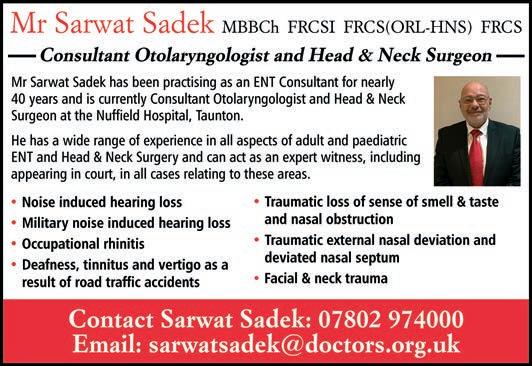

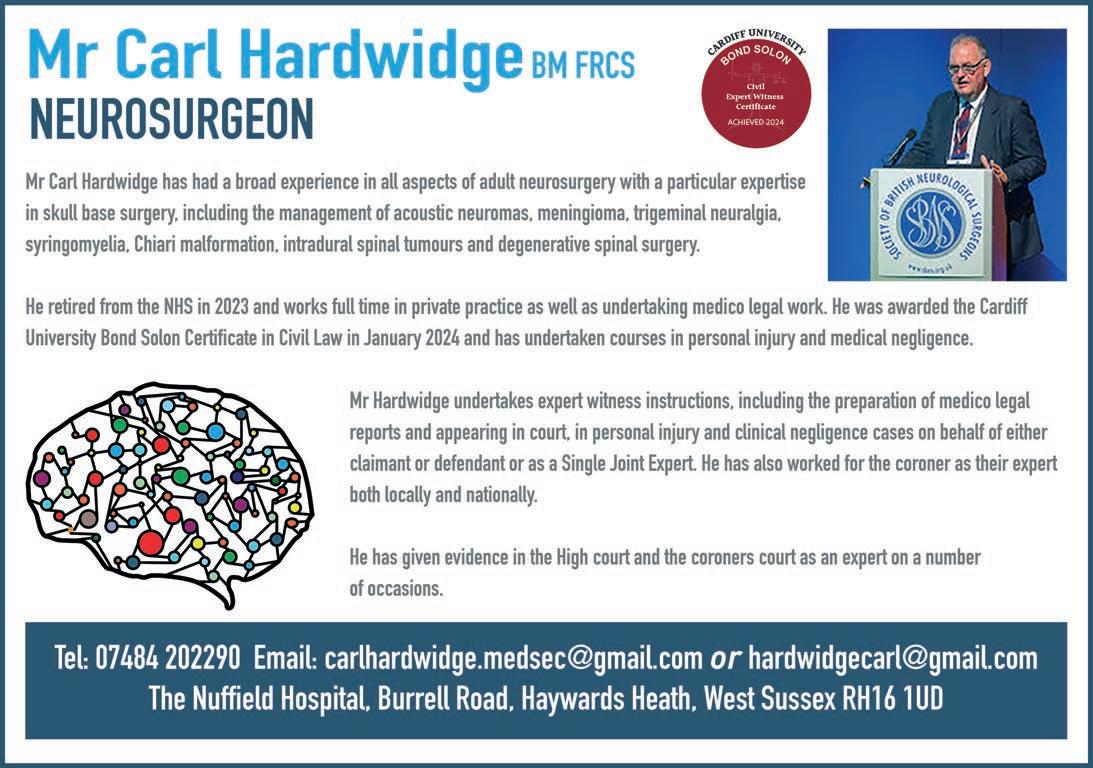
[A PIONEERING RESEARCH STUDY at Addenbrooke's Hospital in Cambridge will trial new treatments for people in the UK living with glioblastoma, an aggressive form of brain cancer.
The trial will enable researchers to adapt the treatment provided to each group of participants, meaning several new drugs can be tested in a short period. As part of the trial every patient will also have their genome sequenced, enabling researchers to target their treatment with greater precision.
Glioblastomas are the most common type of cancerous brain tumour in adults, making up nearly a third (32%) of primary brain tumours diagnosed in England between 1995 and 2017.
Due to the unique biology of the brain, however, finding new treatments has proven difficult. There have been over 1,000 brain cancer clinical trials over the past two decades, but these have not yielded significant breakthroughs.
To help address that, Cancer Research UK and Australian charity the Minderoo Foundation are each committing £1.68m to fund the ‘next-Generation aGile Genomically Guided Glioma platform trial’, also known as the 5G platform trial. The hope is that the unique approach taken by the trial will help speed up the development of new treatments while benefitting patients.
It is taking place in partnership with the Minderoo Precision Brain Tumour Programme, which is sponsored by Cambridge University Hospitals NHS Foundation Trust and the University of Cambridge.
performed in ‘real time’ enables us to be both agile and precise in our drug targeting. We hope that this approach will help patients with this cancer of unmet need.”
The first 5G platform trial sites opened in Cambridge and London in August, with further sites planned to open across the UK as the study progresses. The drugs used in the study will be provided by pharmaceutical industry partners.
The study is a world-first adaptive clinical trial platform for patients with brain tumours. The drug or drug combination a patient receives will be based on the specific genetic makeup of their cancer. The trial design also allows treatments developed for other types of cancer to be trialled in patients with brain cancer for the first time.

Dr Richard Mair, consultant neurosurgeon at CUH and co-lead of the Brain Cancer Virtual Institute at the Cancer Research UK Cambridge Centre, and Dr Juanita Lopez, consultant medical oncologist at the Royal Marsden NHS Foundation Trust and the Institute of Cancer Research in London, will co-lead the trial.
Dr Mair commented: “Brain cancers like glioblastoma are notoriously difficult to treat. I am excited to co-lead this world-first trial designed with this cancer type in mind.
“The use of whole genome sequencing for every patient on the trial

Incorporating flexibility into the design means that the drugs given to patients can be changed as real-time data is collected and incorporated, making it easier for researchers to try several treatment options across different groups of patients. This both benefits the trial itself and improves the likelihood of a positive outcome for participants.
Dr Lopez said: “We have seen progress made in better treating many types of cancer in recent decades, but less so in brain cancers like glioblastoma. The 5G platform trial presents a unique opportunity to work in new and exciting ways to find better treatment options for this patient population.”
This targeted treatment approach underpins the vision of the new Cambridge Cancer Research Hospital, a partnership between Addenbrooke's Hospital, the University of Cambridge and the Cancer Research UK Cambridge Centre.
By bringing world-leading scientists and clinical expertise together, the new hospital will deliver breakthroughs and innovations to change the way we detect and treat cancer, to diagnose the disease at a much earlier stage and deliver personalised, precision medicine. q

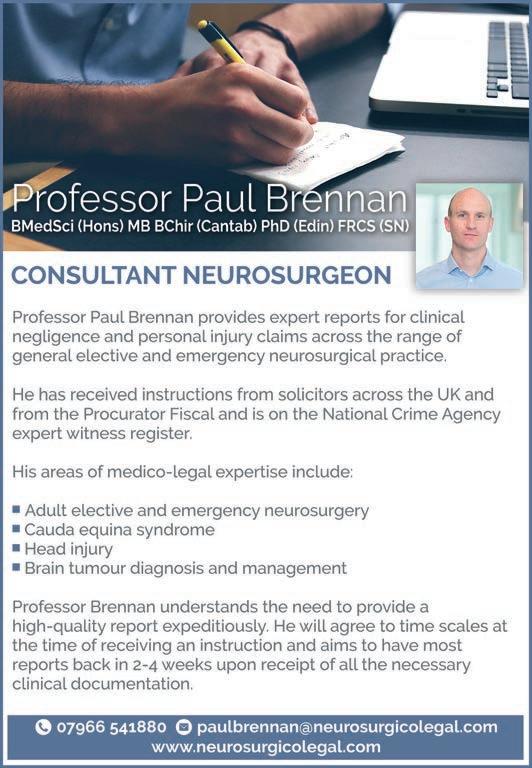


By Jamie Rhind, client support manager at JMW Solicitors
[THE NATURE OF A BRAIN INJURY means that a case manager is often required to guide the injured person through the complex recovery and claims process. Case managers play an important role in conducting an immediate needs assessment, helping to identify the best possible outcomes which are tailored to the individual’s circumstances. Case managers collaborate extensively with the individuals’ legal teams, healthcare providers and social care services to co-ordinate the best possible support for the client and their family.
The primary aim of case management is to maximise the client’s quality of life. That involves advocating for the client in all aspects of their life and ensuring they have access to the most appropriate rehabilitation services and equipment. Case managers work closely with the client, their family and their support network to provide the clinical support and expertise necessary throughout the litigation process, ensuring comprehensive and continuous care.
Managing severe, complex and catastrophic injuries – such as musculoskeletal, psychological, orthopaedic, brain injuries, burns and spinal injuries – requires tailored rehabilitation plans and timely interventions. Case managers facilitate communication between all parties to ensure the client’s needs remain the priority. In this role, the case manager oversees the complete care and rehabilitation of the injured person, helping the client to meet their rehabilitation goals and rebuild their lives
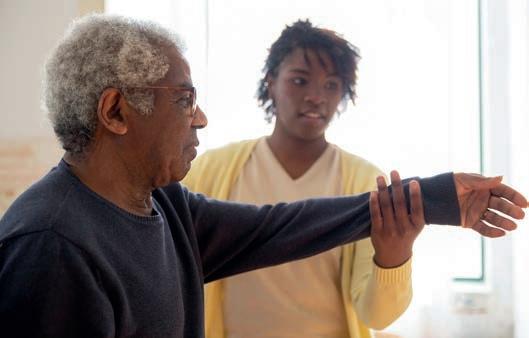
Case managers have a multi-disciplinary approach to make sure that the client’s needs are being met – marrying care, rehabilitation, reintegration (home and, where appropriate, work) together to provide a holistic service.
The case manager begins by conducting a thorough initial assessment to determine the client’s needs. That assessment forms the foundation for developing a personalised care plan, often involving a team of healthcare professionals. The care package’s effectiveness is continuously monitored, with adjustments made as needed to address changing needs or new challenges.
Where it is identified that an injured person may benefit from additional specialist rehabilitation, a case manager will often take the lead in assessing the most appropriate setting. Considering factors such as location, services provided and cost, the case manager will normally facilitate the transition to the chosen residential setting,
ensuring all necessary arrangements are made and the client is comfortable.

In planning for discharge, if the client can remain in their original home then an assessment of their home environment is undertaken. That allows the case manager to identify necessary adaptations to promote independence and accommodate therapy and care needs. They collaborate with architects, builders and therapists to design and implement home modifications, such as installing ramps, widening doorways or creating accessible bathrooms.
As part of the assessment, equipment should be identified to enhance the client’s independence, comfort and safety. Case managers facilitate the procurement of necessary equipment and provide training to the client and their caregivers in its use. Ensuring the equipment is properly maintained and upgraded to meet the client’s evolving needs is also part of the case manager’s responsibilities.
A case manager must liaise between the client and various statutory services, including health and social care. The case manager ensures that these services are regularly reviewed, and then advocates for additional services or changes to existing ones if the client’s needs are not being adequately addressed.
That includes assessing the client’s need for various therapies, such as physical, occupational, speech and psychological therapy. They coordinate with both statutory and private therapy providers to ensure a seamless integration of services into the client’s rehabilitation plan. The client’s progress is regularly monitored, and therapy plans are adjusted as needed to maximise benefits.
The case manager researches and identifies suitable activities to promote the client’s rehabilitation and social inclusion. Customised programmes are developed, including activities such as hydrotherapy, outdoor pursuits, vocational rehabilitation and access to social and leisure groups. The case manager facilitates and encourages the client’s participation in such activities, ensuring they have the necessary support and resources.
A case manager can also research potential social and leisure activities to align with the client’s interests and abilities. They can plan the logistics of participation, including transportation, accessibility and any required support to ensure a fulfilling social life.
Pursuing a legal claim can provide the financial resources necessary for comprehensive rehabilitation, care and the services of a case manager. That funding is crucial in covering the costs associated with tailored rehabilitation plans, ensuring that all aspects of the client’s recovery are adequately addressed. The case manager often works closely with legal teams to document the client’s needs and progress, providing essential evidence to support the claim.
Rehabilitation case management is an important component in the recovery process following a brain injury. Case managers provide critical support and co-ordination, ensuring that the client’s needs are met through a multidisciplinary approach. By advocating for the client and facilitating comprehensive care and rehabilitation plans, case managers play a crucial role in enhancing the quality of life and maximising the potential of individuals recovering from serious injuries.
Through their dedicated efforts, case managers help clients navigate the complexities of rehabilitation, empowering them to achieve their highest possible level of independence and well-being. q
[RESEARCH FROM brain injury charity
Brainkind has revealed that one in two people who have experienced domestic abuse in England and Wales may be living with a brain injury. That compares to the prevalence of traumatic brain injury in the general population which is approximately one in 12.
The new report, Too Many to Count, is the first study in the UK to explore the prevalence of brain injury in people who have experienced domestic abuse and access community-based services.
Brainkind spoke to 60 women, 33 of whom screened positive for a history indicative of brain injury. The research found that four fifths of participants who had experienced domestic abuse had suffered a serious blow to the head, while three quarters of participants who had experienced domestic abuse had been held at least once in a way that prevented them from breathing. People who screened positive for a history indicative of brain injury were more likely to experience moderate to severe post-concussion symptoms, low mood and post-traumatic stress.
Exploration revealed a significant overlap between brain injury and mental health
symptoms. That highlights not only the risk of incorrect diagnosis, but also the complexity of accurately identifying brain injury in this population.
Brainkind has called for improved provision of the appropriate support services for people who have experienced domestic abuse. The charity wants to bring brain injury and domestic abuse to the forefront of national discussion and action. It hopes this research will prompt a new approach, changing policy and practice.
Among the report’s recommendations Brainkind stresses the need to:
• Understand the links between brain injury and health inequalities for people who have experienced domestic abuse
• Work with people who have experienced domestic abuse to develop tools and resources that will enable individuals to advocate for themselves and communicate their needs clearly
• Train domestic abuse practitioners to raise awareness and increase identification of brain injury, including understanding individual needs and ways to adapt practice
• Promote inclusion and recognition of brain injury and its impact on people experiencing domestic abuse in future policy, as well as any

potential revisions made to the Domestic Abuse Act 2021
Stephanie Bechelet, domestic abuse and brain injury researcher at Brainkind, commented: “Our research findings highlight the complexities faced by people who have experienced domestic abuse. These issues are compounded by our evidence that reveals one in two people who have experienced domestic abuse may be living with brain injury. Our recommendations focus on how we can work together to close the gaps in knowledge and practice around domestic abuse and brain injuries.”
Dr Annmarie Burns, consultant clinical neuropsychologist at the charity, added: “As experts in brain injury, we are grateful to all participants who contributed to this research. We are committed to working with people who have experience of domestic abuse.
“We want to undertake more research and co-produce training to help those working in domestic abuse services to identify brain injury. We also want to see future policy and legislation recognise brain injury and its impact on people experiencing domestic abuse.” q

by Dr Sarah Gillanders and Dr Blanca Poveda of Edinburgh Neuropsychology Ltd
[POST-TRAUMATIC STRESS DISORDER (PTSD) is a psychological condition triggered by exposure to a traumatic event and is characterised by symptoms including intrusive memories, hypervigilance, anxiety and avoidance. Many people experience at least some PTSD symptoms after extremely threatening events, which usually subside of their own accord after days or weeks; however, a significant number of people go on to develop PTSD. When PTSD occurs alongside Traumatic Brain Injuries (TBI) – be it a mild, moderate or severe TBI – the condition becomes more complex, requiring specialist assessment and treatment.
Neuropsychologists play a crucial role in assessing PTSD in the context of a TBI in the medico-legal setting and can also provide treatment to help the individual navigate the intertwined effects of psychological trauma and neurological damage.
The assessment of PTSD in individuals who have sustained a TBI is a complex process that involves taking into consideration psychosocial factors that pre-date the traumatic event, the nature of the trauma itself, neurocognitive factors related to the TBI and post-trauma factors such as recovery from polytrauma and social support.
Neuropsychologists are trained to recognise the overlapping symptoms of PTSD and TBI, such as cognitive impairments and emotional disturbances. They use information obtained from clinical interviews, behavioural observations and collateral information from those who know the individual well, and standardised neuropsychological measures to evaluate cognition and psychological functioning.
It is important to highlight that assessments are trauma-informed and involve gentle questioning, collaboration and a calm, non-judgemental interview manner, combined with careful, systematic assessment and critical thinking.
An important aspect of the neuropsychological assessment process is the use of cognitive testing to measure a range of cognitive skills, including memory, attention, speed of information processing and executive functioning. Those tests help determine the extent of the brain injury and differentiate between deficits caused by the physical impact of the injury and those arising from PTSD or other factors such as fatigue, pain and medication. For example, while memory and concentration problems are common following a TBI, PTSD can also lead to difficulties in those domains. Neuropsychologists use their expertise to provide opinion on those complexities, ensuring accurate diagnosis and appropriate treatment recommendations.
The interplay between TBI and PTSD is complex and bidirectional. Brain injuries can exacerbate PTSD symptoms and PTSD can, in turn, impact on the recovery process of a brain injury. That can include the trajectory of an individual’s cognitive recovery, psychological well-being, interpersonal relationships, emotion regulation, employment prospects and ability to engage in social and leisure activities – all of which are important considerations within the medico-legal context.
By recognising how PTSD and TBI symptoms interact, neuropsychologists can provide information to the courts about prognostication, make treatment recommendations and tailor interventions to address both conditions simultaneously. This holistic approach is vital for improving the patient’s overall quality of life and facilitating long-term recovery.
Neuropsychologists use a range of therapeutic techniques to treat PTSD in patients with TBI. Trauma-focused Cognitive-Behavioural Therapy (CBT) and Eye Movement Desensitisation and Reprocessing (EMDR) have strong evidence bases with positive outcomes for PTSD.
Experienced neuropsychologists can modify those approaches, as well as drawing on other models, including acceptance and commitment therapy and compassion-focused therapy, to deliver bespoke interventions that take
into consideration an individual’s cognitive abilities – ensuring that therapy remains effective and accessible.
In addition to highly specialist psychological therapy, neuropsychologists may employ neurorehabilitation techniques to improve the cognitive functions that may be impaired by brain injury. Those techniques include cognitive exercises designed to enhance memory, attention and executive functioning. By combining psychological therapy with cognitive rehabilitation, neuropsychologists provide a comprehensive intervention that addresses both the psychological and neurological aspects of PTSD and brain injury.
In conclusion, neuropsychologists can play an important role in the medico-legal assessment and treatment of PTSD in individuals with a TBI. Their specialised skills enable them to distinguish between the overlapping symptoms of PTSD and TBI, develop tailored treatment plans and collaborate with other healthcare professionals to provide comprehensive care.
Neuropsychologists assist patients to navigate the complex interplay between psychological trauma and neurological damage, facilitating recovery and improving quality of life. q
• Both Dr Gillanders and Dr Poveda are experienced clinical neuropsychologists who combine their time between the South East of Scotland Major Trauma Service at the Royal Infirmary of Edinburgh and medico-legal report writing and psychological therapy at Edinburgh Neuropsychology Ltd.
They have extensive clinical experience in acute and community settings of working with individuals affected by trauma and TBI. That breadth of experience gives them the expertise to act as expert witnesses in cases where individuals with TBI and PTSD require a comprehensive neuropsychological medico-legal evaluation.


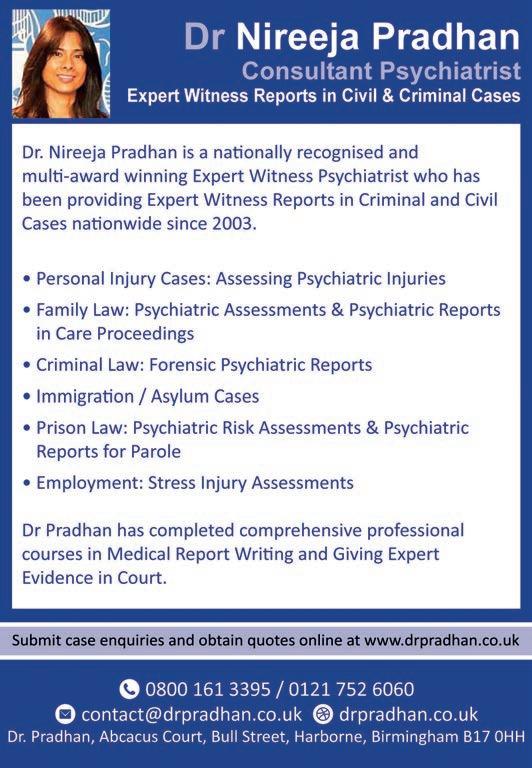
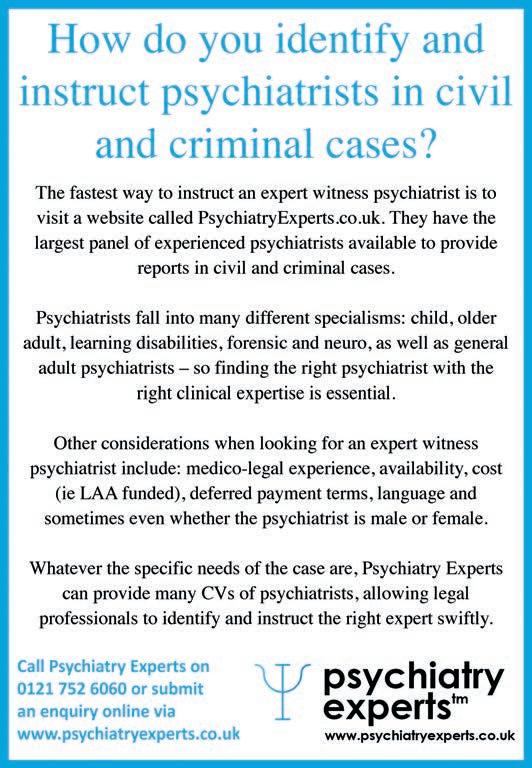
[NOVEMBER SAW the second reading in the House of Lords of the Mental Health Bill, which aims to modernise the current legislation to ‘better support patients, treat them more humanely and address disparities’. The reforms will introduce statutory care and treatment plans, end the use of police and prison cells to place people experiencing a mental health crisis and end the inappropriate detention of autistic people and people with learning disabilities.
It will also foster the greater involvement of patients, families and carers to improve treatment while protecting patients, staff and the wider public.
Responding on behalf of the British Psychological Society (BPS), its president Dr Roman Raczka said: “The Mental Health Act has long required reform to ensure it is fit for purpose. The second reading of the Bill in the House of Lords is another positive step in the right direction to make this a reality.
"It was encouraging to see the BPS's call for a review of the Building the Right Support action plan discussed. Without necessary and additional investment in community-based services the proposed changes to remove autism and learning disability from section three of the Act could have potentially harmful unintended consequences. The changes might inadvertently result in criminalising the very individuals the Act aims to protect. A review is essential to ensure that people with learning disabilities and autism can be supported to live in the community.
"This, and many other parts of the proposed Bill, can only be achieved with an increase in the psychological workforce, as well as greater funding for the sector. This will be crucial to ensuring patients get the support they need and in the most appropriate settings. We will continue to work with the UK and Welsh governments to make sure those experiencing severe mental health issues are able to access the right support, from the right professionals, as quickly as possible."
The president of The Royal College of Psychiatrists, Dr Lade Smith CBE, said: “Having been part of the original Wessely review, I am delighted that the Bill is being introduced to Parliament. This is an historic opportunity to improve the Mental Health Act and the lives of those with mental illness in England and Wales.
“Care and treatment plans are part of good, modern psychiatric practice and making them statutory will ensure the system supports the partnership between the psychiatrist and the patient.
“We welcome the fact that people with mental illness will have more choice about which of their family and friends can be contacted if they are detained. This will give patients the confidence that the people who know them best and care about them most will have the opportunity to speak on their behalf, when they are not able to speak for themselves.
“The college worked closely with the independent review led by Professor Sir Simon Wessely to make recommendations about Mental Health Act reform, but since the review was published changes have been made which could not have undergone the same level of development, discussion and scrutiny as the original work. Today’s Bill diverges in significant ways from the recommendations set out in the review and does not take full account of the Joint Committee’s thoughtful and constructive recommendations.
“We remain concerned about proposed changes to the provisions in the Act for the treatment of those primarily experiencing learning disability or autism. There are times when community services are unable to manage the levels of risk some patients present with, and it takes some time to ascertain whether this is related to co-occurring mental illness.
“If the Mental Health Act cannot be used to support them, such patients will be brought into A&E, where they will remain; or if there are concerns about their behaviour compromising the safety of others, then this will result in involvement of the police and criminal justice system.
“Additionally, these reforms create distinctions between the decision making around detention between the civil and criminal parts of the Act. This will have the unintended consequence of widening the racial

disparities that the original Wessely review was commissioned to reduce. The principles of the Act and the rights provided should apply to all patients. Distinguishing between the criteria for detention for different parts of the Act will only serve to introduce a disparity that will disproportionately affect Black people, one that did not exist in the Act before.
“The current focus from Westminster on the NHS and mental healthcare is positive but it will only be effective if services are provided with the resources they need to deliver timely, skilled and compassionate care.” q

[THE ROYAL COLLEGE OF PSYCHIATRISTS (RCPsych) has responded to the passing of the Second Reading in the Commons of the Terminally Ill Adults (End of Life) Bill. The Bill was brought forward as a Private Members’ Bill by Kim Leadbeater MP.
A RCPsych spokesperson said: “In a significant societal shift, MPs have today voted in favour of moving the Terminally Ill Adults (End of Life) Bill through to the next stage of the Parliamentary process. We heard debate around consent procedures, palliative care and what the passing of legislation could mean for vulnerable people, doctors and the NHS.
“Surveys of our members showed a similar number of psychiatrists support and oppose proposals for assisted dying/assisted suicide for people with terminal illness, reflecting the complex and sensitive nature of the issue.
“There are a number of unanswered questions about whether it is possible to provide adequate protections and safeguards for all individuals and, if so, what these measures would be. The college believes these details must not be left to the relevant professions to be dealt with through amendments to existing or new codes of practice.
“As the Bill progresses to the next stage, RCPsych is urging parliamentarians to carefully consider outstanding questions about whether a person’s capacity to decide to end their own life can be reliably assessed and the adequacy of consent as a safeguard against coercion in this context.
“It is also important to consider the potential implications for those with mental disorders, intellectual disabilities and neurodevelopmental conditions, who do not always have good access to palliative care, as well as on suicide prevention efforts, palliative care and the NHS.
“The college will continue to work closely with parliamentarians and other stakeholders on this important issue.”

The Bill states that the assessing doctor “may, if they have doubt as to the capacity of the person being assessed, refer the person for assessment by a registered medical practitioner who is registered in the specialism of psychiatry in the Specialist Register kept by the General Medical Council or who otherwise holds qualifications in or has experience of the assessment of capability…”
A survey of RCPsych members in England, Wales, Northern Ireland and the Crown Dependencies showed:
• An equal number of psychiatrists oppose and support AD/AS
• proposals for people with terminal illness. Of those who
• responded to the survey, almost half (45%) opposed or strongly
• opposed and an equal proportion (45%) supported or strongly
• supported proposed AD/AS legislation that require a person to
• have a terminal illness, valid consent, be over 18 and where life
• ending medication is self-administered.
• A majority (64%) of respondents opposed policies that widen
• eligibility to include suffering in mental disorder, while 18%
• supported such policies.
• Almost two thirds (65%) of respondents were not confident
• that consent can act as a safeguard against people making
• unfree choices, including, for example, those made due to
• lack of information, coercion or the effects of psychopathology
• on decision making. Almost one third (31%) were confident.
• Over half (58%) of respondents said they would not be willing
• to participate as a medical professional in an AD/AS service,
• including determinations of capacity or assessing for mental
• disorder, if it became law in the UK: 30% of respondents said
• they would be willing to participate. q

Lisa Crowther, of Carter Brown, reviews
[ON 16 OCTOBER the Ministry of Justice held an Experts’ Symposium in Cardiff. Sir Andrew McFarlane, President of the Family Division, set out his vision for the family court over the next two years, with contributions from a number of professionals in the sector.
In 2021 the Department for Education (DfE) commissioned research into drivers for delay in family proceedings, which was published in May 2022. Drivers for delay were found to be the duration of proceedings, the number of hearings and the number of non-LA assessments in proceedings.
The rationale behind SIHIS was to bring head injuries in children under a clinical umbrella through a multidisciplinary team approach, alongside directly addressing the number of non-LA assessments: a topic discussed at the last experts’ symposium in 2022.
Dr Stivaros, a consultant paediatric neuroradiologist at Manchester Children’s Hospital, stated his view that increased exposure to higher volumes of cases increased expertise. He stated that professional challenge is crucial and encourages learning from peers within the multidisciplinary team. One of the core aims of the pilot is to promote ‘equitable, high-quality medical care’, although that is not intended to be a replacement for Part 25 expertise.
Speakers from all SIHIS sites reiterated the benefits of the multidisciplinary approach. The pilot currently has another six months to run.
Dr Fiona Straw, a community paediatrician seconded to the DfE, felt it was helpful for clinicians to have a mechanism to discuss complex cases, reducing overdiagnosis or omissions. As of 16 October 2024 the SIHIS pilot had covered 42 cases.
The session identified a number of key benefits:
• Clinical benefits for the child
• Benefits for the wider health and social care system
• Indirect benefits in the form of mentoring and consequent upskilling
• of clinicians
• Increasing expertise of clinicians
• Benefits for the court, lawyers, local authorities and parents.
Trauma should have a ‘permanent seat at the table’, Dr Webb said. She pointed to research which indicates that the more traumatised a person is, the less likely they are viewed to have experienced trauma or for their symptoms to be seen as trauma-related. Trauma does not respond well to sanction-based interventions and the system is currently geared towards treating behaviours rather than the drivers for those behaviours.
Dr Webb suggested that, as a system, we need to think about reducing the impact of proceedings and quoted Deb Dana, who wrote: “Trauma compromises our ability to engage with others by replacing patterns of connection with patterns of protection.”
An expert assessment might be an individual’s first opportunity to be provided with a narrative with which to understand themselves and their life. Applying Maslow’s hierarchy of needs to family proceedings, engagement is the first clinical issue that professionals need to attend to. It is essential to begin to build an understanding of trauma into instructions, the appointment of experts, assessments and recommendations.
Pointing to the President’s Transparency Review of 2021, Justice Lieven examined the reasons for transparency in the family court:
• Open justice
• Increased public confidence

• Increased public debate
• Improved decision-making through information sharing
• Assistance in the training of professionals.
She commented on the requirement to consider Articles 8 and 10 of the Human Rights Act 1998. Article 8 covers ‘the right to respect for private and family life’ and Article 10 ‘the right to freedom of expression’. There is currently a target of 5% of all judgments to be published, although that has not yet been achieved; there is a hope that eventually there will be a unit within HMCTS responsible for doing that. Currently, there are no data which measure the impact that publishing judgments has, either in terms of public perceptions of the work of the Family Court or informing practice within the sector.
There is no doubt that there is a need for change in the way in which experts are used, whether that is becoming more trauma-informed or consulting on cases in a more nuanced way. Recent initiatives, such as SIHIS, FDAC and the pathfinder courts, have shown that changes in the work can yield tangible benefits for children and families. q


[ FOR MANY, ADHD is often viewed as a childhood condition, overshadowed by misconceptions about its prevalence and impact in adulthood. Dr Sam Nayrouz, consultant psychiatrist and expert witness, recently delivered a webinar for Expert in Mind which challenged those assumptions, offering a deep dive into the world of adult ADHD.
The persistence and prevalence of adult ADHD
ADHD is not a condition that individuals ‘grow out of’. Research shared by Dr Nayrouz revealed that up to 66% of childhood ADHD cases persist into adulthood. Despite that, adult ADHD remains underdiagnosed, partly due to age-related shifts in symptom presentation and adults’ tendency to develop coping mechanisms that mask symptoms. Current estimates suggest that approximately 2.8% of adults have ADHD, though the rate may be higher as symptoms can be misattributed to other psychiatric conditions like depression or anxiety.
Dr Nayrouz highlighted that ADHD stems from a complex interaction of genetic and environmental factors. Studies indicate that individuals with certain genetic predispositions – such as family members with ADHD or related disorders – are more likely to develop the condition. Environmental influences, including low birth weight, exposure to maternal smoking and socioeconomic challenges, also contribute to ADHD risk.
Those factors are essential for understanding systemic barriers that individuals with ADHD may face in receiving accurate diagnoses and appropriate support.
Male individuals are more frequently diagnosed, yet female individuals may experience ADHD differently and are often underdiagnosed. Female sufferers tend to exhibit inattentiveness rather than hyperactivity, making symptoms less noticeable and leading to late or missed diagnoses. That gendered nuance underscores the importance of awareness, especially when advocating for fair treatment and support.
Dr Nayrouz’s webinar underscored the variety of ways ADHD manifests in adults, often diverging from childhood symptoms. Many adults with ADHD experience chronic disorganisation, forgetfulness and poor time management, which can have a significant impact on their careers and relationships.
Additionally, mood fluctuations, impulsive decisions and low selfesteem are common, with some individuals resorting to substance use as a coping mechanism. Understanding those impacts can reveal the broader challenges and misunderstandings related to ADHD in professional or personal settings.
Adult ADHD rarely exists in isolation. Dr Nayrouz discussed the high prevalence of comorbid conditions among adults with ADHD, such as anxiety, depression and bipolar disorder. That overlap complicates diagnosis, as symptoms like impulsivity, mood swings and difficulty concentrating are common in other disorders.

Differentiating ADHD from other mental health conditions is essential, particularly in legal contexts where accurate understanding affects outcomes.
The importance of diagnosing ADHD accurately, to ensure individuals receive the right support, cannot be overestimated. The diagnostic process involves numerous stages, including clinical interviews, collateral history and validated assessment tools, such as the ASRS-5 and DIVA-5. Notably, ADHD symptoms significantly impair social, occupational or educational functioning and are evident across different settings. A comprehensive approach ensures individuals receive the holistic support they need to thrive.
Understanding ADHD and its complexities can be transformative for legal professionals. In legal cases involving ADHD, an expert experienced in the diagnosis and treatment of neurodevelopmental conditions such as ADHD can clarify misunderstandings about ADHD, explaining how symptoms might influence a client’s actions or decisions, and even their ability to change.
ADHD is a multifaceted condition that affects millions of adults globally, influencing their personal and professional lives. Solicitors who invest in understanding ADHD can provide better support to clients and quite possibly improve case outcomes. q
• Lawyers can view Dr Nayrouz’s critical presentation on demand at resources.expertinmind.co.uk/webinars and equip themselves with the knowledge to advocate effectively for clients impacted by ADHD. Additionally, Expert in Mind have an outstanding programme of upcoming webinars led by exceptional, highly experienced experts, each offering valuable insights and expertise. Fascinating topics include Understanding Female Sex Offending in Modern Society, Adult Autism – A Deep Dive and Refugees and Mental Illness Contact enquiries@expertinmind.co.uk; tel 01424 444130.
For thorough, multi-disciplinary assessments of ADHD, without the lengthy waiting lists that exist in the NHS, contact office@theadhdclinic.co.uk


[THE GENERAL DENTAL COUNCIL (GDC) has announced that it has revised its fitness to practise (FtP) processes to improve timeliness when investigating clinical practice concerns. The move follows the successful pilot of revised processes for handling concerns raised about dental professionals with no previous allegations of impaired fitness to practise in the previous 12 months.
Launched in September 2023, the main aim of the pilot was to reduce the time taken to investigate single patient concerns about clinical practice. These were cases where the likelihood of closure at the assessment stage was high: the process change was designed to help ensure investigations were proportionate to the potential risks involved.
The GDC said: “We limited the information requested at the initial stages of these investigations to relevant clinical records only. The pilot has demonstrated that the approach can significantly reduce the average time it takes to conclude an investigation.”
Feedback from caseworkers highlighted quicker responses from registrants to requests for information. Concluding cases took an average of 13 weeks during the pilot, less than half the 30-week key performance indicator for single clinical incident cases to reach the end of the assessment stage.
Theresa Thorp, executive director of regulation at the GDC, said: “The success of the pilot has depended on the co-operation of dental professionals in promptly providing their relevant records, and we are grateful for the positive response from them and their representatives.
“While investigations into fitness to practise concerns are an important part of the regulatory system that maintains public safety and confidence, reducing the negative impacts of investigations is a priority for us. The pilot has shown the potential to streamline investigations for certain types of concerns while upholding the GDC's commitment to public protection.”
The pilot, which initially covered approximately 250 clinical concerns, has achieved promising results, the GDC said. Of the cases completed, 84% were closed at the assessment stage with no further action. Allegations were raised in only 16% of cases and referred to case examiners for consideration.

[NEW RESEARCH carried out by the BBC shows that six Scottish council areas are now ‘dental deserts’. In addition, one practice in a seventh area said it was registering NHS patients with a waiting list of three months. Three Scottish practices were reported as registering new NHS patients with a two-year waiting list for appointments and five said they had lists of at least a year. The revelation prompted the British Dental Association (BDA) to declare that changes made last year cannot be a final destination for NHS dentistry.
The BDA said it reflects the feedback they had from members across Scotland, and the messages they have put to Scottish Ministers.
Reform to the low margin/high volume model that NHS dentists worked to was rolled out in November 2023. Yet, while two thirds of respondents to a poll said the new system represented an improvement on the previous model, nine in 10 warned it could not be the final destination for NHS dentistry.
Only 22% said the new system enabled a move to a preventive model of care. Only 7% believed it would enhance access for NHS patients, and just 5% said it would support a reduction in oral health inequality.
“The Scottish Government delivered needed reform, but we have been clear this can’t be the end of the road,” said Scottish Dental Practitioners’ Council chair David McColl. “The simple facts are many patients are unable to access NHS care, while practices have vacancies they can’t fill. It’s two sides of the same coin.” q
“By taking a different approach with certain types of cases, we are working to reduce the negative health and wellbeing impacts of our investigations for all participants in regulatory proceedings,” said Ms Thorp. “Ongoing research is helping us understand the difference these changes make, and we are committed to further improvements based on the insights gathered.”
The announcement followed the publication of a report on dental professionals who have died while fitness to practise concerns were investigated or remediated.
The report covers the period 2019 to 2022. During that time 20 dental professionals died while their cases were active, with causes of death categorised as natural, external or unspecified, plus one subcategory of suicide. Steps were taken to ensure that individuals cannot be identified.
Lord Toby Harris, GDC chair, said: “The report serves as a call for everyone in the dental sector to reflect on the environment, systems and processes involved in being a dental professional. It took longer than we expected to complete the work and some of the issues have been complex, but we have delivered process improvements in parallel and taken care to ensure we can be confident in the data reported.
“Every death is a tragedy, and when the data and what we are doing to improve FtP are put aside, what is left is the death of people, some in tragic circumstances, and we must consider the families, loved ones and colleagues for whom the pain and hurt are still very raw, and we offer them our condolences.” q





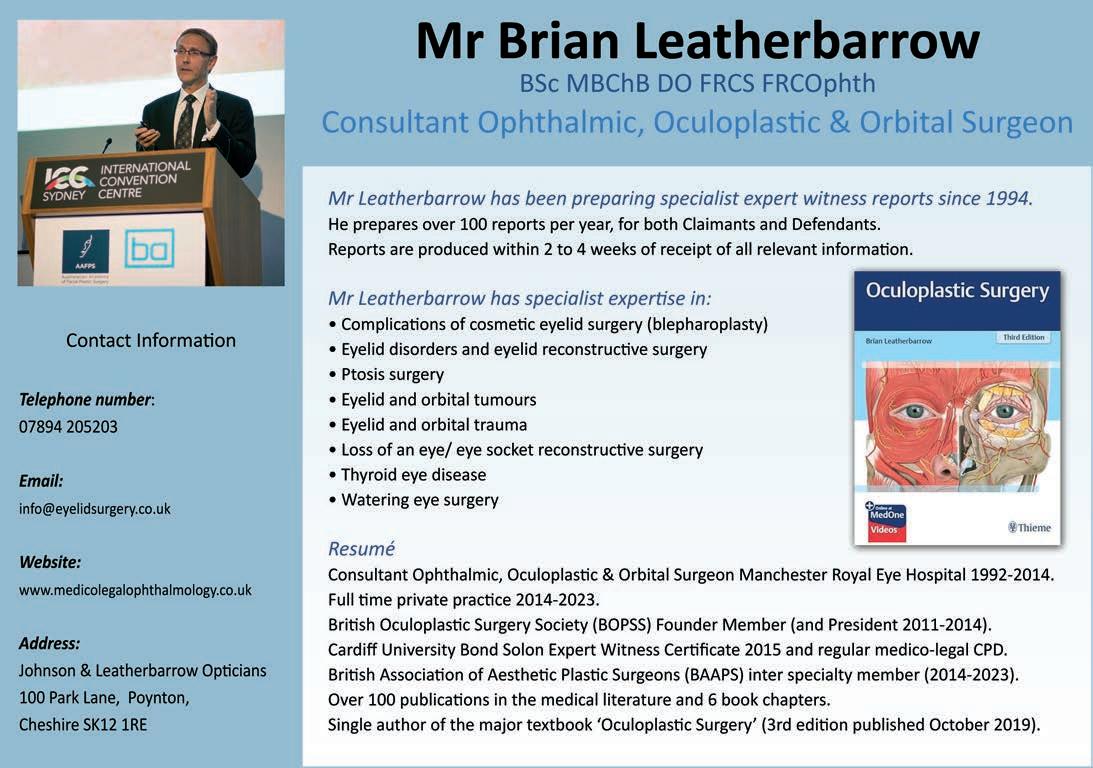
[LAUNCHED ON 14 OCTOBER, the National Clinical Strategy for Ophthalmology presents a clinically-led case for a new model of eye care across Wales.
In the Foreword to the Executive Summary of the report, the president of the Royal College of Ophthalmologists (RCOphth), Professor Ben Burton, writes: “The diagnosis for Welsh ophthalmology services has never been clearer. More than one in 20 people across the country are waiting for an appointment, departments are struggling to fill consultant roles and archaic digital and physical infrastructure are creaking at the seams.
“Ophthalmology services are under pressure across the whole of the UK, but the situation in Wales is particularly alarming. Over the last decade, the number of people waiting for an ophthalmology appointment increased by 169% in Wales and – unlike in England or Scotland –there is no sign that waiting lists are starting to come down.
“If this were a patient in our clinics, we would urgently be planning a course of treatment to prevent their condition worsening and ultimately return them to full health. The same clearsighted evidence-led approach must now drive us towards the major reform we know is needed to improve eye care services in Wales for the long term.”
The Llwywdd, or leader in Wales, of the RCOphth, Rhianon Reynolds – who is also the
national clinical lead for ophthalmology in Wales and a consultant ophthalmologist at Aneurin Bevan University Health Board – led on the development of the strategy.
She commented: “Yes, it’s a strategy for Wales; but there are elements that are pertinent across the different nations of the UK as well, particularly in terms of centralising care and in recognising and widening awareness of patient needs. Everyone knows about cataracts but they don’t appreciate everything else ophthalmology is, and so we tried to get across in the strategy that ophthalmology is not just cataracts.
“Another common issue is looking at driving the multi-disciplinary team forward, which I think Wales does very well and I think the other nations could learn from. There are recommendations in the strategy around MDT working.”
She highlighted 10 key facts about the strategy.
• It’s a blueprint for the sustainable future
• provision of ophthalmology services across
• Wales.
• The patient is central to the existence of
• ophthalmology services and central to the
• reasons they need to change.
• A government-commissioned independent
• report from an international expert on
• ophthalmic service design and delivery in
• 2021 (the Pyott report) highlighted several
• issues within secondary care services that
• needed further investigation and investment.
• Developing the new strategy involved
• identifying current points of failure and
• barriers to change that are contributing to the
• problems within secondary care
• ophthalmology across Wales.
• It also involved wide consultation with
• stakeholders. Everyone who took part was
• able to discuss their concerns and offer
• solutions in a protected open and supportive
• environment.
• There is an urgent need to address workforce
• shortages and recruitment challenges across
• Wales, and to increase training places.
• Every ophthalmology unit in Wales has
• outgrown its physical space.
• The solution involves focusing on four
• key themes: Clinical Networks, Pathway
• Transformation, Organisational Reform and
• A Sustainable Delivery Model.
• Collaborative working with the whole multi
• disciplinary team will be key to the strategy’s
• success.
• Delivering the strategy requires the support
• and leadership of the Welsh Government to
• mandate change, and the executives of
• health boards to commit to an entirely
• different way of working. Without that the plan
• will fail.
The full strategy document and the executive summary are available to download at executive.nhs.wales q
By Ms Pratibha Kumar Veeramani MBBS, MMedEd, FRCOphth, consultant ophthalmologist at Surrey and Sussex Healthcare NHS Trust
[ ONE OF THE CONSEQUENCES of modern postgraduate medical training is that each consultant has taken their own individual path to complete the rigorous requirements to qualify as a specialist in their area.
For me, as a consultant ophthalmologist specialising in medical retina, uveitis and cataract surgery, I knew early on that I wanted to get involved in medico-legal work as it complements my clinical work in a way that combines interests I have developed along my journey.
I have always enjoyed critical analysis of subject matters, have developed interests in patient safety and improving clinical pathways as well as medical education, and enjoy taking time to ponder over complex situations. I have found report-writing courses and learning procedural rules immensely helpful in developing my own framework for writing expert witness reports.
A turning point came for me soon after I had started expert witness work and attended the Medico-Legal Symposium run by the Royal College of Ophthalmologists. It was a wonderful opportunity to spend time discussing all aspects of litigation, clinical errors, and the role of the expert witness within the field of ophthalmology. It was there that I first met Professor Charles Claoué and learned about Eye Law Chambers (ELC).
Joining ELC early in my consultant career has opened a door

to a supportive network of eye specialists and given me the opportunity to contribute to and learn from a collective wealth of clinical and medico-legal experience across all the sub-specialties within ophthalmology.
ELC offers clients and solicitors a comprehensive and wellstructured service committed to the highest standards, whereby clients ultimately benefit from the expertise of the specialist best suited to their individual case. While each individual report produced is the opinion of the chosen expert alone, it can be supported by a panel of specialists.
Mentoring is a unique service within ELC, whereby new experts can benefit from the guidance of those most experienced. I have found this extremely valuable and hope to pay this forward in years to come as more consultants enter the arena of expert witness work.
Postgraduate training in ophthalmology continues to evolve, with a new curriculum introduced earlier this year which focuses more on sub-speciality and less on generalist knowledge.
As specialists of the future will continue to be highly trained in their chosen clinical sub-specialties, this strength of working as a team within a group of experts will become increasingly important. q
• For further information visit www.eyelawchambers.com


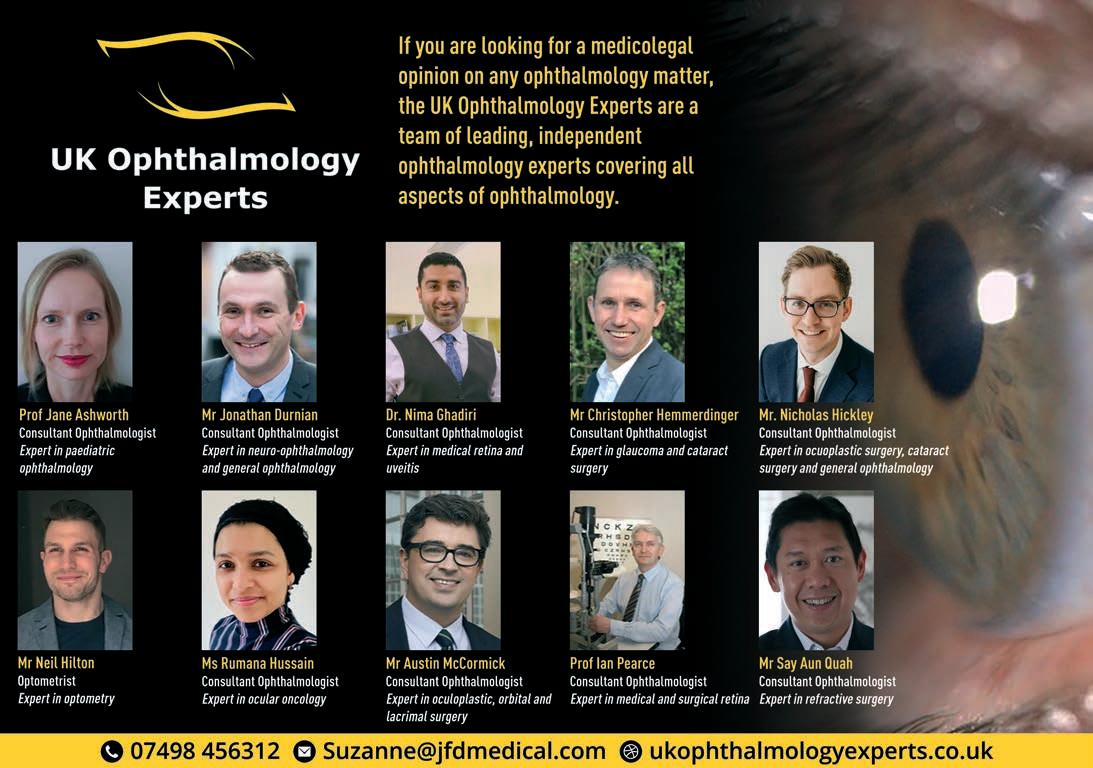
cDESPITE DIABETES affecting millions of the UK general public, many are unaware of the significant impact the condition can have on their own eye health. Ahead of Diabetes Awareness Month in November, eye surgery experts Optical Express shed light on the potential dangers diabetes poses to the eyes and shared expert insight on how those affected by diabetes can protect their vision.
Studies show diabetes is linked to various eye conditions, including cataracts, glaucoma and retinal changes known as retinopathy. The cause of the conditions is high blood sugar levels, which can damage blood vessels in the retina, in turn leading to vision impairment and, in severe cases, even blindness.
Research conducted by Optical Express has revealed that diabetic retinopathy is the leading cause of vision loss in adults under the age of 75 years, and if left untreated can result in irreversible damage to the eye.
Diabetic patients are advised to take a number of steps to protect their eyesight, including maintaining blood sugar levels within a

[ THE COLLEGE OF OPTOMETRISTS was invited to provide evidence at the Parliamentary hearing on The Safer Phones Bill, a Private Member’s Bill aimed at protecting children’s rights and wellbeing in the digital age.
Daniel Hardiman-McCartney MBE FCOptom represented the profession, addressing MPs and Peers on the potential impact of excessive smartphone use on children’s vision and possible links to myopia. He emphasised the importance of outdoor time for healthy visual development and for reducing the risk of myopic onset.
The Bill has gained cross-party support, along with backing from healthcare professionals, educators and parents. Daniel also joined other healthcare professionals in calling on the Chief Medical Officers of the UK nations to conduct an updated evidence review.
That is so they can provide public health advice to parents on managing children’s screen and social media use, including guidance on vision and myopia risk reduction. If passed, the Bill could establish new standards for promoting healthier digital habits. q

target range as high blood sugar can permanently damage blood vessels in the retina.
Frequent eye exams, ideally at least once a year, are also vital for early detection of eye conditions. Routine eye check-ups allow optometrists to monitor for subtle changes in eye health – often before symptoms appear – which enables timely interventions to be made that can prevent potential vision loss.
High blood pressure and elevated cholesterol levels can also exacerbate diabetic eye conditions by placing extra strain on blood vessels in the eyes. Diabetic patients should work closely with their healthcare providers to keep these levels in check.
Stephen Hannan, clinical services director at Optical Express, explained: “Diabetes can have a profound impact on eye health, often leading to severe conditions if not managed effectively. The most concerning aspect is that many diabetic eye conditions, like diabetic retinopathy, can develop silently and progress without noticeable symptoms, especially in the early stages.
“At Optical Express we want to raise awareness and encourage preventative measures, as the earlier the detection the more effective the action we as eye specialists can take to reduce the impact of any condition. By controlling blood sugar levels and monitoring blood pressure and cholesterol, diabetic patients can help protect their vision.” q
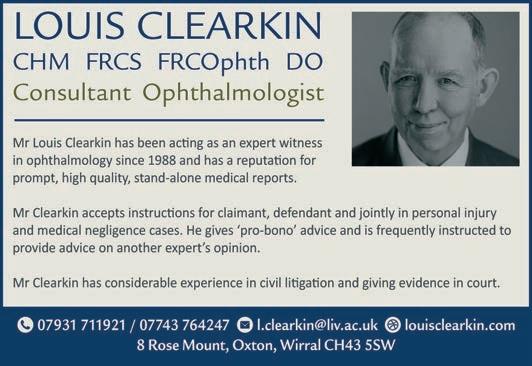



[THE DEATH OF 33-year-old Alice Webb on 24 September following a non-surgical so-called ‘liquid Brazilian Butt Lift’ procedure in Gloucestershire prompted extensive responses from the main professional bodies representing the legitimate plastic surgery specialties. It also resulted in two arrests and a ruling by the Coroner that further investigation was needed before the cause of her death can be ascertained.
The British Association of Aesthetic Plastic Surgeons (BAAPS) describes the Brazilian Butt Lift (BBL) thus: “While the term originally referred to buttock augmentation using fat transfer, it is now more broadly used to include buttock augmentation using dermal fillers such as hyaluronic acid and poly-L-lactic acid fillers and biostimulators. Dermal filler buttock augmentation is also called the liquid BBL.”
The BAAPS is clear about the risks such a procedure carries: “The injection of sometimes very large amounts of substance into an area of complex anatomy poses significant risks and requires the appropriate specific skills, knowledge and practical training uniquely pertaining to specialist plastic surgeons.”
The association has long campaigned for the regulation of the use of fillers. Currently there is no requirement in law for such procedures to be carried out by trained medical or healthcare persons. It also campaigns for improved safety in the carrying out of the BBL procedure using fat transfer and has recommended that its members do not perform the procedure.
The BAAPS says: “The government and the public must understand that these procedures are invasive, surgical in nature, and carry significant risks. They must also understand that these procedures should only be performed by those who are adequately qualified and trained to do so and in settings where complications can be treated should they occur – ie CQC regulated medical clinics and hospitals rather than beauty clinics, hotel rooms and private homes.
“They must understand the dangers of ordering cheap fillers online through unlicensed providers. We have some of the laxest regulations (or lack of regulation) in the world in this regard. We find ourselves therefore in the situation where invasive devices, often containing a substance with medical use such as local anaesthetic, are being inserted in the body in unlicensed premises by non GMC registered individuals – in fact, individuals lacking even the basics of any healthcare qualification of any description, let alone a medical degree.”
Further revelations came with a BBC exposé in November of a socalled ‘academy’ teaching cosmetic procedures. Responding to the File on 4 programme, the British Association of Plastic, Reconstructive and Aesthetic Surgeons (BAPRAS) said in a statement: “The British Association of Plastic, Reconstructive and Aesthetic Surgeons, as the national body for plastic and reconstructive surgery, is gravely concerned by the human stories of pain, suffering and loss of life that have emerged in the press. We wish to express our sympathy for those affected.
“As professionals with 10 years or more of training, often including higher research and fellowships, our members work to improve the lives of adults and children suffering from cancers, congenital abnormalities, burns, trauma and appearance concerns. Within the NHS and private
healthcare systems our members bridge the spectrum from cosmetic enhancement through functional restitution to life-saving and lifeenhancing care.
“The British public deserves access to safe, professional and regulated surgical care. British patients should be able to expect honesty, professionalism and the benefits of care from specialist, regulated professionals, and we work towards that goal.
“We strongly advocate for stricter regulation of the cosmetic surgery industry and urge patients considering any surgical procedure to verify their practitioner's credentials and medical qualifications. BAPRAS remains committed to maintaining the highest standards of patient care and surgical excellence in both reconstructive and aesthetic surgery.”
The campaigns by the BAAPS, BAPRAS and other organisations have resulted in a recognition by government of the issue and proposals for legislation to regulate the industry. However, surgeons’ bodies do not believe the proposals go far enough.
BAAPS says: “Some of these deficiencies are being addressed. A consultation on a licensing scheme for non-surgical cosmetic procedures by the Department of Health and Social Care, advocating a three tier system categorising procedures according to risks – dermal fillers being included in the highest risk category – has now closed.
The Joint Council of Cosmetic Practitioners, supported by BAAPS and the Royal Colleges of Surgeons, published this month a set of guidances aimed at environmental health officers for buttock augmentation and other body augmentation procedures, emphasising the surgical nature of these procedures and the requirement for the procedures to be limited to doctors with specialist surgical qualifications and knowledge within CQC regulated premises.
“Regarding fillers themselves, before Brexit occurred the UK had actively participated in shaping the new tightened European Medical Device Regulation, including the new Annex XVI category of devices without a medical purpose, which includes dermal fillers; after diverging from it, the UK is now considering an approach for UK regulations that will broadly mirror the EU model.
“The BAAPS feels that, with regard to BBL, all these do not go far enough. The specific risks pertaining to injection into the buttock, from wound problems to often life-threatening injuries, mandate a knowledge of anatomy and a facility with ultrasound use to support injection into the right subcutaneous layer of these often large amounts of substance, in addition to knowledge of the safe dosage and effects of local anaesthetics, appropriate tissue handling competency as well as the ability to recognise and treat early signs of sepsis and other complications.
“These capabilities lie usually within the strict domain of specialist plastic surgeons, who are regularly assessed through on-going appraisal and training in the UK. There also needs to be stronger prosecution of those non-qualified individuals who inject unregulated substances in the buttocks.
“Finally, we commend the work of environmental health officers and reinforce the need for prosecution of unregulated non CQC registered clinics in which BBL procedures are carried out.” q


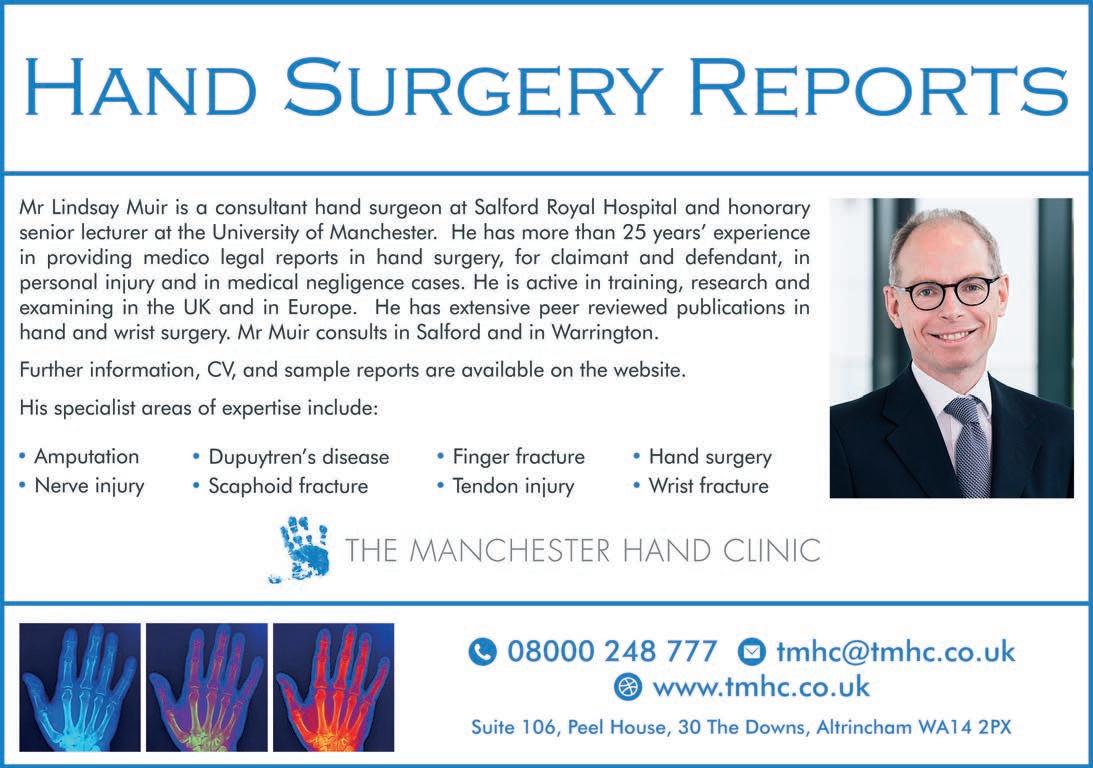
[ A STUDY PRESENTED TO the British Association of Aesthetic Plastic Surgeons (BAAPS) has uncovered that over 50% of individuals who travel abroad for cosmetic surgery end up regretting their decision.
The study, which won the BAAPS Hackett Memorial Prize 2024, delves into a decade of patient experiences at a UK tertiary plastic surgery unit, shedding light on the consequences of the growing trend of cosmetic tourism.
The retrospective study reviewed data from 103 patients referred to the plastic surgery unit from 2012 to 2022 with complications arising from procedures performed overseas. Patients participated in a telephone survey to share their experiences, with 48% responding. The findings underscore the hidden costs and potential risks of bargain procedures abroad, with Turkey emerging as a prominent destination.
Key findings:
• Cost as a deciding factor : 83% of respondents cited the lower cost
• as the primary reason for choosing surgery abroad, with 57%
• paying less than £5,000 for the entire process, including surgery,
• travel and accommodation.
• Regret among patients: Alarmingly, 66% of respondents stated they
• would not have made the same decision if given a second chance,
• with nearly half expressing outright regret.
• Top procedures and common complications: The most popular
• surgeries included abdominoplasty (28.1%), breast augmentation
• (17%) and liposuction (13.1%). The complications most frequently
• encountered included wound issues (33%), seroma (29.1%) and
• infection-related complications.
BAAPS president Nora Nugent emphasised the importance of educating the public: "This research offers crucial insights that must inform future public health campaigns. Potential patients need to understand the risks involved with traveling abroad for cosmetic surgery, beyond just the financial savings."
Theodore Pezas, the Niall Kirkpatrick BAAPS/BAPRAS Aesthetic
ON 24 OCTOBER the British Association of Plastic, Reconstructive and Aesthetic Surgeons made available online the BAPRAS Collection Virtual Museum at www.baprascollection.co.uk
The BAPRAS Collection is a nationally important archive, but the association has no physical space in which to display the artefacts, documents, artworks and books detailing the history of British plastic surgery. It has therefore created a ‘virtual’ space for the collection. It is arranged in themed galleries, off corridors on two floors, designed to be viewed best on devices larger than a smartphone. Clicking in each space opens further spaces exploring different aspects of BAPRAS’s story.
Launching the new facility, BAPRAS said: “The galleries are incomplete. Most content is currently within the Art Gallery, BAPRAS and Sidcup rooms. We hope that you can see the direction of travel and that it will stimulate members wanting to contribute towards this organically growing project. Hopefully it will expand into a significant resource through which both professionals and the public will discover fascinating insights into the true nature of our specialty.”
Anyone can get involved, contributors being recognised at the bottom of any page they have had input to. Any comments, suggestions and historical corrections are welcomed. q

Fellow 2023 and winner of the Hackett Prize 2024 for the study, affirmed: “The purpose of this study was to better understand the patient experience of the process of cosmetic tourism in cases where surgery has resulted in complications requiring emergency management.
“While no surgery is risk-free and the majority of qualified plastic surgeons performing cosmetic surgery abroad do so to a very high standard, which is often comparable to the UK, what is not always comparable is the way in which certain procedures are offered and regulated. The practice of cosmetic tourism may seem like a cheap alternative, but can facilitate an inadequate provision of post-operative care which leaves patients worse off and comes at a cost to us all.”
The findings serve as a wake-up call to the dangers lurking behind the allure of cosmetic tourism, urging potential patients to weigh their options carefully and consider the full impact on their health and well-being. q
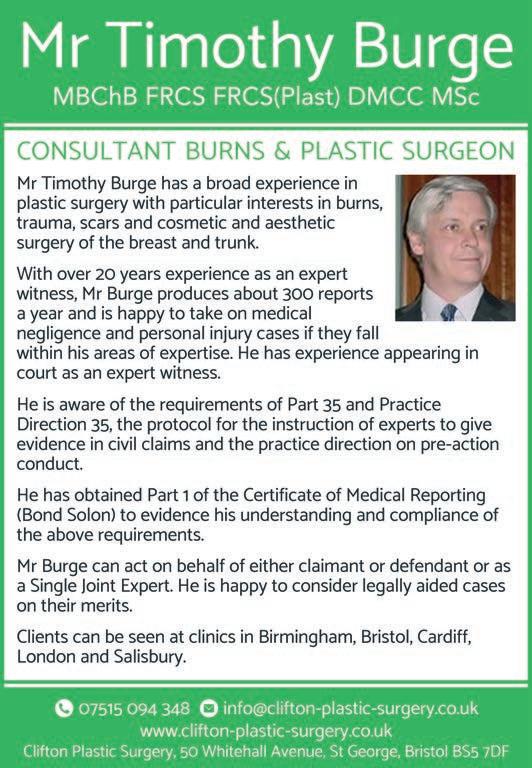

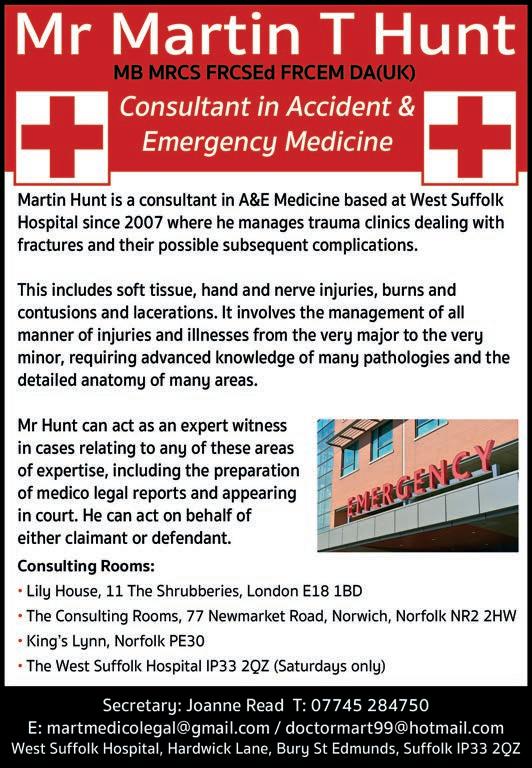

[ALMOST NINE OUT OF 10 UK A&E clinicians who responded to a survey by the Royal College of Emergency Medicine (RCEM) said they aren’t confident that their departments will cope well this winter: and shockingly, 94% think that patients are being put at risk due to the pressures currently being experienced.
The RCEM conducted the poll between 7-13 November, asking department clinical leads – the doctors responsible for patient safety in A&Es – a series of questions aimed at capturing a snapshot of the current state of overcrowding and the standard of care patients are receiving in their hospitals.
In total, representatives from 83 hospitals across England, Northern Ireland, Scotland and Wales, responded. The results revealed that:
• 87% of respondents said they aren’t confident that their department
• will cope well this winter
• 83% of respondents had patients being cared for in corridors
• 51% of respondents had patients being cared for in ambulances
• outside their A&E department
• 94% said they feel patients are coming to harm because of
• conditions
Only one in 10 respondents (11%) said they felt better prepared this winter than they did last year.
The news came just weeks after the Chancellor delivered her Budget, which failed to include any additional support to mitigate the looming winter crisis A&E departments are facing – and just days after the performance figures for A&Es in England indicated they are heading for another winter crisis.
President of RCEM, Dr Adrian Boyle, said: “This is a stark warning from those on the front line. Clinicians are worried and patients are unsafe. Winter is coming and it looks like we are facing a massive crisis in every part of the UK. We cannot just ignore winter and our patients.
“Our patients, each one vulnerable and sick in need of care and comfort; each one someone’s mum, dad, gran or grandad, condemned to degrading and dehumanising so called ‘corridor care’. This euphemism, in reality, means people being stranded for hours on trolleys or chairs. And as every hour ticks by, the associated risk of those people dying as a result increases.
“We speak of percentages and numbers; but let’s remember we are talking about people, and a workforce running on fumes trying to do their best.
“All this with the backdrop of a government telling them they need to work harder and more effectively, but which has not invested any more resources for these winter months.
“In the Budget there was nothing to address or ease the pressures in A&Es this winter; no increase in bed numbers, no added support for social care which could keep people out of hospital in the first place or allow them to leave when they are well enough.
“The government may have written off winter, but we haven’t. We will keep highlighting the harm, and what should be done to eradicate it, and holding them to account for the avoidable and unacceptable risk our patients are being exposed to.”
Just a week earlier, the RCEM published data showing that, in England in October, 162,931 patients waited 12 hours or more in major A&E departments: an increase of 33,919 from the previous month. That equates to more than one in every 10 patients who attended.
The data also shows that, for the same kind of A&Es, only 58% of patients were transferred, admitted or discharged within the target of four hours: the national standard is currently 78% and was previously 95%.
The number of people attending has also increased and was the highest ever recorded for the month of October - standing at more than 1.4 million.

Dr Adrian Boyle added: “These figures will strike yet more dread into the hearts of emergency clinicians. They are yet another clear indicator of the winter crisis, which is looking even more inevitable.
“The huge spike in the number of people being forced to endure stays in A&Es of more than 12 hours is deeply concerning. Long waits are not just inconvenient or uncomfortable; they are dangerous. To be blunt, they put people’s lives at risk.
“Our members and their colleagues are exhausted and frustrated. This week 96% of trust leaders surveyed admitted they are worried about the effect of winter pressures, and we are sure our members share concern in similar numbers. Patients are at risk; clinicians and managers are sounding the alarm; something must be done.” q

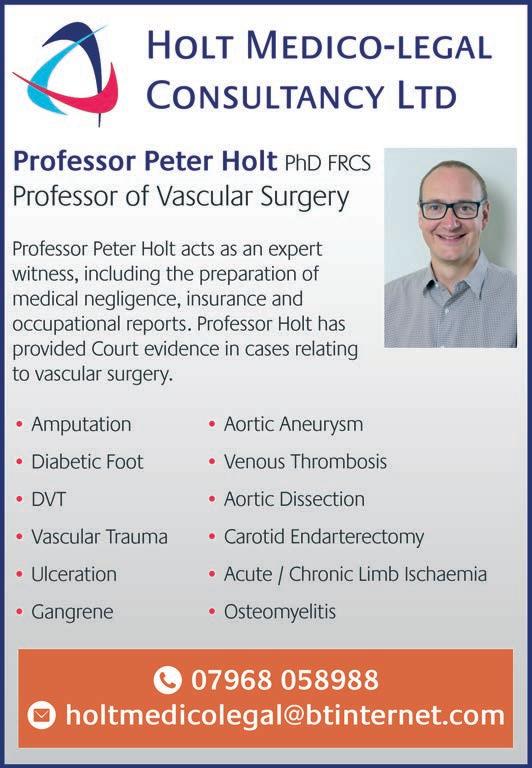

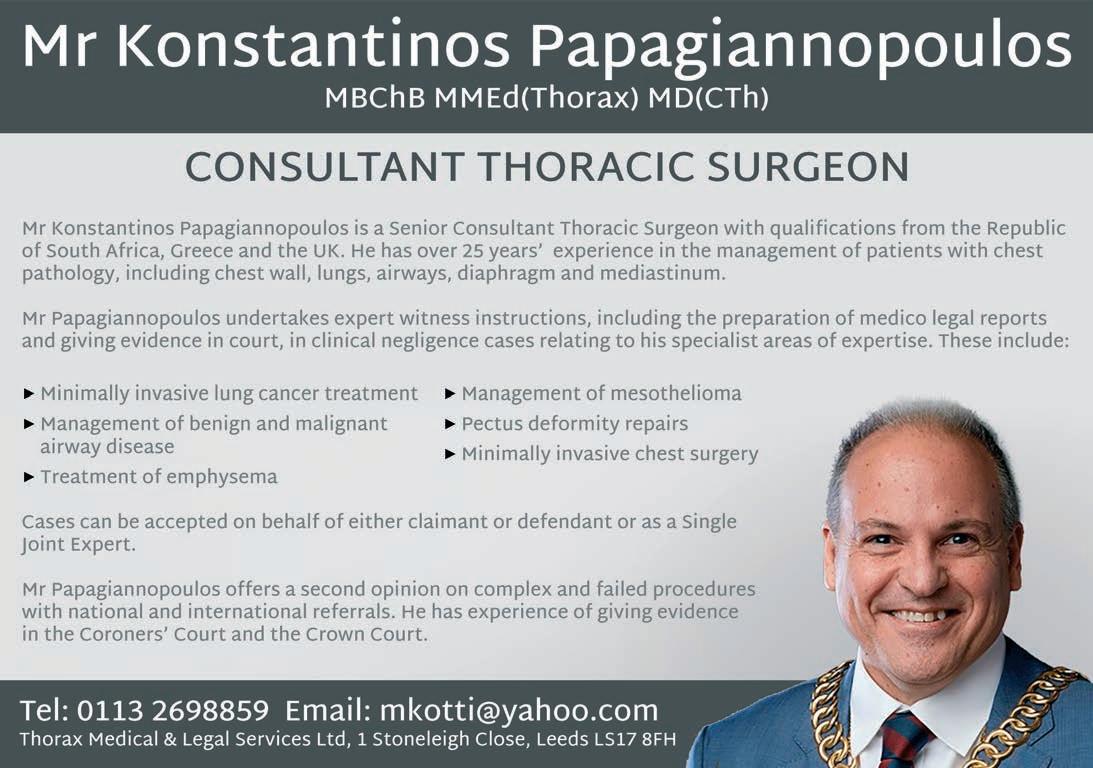
By Philip Coleridge Smith DM MA BCh FRCS, Consultant Vascular Surgeon, Medical Director of the British
Emeritus Reader in Surgery at
[THE ARM DEPENDS on a blood supply delivered from inside the chest where the great vessels supply large branches to the arms, head and neck. The veins from the arm return to the chest alongside the arteries to reach the superior vena cava which takes blood back to the heart. The nerves to the arm emerge from the cervical spine and pass downwards in the neck to run alongside the blood vessels.
The route taken by the arteries and veins passes out of the chest and over the first rib, running beneath the clavicle to reach the arm. The nerves join the blood vessels and also pass under the clavicle to reach the arm.
This route protects these important structures but does result in them passing via a small aperture between the first rib and the clavicle. Where this opening is narrowed or distorted the blood vessels and nerves may become compressed.
Three separate syndromes are recognised: arterial, venous and neurogenic thoracic outlet syndrome. These conditions may arise following injury, from iatrogenic causes as well as spontaneously. Claimants developing arm complications following major injury may develop a thoracic outlet syndrome.
Venous thoracic outlet syndrome was originally described in body builders and athletes, more commonly in men but women may also be affected. Young adults are often affected. The condition is sometimes known as ‘effort thrombosis’ or eponymously as ‘Paget Schroetter Syndrome’. It is thought to develop as the result of compression of the subclavian vein as it passes under the clavicle.
General causes of thrombosis, such as inherited conditions leading to thrombosis and the oral contraceptive pill, may also be factors.
Iatrogenic causes of subclavian vein thrombosis are common these days. It arises from the use of central venous catheters in intensive care units.
Medical School
and other endovascular treatments. The initial problem causing the venous thrombosis was the reduced opening between the first rib and the clavicle. This can be opened by excising the first rib which is effective in the venous, arterial and neurological types of thoracic outlet syndrome. In cases of blocked subclavian veins and arteries, reconstruction of the blocked vessel is recommended by many authors. In preference, this is done using the patient’s own vein taken from elsewhere in the body.
Clinical series, but not randomised clinical trials, have been published in which these methods of management have been evaluated. All show advantages in skilled hands. However, potential defendants are likely to point out that detailed evidence of the efficacy of these treatments has not been published and a wide range of clinical practice is considered to be acceptable in vascular surgical practice. This is likely to lead to difficulty with any claimant’s Liability and Causation cases.
These treatments will often restore normal function to blocked veins. In patients with venous thrombosis, anticoagulant treatment alone will leave many subclavian veins permanently occluded. That may lead to persistent swelling of the arm, aching and discomfort when using the arm. Collateral venous drainage may develop around the shoulder and prominent veins may appear over the chest (pictured below).

This was a common problem arising during the COVID-19 pandemic since the infection is also a strong risk factor for thrombosis. Treatment of patients with cancer often necessitate injections via a central venous catheter. The combination of cancer and the catheters may lead to venous thrombosis. The subclavian vein is a common route by which central venous catheters reach large veins near the heart.
Acute venous thrombosis in the upper limb veins presents as a swelling of the arm combined with dusky discolouration due to venous congestion. The venous obstruction is readily seen on ultrasound imaging, as is the case with DVTs arising in the lower limb.
In general, anticoagulant treatment with heparin or modern oral anticoagulants is recommended as the first line treatment for upper limb venous thrombosis. No detailed guidelines for management are available which makes litigation in this condition much more difficult. In general, it would be considered substandard practice to manage an upper limb thrombosis without anticoagulant treatment. However, other options include the use of thrombectomy catheters
Some patients develop change in the shape of the chest as the shoulders begin to droop in early middle age and this can lead to the spontaneous compression of the nerves in the subclavian region. Injuries to the chest, such as fractures of the ribs or clavicle, can lead to development of compression of the nerves as they pass beneath the clavicle. There is usually an interval of a few months between the injury and onset of symptoms. The patient finds that they have aching in the arm, pins and needles and pain which usually affects the hand. Some patients develop colour changes in the hand which may become purple at times due to damage to the nerves which control the circulation to the upper limb. Symptoms from this condition can be very troublesome, leading to substantial disability. This condition is investigated with nerve conduction studies as well as ultrasound imaging of the vascular system. Injections of local anaesthetic into the region of the nerves of the neck will usually relieve symptoms and give an indication of the likely outcome of removing the first rib to decompress the nerves to the arm.
Patients who undergo this treatment early in its evolution, after a few months, often experience substantial relief from their symptoms. Many patients can resume their previous occupations. Where symptoms have been present for many years, the outcome of treatment is less certain.
Thoracic outlet syndromes are uncommon but may be the result of iatrogenic causes as well as from injuries sustained in accidents. Appropriate investigation and surgical treatment will lead to a reduction or abolition of symptoms in many patients if treated in a timely manner. q
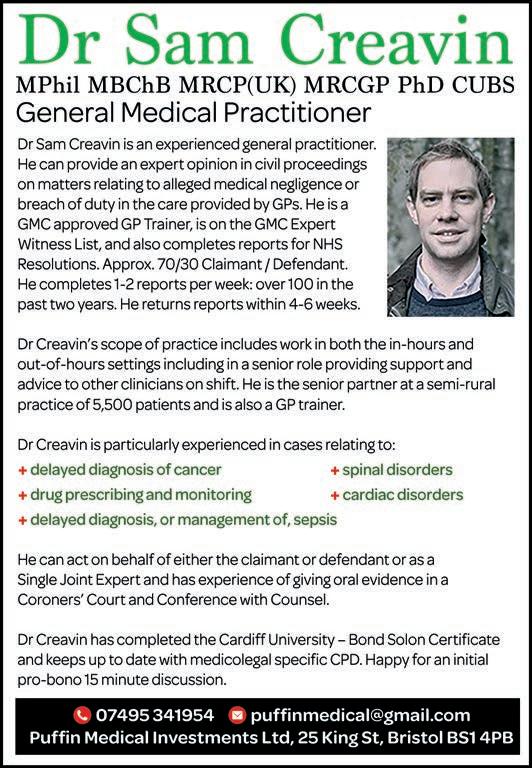

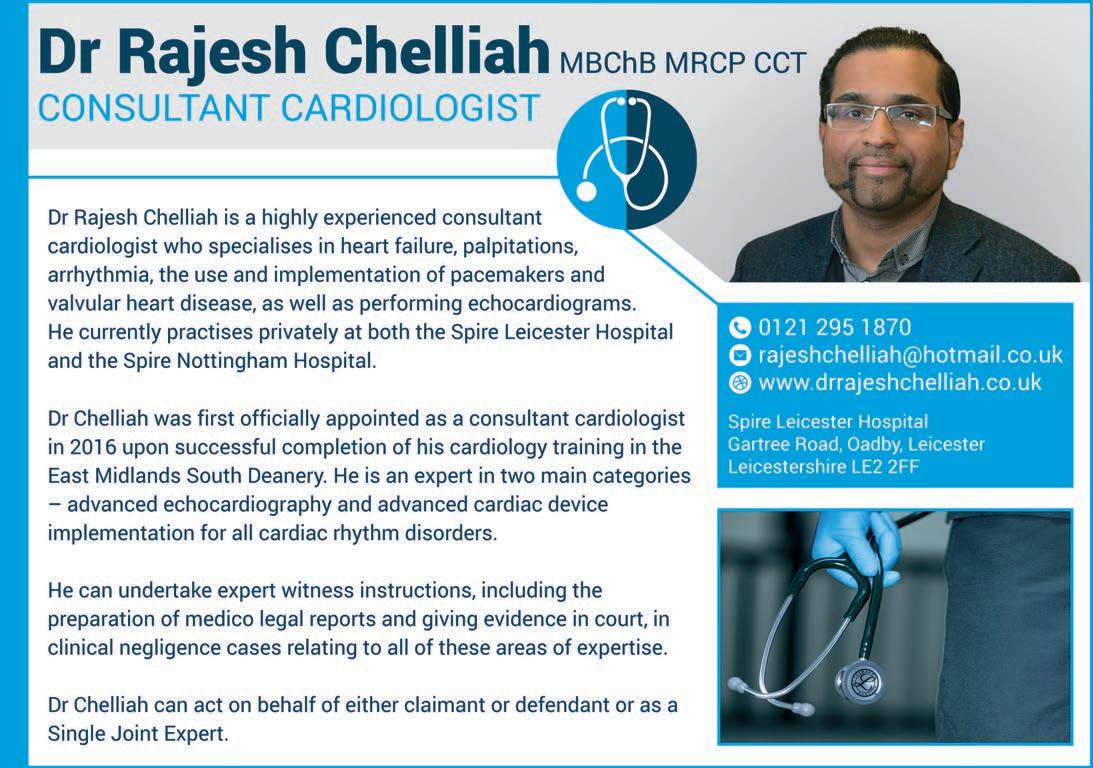
[ THE National Audit Office (NAO) is recommending a review of how NHS Health Checks are provided in England to help prevent cases of cardiovascular disease (CVD) that affects millions of people and costs the economy tens of billions of pounds each year.
NHS Health Checks help to spot cases of CVD and prevent loss of life and money by tackling the disease, but not enough people are offered or receive checks. They were introduced in 2009 with the aim of saving lives and money by helping people to tackle CVD when it is not identified through primary care.
Everyone aged 40-74 who does not have a pre-existing heart condition is eligible for a Health Check once every five years.
The NAO has found that the current system to make sure that eligible people in England are offered and attend Health Checks isn’t working effectively.

The independent public spending watchdog highlighted that, in 2013, responsibility for commissioning Health Checks was transferred from the NHS to local authorities, as part of the transfer of responsibility for elements of public health. That created a statutory requirement on local authorities to offer Health Checks to all eligible individuals over a fiveyear period.
In 2023-24 the level of Health Checks had recovered, postCOVID, to 1.42 million checks completed. However, only 3% of local authorities delivered a Health Check to all of the annual eligible population in their areas in 2023-24 and less than half of the eligible population attended a check.
The legislation transferring responsibility for Health Checks to local authorities did not provide the Department of Health and Social Care with levers to influence local authorities’ performance. In turn, local authorities weren’t able to require general practices or other providers to deliver Health Checks, instead relying on voluntary agreements.
Problems further arise with local authorities unable to routinely access practice data to monitor the Health Check programme and see whether checks are delivered to those most at risk. There is also concern among primary care professionals about general practices’ capacity to conduct Health Checks: between 2014-15 and 2023-24 the amount local authorities spent on individual Health Checks fell in real terms from £56 to £43 per check.
The Public Health Grant, used by local authorities to fund Health Checks and other health services, was reduced in real terms from
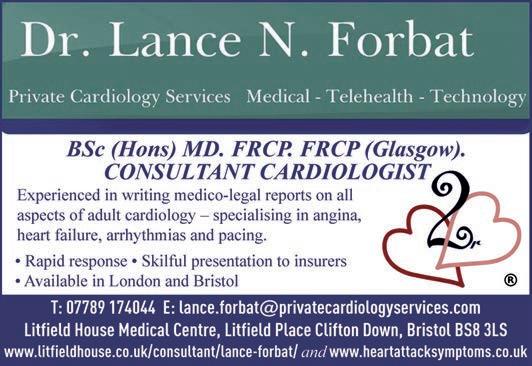
£4.48bn in 2015-16 to £3.53 bn in 202324: a 21% decline. Over the same period local authority spending on stopping smoking, obesity and physical activity decreased by 23% in real terms: from £340m to £262m.
The NAO is recommending the Department for Health and Social Care considers improvements in several areas, including:
• Assessing whether local authorities are best placed to deliver Health Checks
• Incentivising delivery of Health Checks to people at highest risk of CVD to help mitigate health inequalities and reduce potential longer-term costs falling on the NHS in the future
• Setting clear targets for the numbers or percentages of the eligible population who should attend Health Checks, so they are attended and not just offered
Gareth Davies, head of the NAO, declared: “Each year thousands of lives are lost to cardiovascular disease, with billions of pounds spent tackling it. Health Checks can play a crucial role in bringing these numbers down, but the system isn’t working effectively, resulting in not enough people having checks. This is an unsatisfactory basis for delivering an important public health intervention.
“The Department of Health and Social Care needs to address the weaknesses in the current system for targeting and delivering Health Checks if it is to achieve the preventative effect it wants.” q

[
WOMEN IN THE UK – and elsewhere – are still missing out on vital treatment for their number one killer, cardiovascular disease: despite significant progress in the medical management of heart disease and stroke. That was the conclusion of a consensus statement published online in the journal Heart
Women continue to be underdiagnosed, undertreated and underrepresented in clinical trials in all areas of cardiovascular disease, says the statement. Among other things, it calls for dedicated women’s heart champions and heart hubs, plus a women’s health strategy to stop the needless death toll from what is essentially a preventable disease.
The consensus statement was drawn up by representatives from UK cardiovascular, nursing and patient bodies affiliated to the British Cardiovascular Society, with the aim of addressing unmet needs, ensuring parity of care and improving the health outcomes of women with cardiovascular disease in the UK and worldwide.
Conventional cardiovascular disease risk factors, such as high blood pressure and
high cholesterol, are often not treated as promptly or as appropriately as they are in men, despite accounting for around half of all preventable cardiovascular disease deaths, says the statement.
And women face particular cultural, societal and financial issues, which magnify their heart disease risks, as well as enduring the influence of hormones, pregnancy and the menopause across their lifespan.
And their biology, physiology and body shape not only affect their risks of cardiovascular disease, but also the effectiveness of diagnostic procedures and treatment.
Healthcare professionals and the public mistakenly believe that women’s risk of cardiovascular disease is lower than men’s, according to the statement.
“Myths and unconscious biases within clinical practices and societal perceptions further obscure the reality that heart disease does not discriminate by sex.”
And all-too-often women’s voices are unheard and their heart symptoms aren’t taken seriously enough.
The statement sets out a series of
actions for clinicians and their professional bodies in each of the major cardiovascular disease areas: coronary artery disease, valvular disease, heart failure, inherited heart disease, congenital heart defects and heart rhythm disorders.
Professor André Ng, president of the British Cardiovascular Society, commented:
“The joint British Cardiovascular Societies’ consensus document is the first to comprehensively detail the many layers of inequalities that exist in relation to cardiovascular disease in women, who clearly need better access to early and accurate diagnosis and timely treatment. Raising awareness across the medical profession, to patients and the general public, is an important first step.
“The British Cardiovascular Society will work with our affiliated societies in all areas of cardiology as well as other stakeholders, including patient organisations and NHS leaders, to identify key work packages that will bring transformative change to improve care and achieve better outcomes for cardiovascular care in female patients.” q
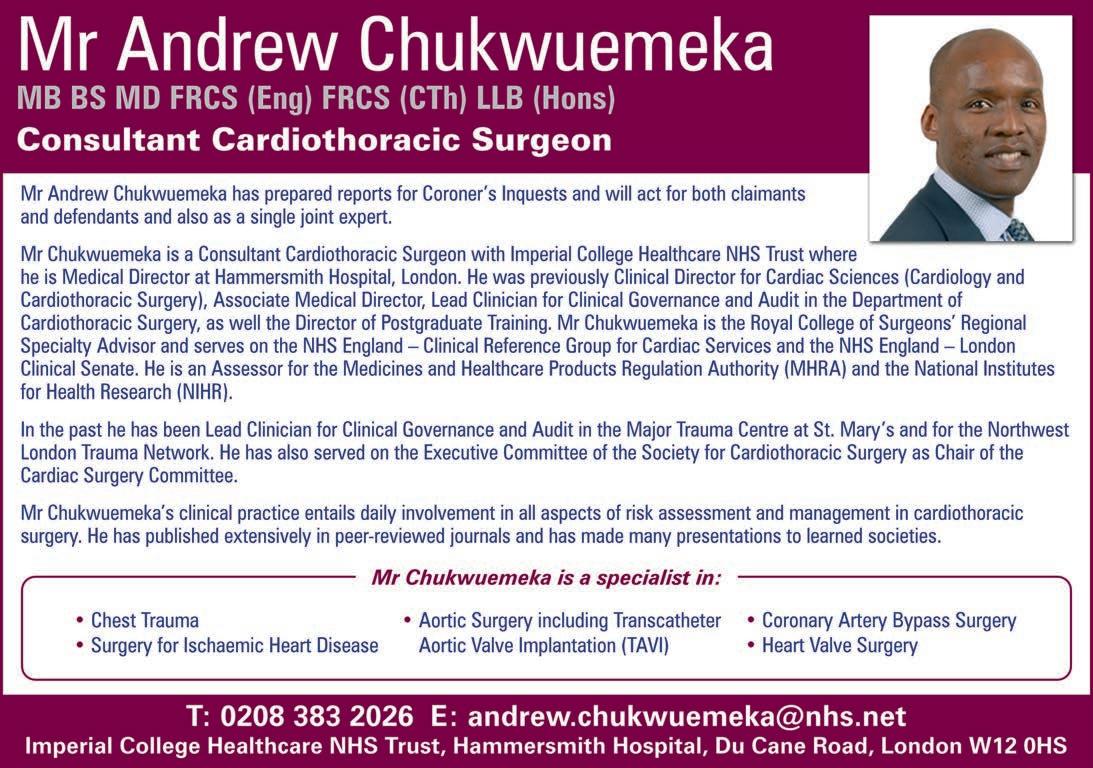
EXPERTS FOR MEDIA is a regular section in Your Expert Witness for experts who wish to offer their views and the benefit of their experience to the vast range of print and broadcast media.
Ever wondered how news teams find the experts they consult to explain the ramifications of breaking news stories, seemingly at the drop of a hat? Or how the producers of TV drama series ensure their stories are accurate and reflect the realities of the professions they portray?
The fact is that researchers consult registers of experts and expert periodicals just as lawyers do. In fact, Your Expert Witness is receiving an increasing number of enquiries from media researchers and public relations agencies looking to locate appropriate experts to inform their clients.
Experts for Media is therefore an ideal space to attract their attention. For prices and to book your space, contact Ian on 0161 710 3880 or via ian@dmmonline.co.uk
Mr Francis Michael Brooks BSc MBBS MD FRCS Consultant Orthopaedic Spinal Surgeon
Mr Brooks is experienced in the treatment of all degenerative adult spinal conditions as well as trauma and tumour. He undertakes instructions relating to personal injury claims in general orthopaedic, spinal and trauma injuries on behalf of either claimant or defendant.
T: 07732 989991
E: brooks.francis@gmail.com / spinalreports@gmail.com
Joanne Caffrey Expert Witness & Trainer
Ms Joanne Caffrey undertakes expert witness instructions in cases relating to the following police topics:
• Use of force
• Custody procedures
• Drink/drug driving
• Ligature deaths
T: 07528 800 720 E: joanne_caffrey@sky.com
Mr Robert Hensher FRCS FDSRCS Consultant Oral and Maxillofacial Surgeon
Mr Hensher’s subspeciality interests include dental implantology, facial injury and temporomandibular joint replacement. He prepares over 50 reports yearly including negligence and criminal cases.
E: jackiesorrell0101@gmail.com M: 07947445414
E: roberthensher@gmail.com M: 07836540457


Laird Assessors Automotive Expert
Laird Assessors are the UK’s leading independent automotive expert witness firm supporting claimant, defendant and criminal solicitors – from instruction to court. Laird provide intelligence to the automotive world predominantly relating to crashed vehicles.

T: 0151 342 9961 E: enquiries@laird-assessors.com
W: www.laird-assessors.com

Chris Makin FCA FCMI FAE QDR MCIArb
Chartered Accountant • Accredited Civil Mediator • Accredited Expert Determiner
Chris Makin was one of the first chartered accountants to become an Accredited Forensic Accountant and Expert Witness. He is also an accredited civil and commercial mediator and an accredited expert determiner. Over the last 30 years he has given expert evidence at least 100 times and worked on a vast range of cases.
T: 01924 495888 or 07887 660072 E: chris@chrismakin.co.uk
W: www.chrismakin.co.uk

Mr Luke Meleagros BSc MBBS MD FRCS Consultant Surgeon
Mr Meleagros completes around 6-10 expert reports per month, the majority in medical negligence cases and a smaller number of personal injury cases. He has reported extensively on cases involving abdominal laparoscopy surgery and hernia surgery.
T: 0208 527 0977 E: L.Meleagros@btinternet.com Sec: jawdobson@gmail.com

Target Psychology Ltd
Providing Expert Witness Reports and Assessments
Target Psychology provide exceptional reports and their highly trained team of expert psychologists and psychiatrists regularly take instructions from solicitors and local authorities, providing assessments for families and individuals involved in legal proceedings.
T: 0161 425 1826 E: office@targetpsychology.co.uk
W: www.targetpsychology.co.uk




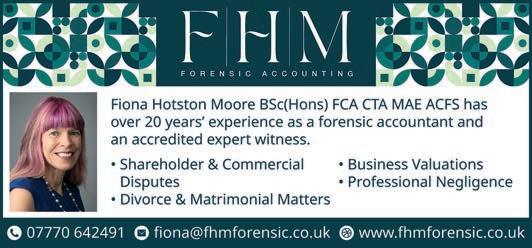
















COLLISION INVESTIGATION & RECONSTRUCTION

COMPLIANCE CONSULTANTS

COMPUTER & MOBILE FORENSICS



DIGITAL TECHNOLOGY



EMPLOYMENT

ENERGY CONSULTANTS

ENGINEERS

EQUESTRIANS

ERGONOMICS

FINANCIAL SERVICES





GEOTECHNICAL CONSULTANTS

INSURANCE

MECHANICAL & PROCESS ENGINEERING




RISK MANAGEMENT










ACCIDENT & EMERGENCY MEDICINE






CARDIOLOGISTS & CARDIOTHORACIC SURGEONS
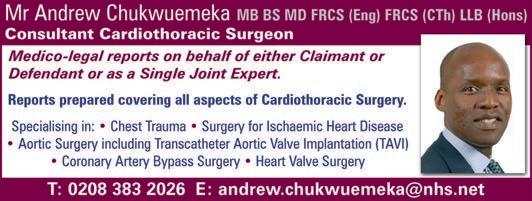
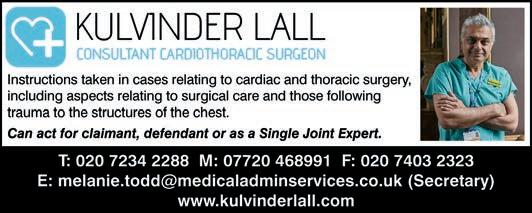





ENDOCRINOLOGY

ENT CONSULTANTS


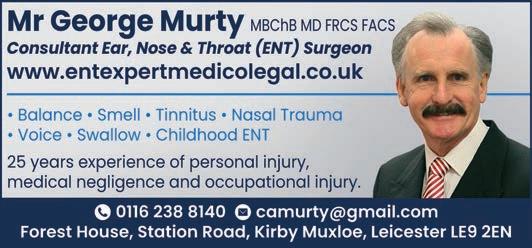


GASTROINTESTINAL & COLORECTAL SURGEONS

GENERAL SURGEONS




HAEMATOLOGY


INTENSIVE CARE MEDICINE

MEDICAL NEGLIGENCE
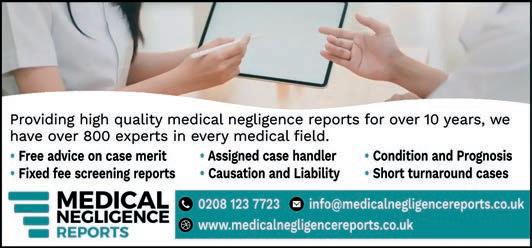
MICROPIGMENTATION

NEONATAL MEDICINE

NEUROLOGY

NEUROSURGEONS



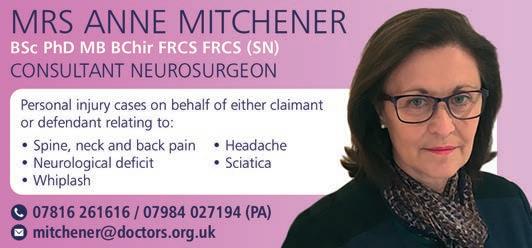




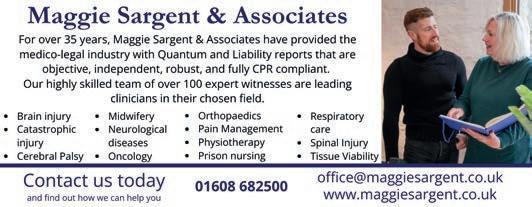
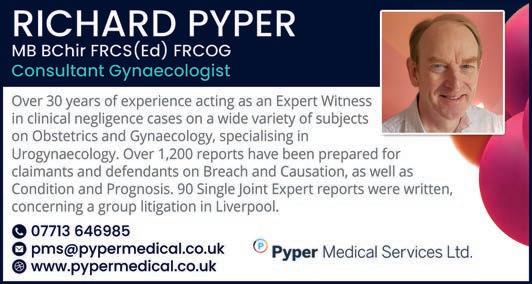

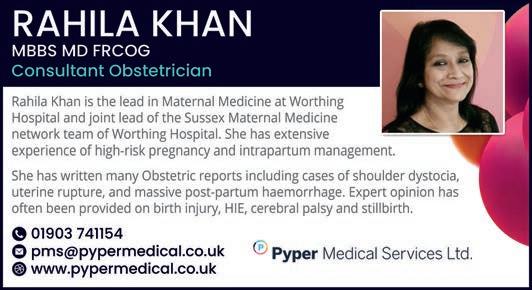



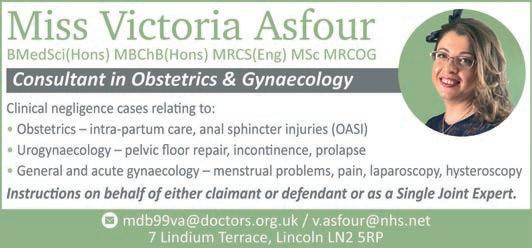
OCCUPATIONAL MEDICINE & THERAPY
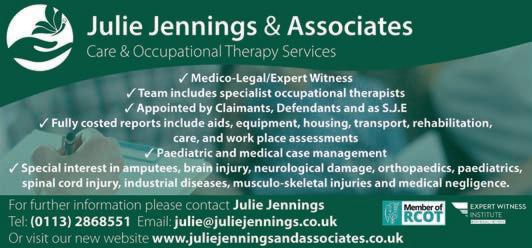
ONCOLOGISTS
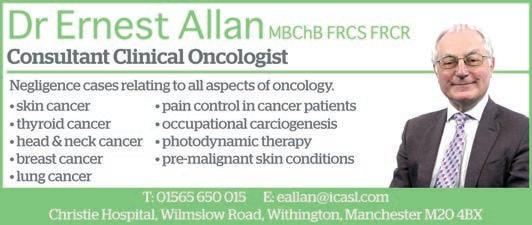
OPHTHALMIC SURGEONS
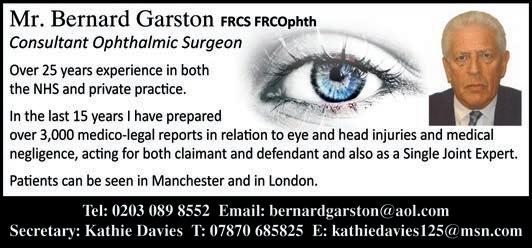





ORAL & MAXILLOFACIAL SURGEONS

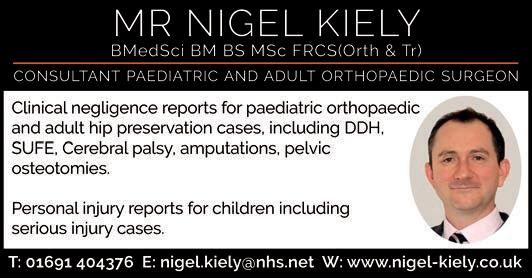

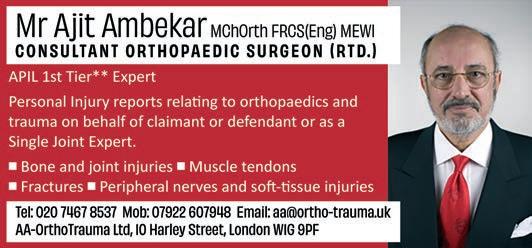










ORTHOTICS

OSTEOPATHS

PAEDIATRICIANS


PATHOLOGY

PHARMACOLOGY


PHYSICIANS
















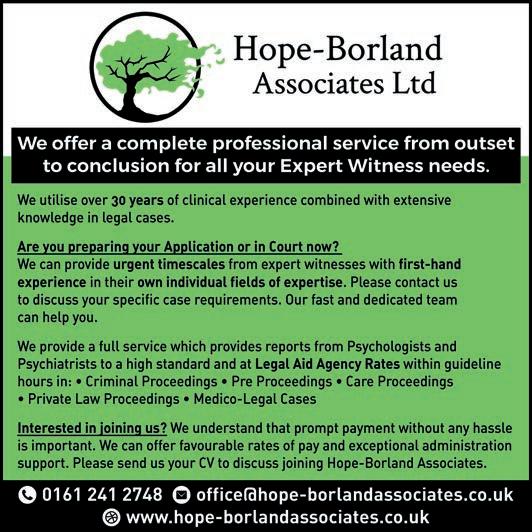




RADIOLOGISTS

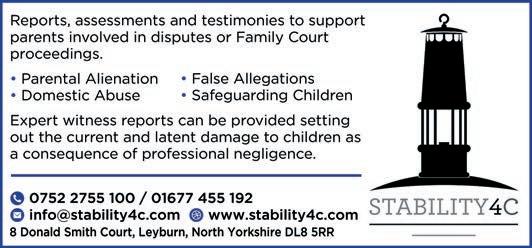
SKIN CAMOUFLAGE CONSULTANTS

SPEECH & LANGUAGE THERAPY
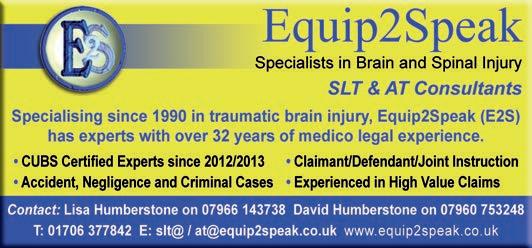




TRICHOLOGISTS

TOXICOLOGY




